




























































































EDITOR
editor@farmingmonthly.com
EDITORIAL ENQUIRIES
editorial@farmingmonthly.com
ADVERTISING ENQUIRIES
Tel: +44 (0) 2476 353537
ADVERTISING DIRECTOR
Shona Beedham
shona@farmingmonthly.com
ACCOUNT EXECUTIVE
Jennifer Mills
jennifer.mills@farmingmonthly.com
ACCOUNT EXECUTIVE
Vicky Smith
vicky.smith@farmingmonthly.com
SUBSCRIPTIONS
subscriptions@farmingmonthly.com
PRODUCTION production@farmingmonthly.com
Front cover credit: Subaru UK






For editorial, general enquiries or to advertise please call +44 (0) 2476 353537 or email sales@farmingmonthly.com
Farming Monthly National is published monthly in the UK by Farming Monthly Ltd, Tel: +44 (0) 2476 353537 Printed in the UK
No part of this magazine may be reproduced without permission from the publisher.
Whilst every attempt is made to ensure accuracy, the opinions expressed in the magazine are not necessarily those of the Editor or publication. The Editor also reserves the right to alter or edit material as required and no responsibility is accepted for inaccuracies.
Full copyright applies. All rights reserved. ISSN 2044-0190 (print) ISSN 2044-0200 (digital)





Scotland’s leading agricultural organisation, RHASS (Royal Highland & Agricultural Society of Scotland), has launched a job search for an accomplished leader to step into the role of Chief Executive.
The newly appointed person will play a pivotal role in shaping the organisation's strategic direction, delivering growth and ensuring strong financial stability and governance.
Working collaboratively with the board of trustees and employees to achieve the charity’s mission of continuing to advance Scottish agriculture and support the country’s rural communities, the new appointee will also oversee the charity’s operations, finances, stakeholder relationships, and program development to ensure impactful and sustainable results.
A cornerstone of RHASS’ work is the Royal Highland Show which is hosted annually at the Royal Highland Centre (RHC) and is the primary fundraising event for the charity. As well as being one of Scotland’s most sought-after venues within the country’s vibrant event sector, RHC plays a crucial role in supporting the work that RHASS does. The venue welcomes over one million visitors
a year and hosted over 150 events in 2024.
James Logan, Chair of RHASS, said: “This is a tremendously exciting opportunity for the right person who is looking to help shape the future strategic direction of the organisation both commercially and in advancing the work RHASS does to ensure a lasting legacy for the sector.
“We’re looking for someone who has substantial experience in a similar role within a multi-faceted commercial organisation and where having overarching responsibility for the organisation and group’s compliance with all legal, regulatory, and financial requirements, comes second nature. While experience within the agricultural or rural sector could be advantageous, it’s certainly not essential”.
“We have a very proud history at RHASS and so we’re really looking forward to welcoming someone into the team who can help drive innovation and help forge exciting opportunities for the future for the charity, our staff, our members and the sector.”
Applications for the chief executive role are now open, with applications being accepted until 26th February 2025. For more information about the role and to apply please send a covering letter and CV to hr@rhass.org.uk
Farmers are being called on to join a new paid research programme that will help improve their farm practices while also shaping the UK’s carbon footprint strategy.
The Land Use To Net Zero Greenhouse Gas Accounting Project (LUNZ Footprint) research programme is being run by the Cool Farm Alliance (CFA) and the University of Gloucestershire and aims to make it simpler for farmers to measure and reduce their carbon footprint.
Farmers are now urgently needed to join the initial trial and will be expected to complete two greenhouse gas footprint measurements over two years with the support of the Cool Farm Alliance. By taking part, farmers will be able to benchmark their farm and get insights and guidance on how to make improvements and find efficiencies.
The LUNZ project is being led by Eleanor Durrant from Cool Farm Alliance who said: “We already have a number of farmers involved in the project,
but we urgently need more.
This paid trial will bring a wealth of benefits to each farm involved but, by participating, you’ll be contributing to shaping the future of farming and the environment, whilst learning more about the tools available to understand your farm’s GHG footprint.”
Farmers will be paid £200 + VAT per year for taking part in the LUNZ programme and will be expected to complete two greenhouse gas footprints with support, a short online survey, a 45-minute interview and attend two online workshops. Some participants may also be approached for farm visits.
Eleanor adds: “This is a great opportunity for farmers to engage with experts and fellow likeminded farmers to share best practices and find ways to improve their farm. Most importantly, this will help put farmers at the heart of decision-making as the UK shapes its future carbon strategy.”
The Farmers’ Union of Wales (FUW) President, Ian Rickman, will meet UK Government Treasury officials in London on Tuesday 18 February to discuss the farming sector’s concerns over changes to inheritance tax.
The meeting, held alongside other UK farming unions, follows lobbying by the FUW against the far-reaching changes to Agricultural Property Relief (APR) and Business Property Relief (BPR), including corresponding with Prime Minister Keir Starmer, and responding to the Welsh Affairs Committee’s call for evidence on the impact of the recent budget.

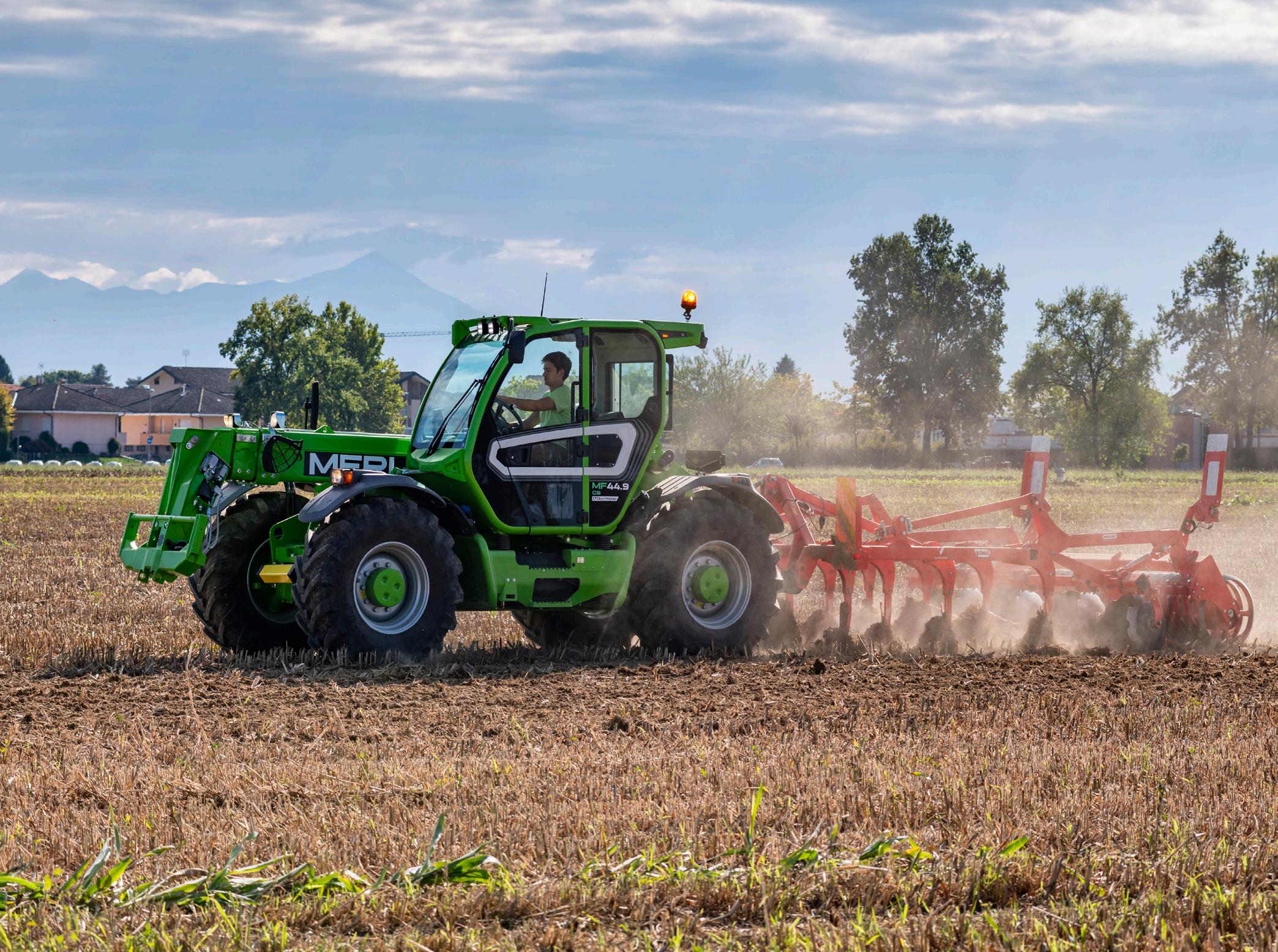




The devastating impacts on farming families and the nation’s food security from the family farm tax sit squarely on government’s shoulders, the NFU said today, after ministers bluntly refused any suggestion of a compromise offered by farming unions and organisations.
The stark warning comes after Exchequer Secretary James Murray and Food Security Minister Daniel Zeichner called in representatives from across the farming sector including the TFA (Tenant Farmers Association), CLA (Country Land and Business Association) and CAAV (Central Association of Agricultural Valuers), and the wider UK farming unions, only to tell them the government had no interest in compromise.
Speaking after the meeting, NFU President Tom Bradshaw said:“Disappointed doesn’t cover how I feel after this meeting. Today, we have repeated our concerns about the impact on farming families; they don’t care. On the impact on families who can’t afford vast tax bills coming their way on the death of a loved one; they don’t care. On the elderly – the most vulnerable people in our farming community – who feel they are now a burden on their family; they don’t care.
“This morally bankrupt position sits with this government, and, without change, ministers will reap the consequences.
“For the 70 million people living on these islands, food security matters. It matters more given the ever-increasing geopolitical uncertainty. While this is shocking for me to say, the only conclusion I can come to is this government doesn’t care about British food production. Is this the same government which in its manifesto said food security is national security?
“We went into this meeting fully understanding the fiscal hole this government must plug, and we went into this meeting to offer a solution, a solution which has been suggested by other tax experts where the inheritance tax policy is based on a claw back mechanism.
“Put simply, farmers don’t get money when they inherit, they get the farm, the business asset, and often the debt. Any money they do get, they get when they sell. So, our suggestion is based on that premise.Our suggestion, which is almost revenue neutral meaning the Chancellor gets her planned income, is that if an inherited farm is sold then inheritance tax gets paid. Crucially, this would allow
family farms that want to continue to produce the nation’s food to do so, while giving the Treasury what it wants.
“We also need to be clear, the current talk that the £500 million this generates, which will be raised on the backs of hard-working and hard-pressed farmers, will rescue the NHS is nonsense. This amount will fund the NHS for a day. It’s disingenuous for ministers to repeat this untruth.
“Despite the Chancellor calling for alternatives, and today the UK food sector went collectively to share those, I am hugely disappointed there was no response from Treasury today, no acknowledgement that this could be done better. This is the same Treasury department which admits it has not yet carried out impact assessments on its current policy. Let’s remember, this policy has now been challenged by farming unions and agriculture representatives from across the UK, it has been challenged by the independent Office of Budget Responsibility, by the Efra Select Committee, by tax advisors to the government, and recently the National Preparedness Committee has reminded us that UK food security is in a precarious state.
“And every single major food retailer in the UK has also called for change. Why? Because they can see what this will do to the security of the supply of their products.
“This is a mess, but there is still time for Treasury to review. I urge them to look at the proposal put to them by all the major farming organisations today. It will raise the money needed. It is a way forward which is fair, removes the huge risk to British agriculture, including significant emotional and financial pressures, and delivers for UK food security, something the government continues to insist is a priority.
“I want to thank NFU members for their continued support and I thank the public who continue to stand by British farming, with 275,000 people signing our petition. Thank you to those backbenchers who have come out to support their rural constituencies and thank you to those political parties which have pledged to dump this awful policy if they’re elected. From what we are told, the Chancellor has refused even to meet with her own worried MPs on this issue.
“Heads in the sand, fingers in ears, zero empathy. What a way for a government to behave.”
“We’re not very happy with it”
Wales’ First Minister, Eluned Morgan MS has repeated concerns voiced by the Farmers’ Union of Wales (FUW) over changes to future funding support rules for Welsh agriculture.
Her comments came as she was questioned by Welsh MPs during a session of Westminster’s Welsh Affairs Committee on Wednesday 12 February 2025.
As part of the session Henry Tufnell, Member of Parliament for Mid & South Pembrokeshire, questioned the First Minister on her thoughts regarding the UK Government’s decision to move towards a Barnett formula-based allocation of agricultural funding for Wales, rather than a needs-based formula that has previously been the case.
Responding to Mr Tufnell’s question, the First Minister claimed the Welsh Government were “not very happy” with the announcement, noting that “it is a huge concern that that has been changed."
see Wales’ proportion of total UK agricultural funding fall drastically from around 9% to 5%.
The Farmers’ Union of Wales has previously warned such ‘Barnettisation’ of agricultural funding could equate to a drop of around 40% in funding for Welsh farming - a cut of around £150m a year.

The First Minister said Wales has a higher proportion of farmers than other parts of the UK and the new funding formula ”will not recognise that" going forward.
Previously, EU funding for UK agriculture was allocated across the UK nations under the Common Agricultural Policy (CAP) formula, based on rural and farming criteria such as the size, number and nature of farms. This resulted in 9.4% of the total UK agriculture budget coming to Wales when we were members of the EU.
The UK Treasury’s decision in October 2024 to ‘Barnettise’ the block grant for each devolved nation, a calculation based on population rather than farm and rural characteristics, could however
Responding to the First Minister’s comments, Ian Rickman, Farmers’ Union of Wales President said: “We welcome the First Minister’s comments, and her concern regarding the significant consequences Barnettisation could have on future farm funding here in Wales.
The FUW has long warned this change in funding fails to recognise the unique characteristics and needs of Wales' farms - and the move towards a population based model could see a drastic fall in Welsh farming's funding from over 9% of the UK's allocation to 5%.
At a time when Welsh farmers are expected to deliver an ever increasing range of sustainability and environmental objectives, while also producing food, there should be a return to the previous allocation formula which better served the needs of the sector here in Wales.”

At the half-way point of the current four-year programme, Monitor Farm Scotland has drawn together progress, statistics and feedback in a comprehensive midpoint review. It includes updates from all nine Monitor Farms across Scotland and their plans for the next two years.
So far, the nine Scottish Monitor Farms have connected over 1,000 farmers and covered more than 60 topics. These include succession planning, financial performance, biodiversity, nutrition management, and livestock systems, helping to drive innovation and resilience in Scottish agriculture. The programme has developed collaborative partnerships with 58 organisations, ranging from farmers and agribusinesses to research institutions and vets, demonstrating the power of knowledge exchange to enhance skills and communication

across the supply chain.
In the first two years, 48 meetings which are open to all have been held, each attracting an average of 54 attendees; an average of 48% of attendees were under 45 and 27% female. The initiative has held a total of 136 meetings including regular management group meetings for each of the Monitor Farms.
Recent surveys have provided additional proof of the programme’s popularity and positive influence:
• 99% of farmers plan to attend future meetings
• 87% report improved technical knowledge
• 78% say it will improve business decisionmaking
• 90% of management group members say it has strengthened local collaboration and communication
Beth Alexander, Monitor Farm Scotland programme manager says: “Since launching at AgriScot in November 2022, we have seen thousands of people in farming and agribusiness in person at our events, viewing our online updates and reading our press reports and technical articles.

“It has been fantastic to be part of the in-depth discussions at the nine Monitor Farms and see how each of the businesses is adapting and changing as a result. Our meetings allow for constructive discussions and provide a platform for Monitor Farmers to share realworld insights, supported by data, while influencing policy and public perceptions of farming.
“It offers a supportive, business-focused network that helps shift perspectives and drives change. Few initiatives provide such a unique platform for genuine collaboration, sharing challenges and opportunities for growth in the farming sector.”
The initiative, which has been extended by a year from previous programmes, is fully funded by the Scottish Government’s Knowledge Transfer and Innovation Fund. Guided by its ethos of being ‘Farmer-Led, Farmer-Driven’, it promotes solutions-based thinking shared across the agricultural sector. It is managed by Quality Meat Scotland (QMS) with support from Agriculture and Horticulture Development Board (AHDB and is delivered by a programme manager and three regional advisers.
The Monitor Farm programme’s remaining two years will focus on ensuring farming businesses are sustainable, not just technically but financially.
Beth adds: “While farming is a way of life, it must also function as a business. Many Monitor Farms have gained significant financial insights through the ‘Farmer-Led, Farmer-Driven’ approach, boosting confidence for farmers and their management groups to identify and address business challenges.
“Technology will also play a role, with trials exploring virtual fencing, cow collars, and high-tech boluses to monitor suckler cow

health. Additionally, the programme is expanding its digital reach with more videos and a new podcast, ensuring farmers across Scotland have access to tools and insights for business and technical sustainability.”
• The Monitor Farm Scotland Programme 2022-2026 Midpoint Review can be seen here: https://www.monitorfarms.co.uk/ monitor-farm-scotland-programme-reachesmid-way-milestone/
• The Monitor Farms are located in Argyll, Banff and Buchan, Deeside, Dumfriesshire, East Lothian, Roxburghshire, South Ayrshire, Stirlingshire and Strathspey.

Familiar figure in the British farming industry and a trustee on the board of The Institute For Agriculture and Horticulture has become the latest guest to feature in a new podcast series celebrating farming families across the UK.
Becci Berry was joined by her daughters Jaz and Martha on the second edition of Talking Crop, a podcast launched by Goodyear Farm Tires.
Becci runs a 365-ha mixed farm on the Oxfordshire/ Wiltshire borders, approximately 200-ha of which is tenanted from the National Trust.
Becci took Brimstone Farm on solely in 2010 after the passing of her husband Richard following a battle with bowel cancer.
Formerly a dairy farmer, she rears a herd of 200 native beef cattle - gaining several industry awards including the herd being runner up in the RADBF/NMR Gold Cup - and manages various arable operations.
On the arable side, the farm is in mixed rotation andsince selling the dairy herd three years ago -Becci has focused on introducing new environmental schemes. She said: "My background was in equestrian, horseracing, PR and hospitality and I was a partner in a business in those sectors so the thought of farming wasn't ever in my mind until I met Richard.
"It's a third generation farm and when Richard was in palliative care, we spoke a lot about what the future of the farm would be when he was no longer here.
"I was always determined to keep the farm going and I'm glad I did. When Richard passed away, it was a very difficult time but the farm was the constant for me and the girls and that has been extremely important. "The farming community is a really strong unit and the support they have shown over the years has been incredible."
Jaz and Martha are currently at university in Durham and Edinburgh respectively, but the sisters believe their long-term future belongs on the farm.
Martha said: "We have talked about the future a lot recently and we are pleased to be experiencing different things in life at the moment, but ultimately we want to come back to the farm.
"We feel very fortunate to have had the upbringing we did and we are constantly spreading the message to our friends about the importance of farming and those doing it.
"We both feel so comfortable when we come back here and really appreciate the farm and landscape it has created. So, long-term we both feel our future lies here."
Becci, Martha and Jaz are the second guests on Talking Crop after the series was launched by Wakefield duo Chad and Lucy Stevens who became farmers after being a police officer and beautician respectively.
The Talking Crop podcast is available on all major podcast platforms.

THE Devon County Agricultural Association (DCAA) is delighted to announce the appointment of Her Royal Highness,The Princess Royal as its President for 2025. The announcement was made during the annual meeting of members which took place on January 31st.
The DCAA, best known for its flagship event, The Devon County Show, is thrilled that Her Royal Highness has accepted to be the Association’s figurehead and President given The Princess Royal’s longstanding commitment to Food, Farming and the Countryside.
The Princess Royal is the only daughter of the late Queen Elizabeth II and sister to HM The King, who is patron of the Devon County Agricultural Association. Her Royal Highness not only runs her own farm and estate in Gloucestershire but was the first member of The Royal Family to compete in the Olympic Games when she rode The Queen’s horse, Goodwill, in the equestrian three-day event.
The Princess Royal succeeds Michael Caines MBE DL, the celebrated Michelin star chef, as President. Her Royal Highness will be supported in her year of office by Deputy President Roger Ellis. Roger, a fourth-generation farmer from Dunchideock, took over the family farm at the age of 18 following his father’s death.

Fortunately, The Devon County Show always provided Roger with a welcome distraction from the responsibilities and challenges he faced with the Farm
in the early days, in particular the hefty burden of death duties. His connection with this annual celebration of rural life in Devon spans an impressive sixty years, most recently serving as Chief Steward of the Horse section—an apt role given The Princess Royal’s equine interests and connections.

Commenting on his appointment, Roger said, “I am honoured to take up the Deputy Presidency and will greatly enjoy supporting The Princess Royal during her year as our President, particularly given our mutual passion for horses and rural life.
2025 also happens to be the year that my wife Mary and I celebrate our diamond wedding anniversary—60 years of marriage, which is quite a milestone. It’s going to be quite a year all around.”
The Devon County Show takes place on 15th, 16th, and 17th May. Tickets are available to purchase now atwww. devoncountyshow.co.uk

It's time to explore how we can elevate UK agri-tech to the next level,” says Dr Belinda Clarke, director of AgriTechE, ahead of Agri-TechE’s Challenge Convention event at NIAB, Cambridge on March 4th.
Despite a vibrant ecosystem, fed by world-class research and a forward-thinking farming industry, UK agri-tech still has untapped potential. Persistent challenges remain in scaling exciting technology for widespread on-farm adoption and commercial success.
“We want to find ways to build investor confidence, or devise new, creative ways of financing the innovation pipeline. That could also include things like public-private partnerships and a longer-term commitment to research programmes,” says Dr Clarke.
George Freeman MP, Chair of the All-Party Parliamentary Group on Science & Technology in Agriculture (APPG Ag Science) and a long-time champion of agri-tech, will provide the opening address for Challenging Convention.
In November 2024, through the Back to the Future project, the Agri-TechE community called for a fresh approach to the UK’s strategy for agri-tech. They highlighted the need for clear targets, a joined-up policy framework, and a stronger link between
research, technology, and on-farm productivity.
“Building on the findings from our Back to the Future project, our Challenge Convention event aims to bring together the expertise across the agritech community to literally ‘challenge the existing convention’ and agree on what needs fixing, changing, or delivering to unlock the untapped potential for UK agri-tech.
“We hope a discussion across the ecosystem will help identify what we need to do to be the preeminent location for agri-tech development,” continues Dr Clarke.
To do this, Challenge Convention will divide the industry into three dedicated sessions: farmers, researchers and tech developers, and investment and policy. Each segment will delve deeper into the particular areas where more can be achieved, aiming to provide a rounded view of how to move UK agri-tech forward.
“I am excited to see the outcomes. I hope it gives us a consensus of ambition that the industry can work towards fulfilling,” concludes Dr Clarke.
Challenge Convention will be held at NIAB Park Farm, Cambridge, on March 4thand is open to anyone interested in agri-tech research, development, adoption, and policy. To find out more and book a ticket, visit theAgri-TechE website.





leading North Yorkshire open-air attraction, Ryedale Folk Museum, has announced its latest exhibition, Farm / Mill / Bake. From Saturday 22 March, more than 50 stunning new photographs will go on display for the first time. It follows a special commission undertaken by celebrated documentary photographer, Tessa Bunney, renowned for her sensitive portrayals of rural and working life.
"The exhibition brings together the inspiring stories of farmers, millers, and bakers working to transform the way that bread is made across Yorkshire," explains Museum Director Jennifer Smith. "It's been a really exciting opportunity to work with Tessa to shine a light on these untold stories of sustainable bread production."

"Organic millers aim to preserve the integrity of the grains, producing less-refined flours," explains Jennifer. "Then, in the hands of organic bakers who are typically embracing slow-fermentation methods, these flours are transformed into nutritionally rich breads. The exhibition celebrates the shared commitment of a great many people, at every stage of production, who come together to create bread that promotes sustainability and good health. "Tessa's images focus on the work taking place in Yorkshire, but they also offer a small window into the passionate network of farmers, millers, and bakers striving to revive heritage grains and traditional baking techniques across the country."



The story begins on smallscale organic farms, where individuals are working quietly to cultivate resilient and nutrient-rich wheat varieties that can thrive within their differing microclimates. "Many of us are largely unaware of the work taking place each day," says Jennifer. "We really wanted Tessa to document these stories, with her blend of insightful, sympathetic photography."
The exhibition has been made possible through a grant from the Farming in Protected Landscapes fund, managed by the North York Moors National Park Authority. Inspiration was sparked after a conversation with Nelly Trevelyan of Yorkshire Organic Millers, based at Hill Top Farm in the heart of the North York Moors. Many of those featured in the exhibition are connected to the organisation, either growing wheat for their mill or using their organic flour.
Tessa's previous projects have often centred on land usage, including the relationship between land and people, and Farm / Mill / Bake has been "a dream commission" for the artist. Tessa explains: "I love projects where I don't know much at the start – I really enjoy the detective work. Bread production is such a complex process, and, as the project developed and I learnt more, I really wanted to do justice to the work that is done."
Tessa continues: "Everyone I photographed really opened their lives to me. They have all been innovating in their own ways, making small adjustments along the way, and bringing so much care and passion to something as seemingly simple as a loaf of bread."
Farm / Mill / Bake can be viewed for free in the art gallery at Ryedale Folk Museum until Monday 5 May.
The museum and art gallery are open from 10am to 4pm in March and 10am to 5pm in April and May, from Saturday to Thursday (closed Fridays). There is no charge for entry to the exhibition. For more information, visitRyedale Folk Museum.
Rootstock 2025, held last week at Westpoint, concluded with resounding success, welcoming 332 attendees and featuring a distinguished lineup of 15 speakers from across the UK including Scotland and Northern Ireland.
Rootstock is a unique event bringing together leading agricultural researchers with hands on farming practitioners to explore ways to enhance farm profitability in an increasingly challenging financial and environmental climate. Mel Bradley, Conference Organiser, expressed delight at the strong turnout and enthusiastic feedback from delegates, some of whom described it as ‘the best farming conference they had ever attended’.

Notable speakers included John Gilliland, who shared insights into the Arc Zero project in Northern Ireland and the AHDB pilot involving 170 UK farms in baselining soil carbon. East Devon farmer Sam Walker captivated the audience with his engaging journey into organic farming and profitability.
Minette Batters, former NFU President and cross-
bench peer, spoke at Rootstock for the first time in its three-year history. She commented, "My role was to provide the political context, addressing challenges like the changeover in government, the family farm tax, but also what Labour’s ambition is for farming. I love coming to Rootstock, it’s very farmer focused with a lot of practical discussion as well as an opportunity to catch up, with farmers coming from all over the South West. Farmers are part of the solution, but it does need others to step up on that journey.”

The conference concluded with a compelling address from Dr. Robin Jackson, who highlighted the growing momentum behind regenerative agriculture.
“There is a palpable air of genuine optimism, a shared understanding that regenerative agriculture, or smart farming, isn’t just a trend—it’s an absolute necessity. It’s not just about producing food; it’s about regenerating ecosystems, revitalising communities, and nourishing future generations.”
Plans for Rootstock 2026 are already being made, with tickets going on sale in the Autumn atwww. rootstock.ag
The Royal Highland and Agricultural Society of Scotland (RHASS) Presidential Initiative, headed up by President George Lyon, Vice Presidents; Margo McGill Scott, Andrew Malcolm, Rob Wainwright, Lord George Robertson and Chaplain Isabell Montgomerie, have announced a spectacular lineup of silent and live auction prizes ahead of their much-anticipated charity dinner to be held on the 21st March in the unique and impressive Donald Malcolm Heritage Centre in Linwood.

The event will raise vital funds that will be divided between RHASS partner charities; the Scottish Association of Young Farmers Clubs' (SAYFC) Big Build, the Royal Highland Education Trust (RHET), RSABI, and Farmstrong Scotland.

This year's Presidential Team, representing Strathclyde, has curated a unique selection of over 75 auction prizes designed to appeal to a wide audience, from luxury seekers to sports enthusiasts and those in the agricultural community. Among the standout prizes are:
• Luxury experiences: An exclusive helicopter ride, a four-ball at Gleneagles, a three ball at Turnberry with afternoon tea, overnight accommodation and a luxury car to drive there, and various luxury breaks across Scotland.
• Exclusive sports memorabilia: Signed football and rugby tops from Celtic, Rangers, and Glasgow Warriors – a musthave for passionate fans.

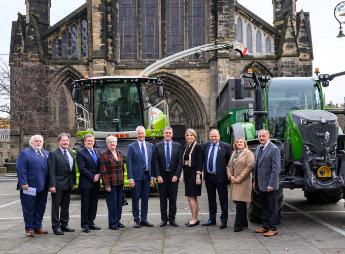
• Agricultural prizes: A vintage plough, straws of sexed semen from Worldwide Sires, and 18 doses of private semen from some of the most sought-after Texel rams in the UK and Texel embryos from Hugh Blackwood & Son.
• Whisky collectors’ dream: A Lagavulin 200th Anniversary, Single Cask Edition 1991 and distillery tour for 4 from Diageo, A cask of Kilchoman whisky,
George Lyon, RHASS President, expressed his enthusiasm for the event, stating:
“The Strathclyde Presidential Team has worked hard to bring together an incredible range of auction prizes that reflect the best of Scotland’s heritage, sport, and agriculture. I would like to personally thank our sponsors who have given so generously to the auction. We encourage everyone to head to the online auction site to place their bids and support our chosen charities, which carry out so much valuable work in our rural communities.”
Ewan Andrew President, Diageo Supply Chain & Procurement, one of the auction’s generous donors, also shared their excitement: “We are immensely proud to support the RHASS Presidential Initiative and its efforts to raise vital funds for such impactful charities. At Diageo, we are proud to support the communities in which we operate. This event not only showcases Scotland’s rich heritage and agricultural excellence but also highlights the importance of collaboration and community spirit. We are thrilled to contribute with our unique auction prize and look forward to seeing the positive difference this initiative will make."
The silent auction will be open for bids from Friday 21 February, allowing participants the opportunity to secure these exclusive prizes
while supporting various excellent causes. Bids will be placed confidentially via an online platform. At the close of the auction, the highest bid for each item will win, and the successful bidders will be notified. Bidding will close at 11pm on 21 March 2025. Bids for the live auction prizes can also be placed online and they will be used as the starting bid on the night.
The charity dinner, one of four high-profile events hosted by the Strathclyde Presidential Team, will be a key highlight in their year-long initiative, which will culminate at the 2025 Royal Highland Show.
The major sponsors of the dinner are Diageo, Dunbia Highland Meats, Parks Motor Group, Malcolm Group, and Loch Fyne. There are still a few tickets available for the dinner.
Throughout their tenure, the team has used its year as a platform to showcase how agriculture is leading the way in developing new solutions to support Scotland’s journey to net zero.
For more information on the auction including the full list of lots, and to place a bid, visit https://weareeventpal.com/RHASS2025/home_ page

griScot has announced the appointment of renowned South Ayrshire dairy farmer, Gilmour Lawrie, as its new Chair. He succeeds Robert Neill, who has led the event for the past seven years, strengthening its position as the UK’s premier farm business event.
A committed member of the AgriScot board for 16 years, most recently as Vice-Chair, Gilmour has played a key role in shaping the event’s evolution to reflect the needs of the entire agricultural sector. Last year, he was part of the team that spearheaded the introduction of a sheep demonstration with Cammy Wilson and Nicola Wordie. He has also been instrumental in developing the Scottish Agriculture Awards, which recognise and celebrate the individuals and businesses driving innovation, resilience and success across Scotland’s farming industry.
Alongside his work with AgriScot, Gilmour brings extensive leadership experience, including his tenure as President of the prestigious Ayrshire Cattle Society, where he remains actively involved as Business Coordinator.
Gilmour farms at Myremill Farm near Ayr alongside his son Kevin, managing a 600acre enterprise that includes 350 Holsteins and some red and whites. In addition to dairy, they grow cereals on 250 acres, with the remaining land primarily grassland and a portion dedicated to growing maize for the herd.
Reflecting on his appointment, Gilmour said:
"Robert has done a tremendous job in steering AgriScot to where it is today, and it’s an honour to take on the role. AgriScot has grown into a vibrant, must-attend event for the industry, offering farmers and rural businesses the insights, advice and commercial connections they need to drive their businesses forward.
“The event has meant a lot to me personally over the years, having first been involved in showing cattle when it was still the Scottish Winter Fair, before it became DairyScot and ultimately, AgriScot. Now that I’m semi-retired, I have the time to give back to an industry that has given me so much, and I’m looking forward to dedicating that time to ensuring AgriScot remains a key date in the farming calendar.”
As the largest indoor agricultural event of its kind in Scotland, AgriScot provides a platform for farmers and industry professionals to access cutting-edge technology, expert-led seminars and key discussions on the future of the sector. With a sold-out trade hall and a waiting list for exhibitors, its success reflects the appetite for a dedicated business-focused event that serves all aspects of modern agriculture.
"The strength of AgriScot is its ability to bring the industry together. While people might associate me with cattle, my interests extend across all sectors - from machinery to new advances in crop management. We have a fantastic team in place, and while we won’t be making major changes to a winning formula, we’ll continue refining the event to ensure it remains relevant, innovative and valuable for all who attend.”
Robert Neill will stay on the AgriScot board to support continuity, alongside a strong team of directors and Rural Projects, who manage the event’s operations.
Gilmour added: "A key priority is keeping AgriScot free to attend including free car parking, ensuring accessibility for as many farmers as possible. With rising costs and ongoing challenges in the sector, we want to provide an event that delivers real value for the whole sector - whether that’s business insights, networking opportunities or access to the latest technology and advice."
AgriScot returns on Wednesday 19th November 2025. For more information, visit: https://agriscot.co.uk/
Responding to disruptive protests in Buckinghamshire today and the Prime Minister's subsequent comments about the government's inheritance tax policy, NFU President Tom Bradshaw said: "However high feelings are running in the farming community, today's actions by a group which deliberately disrupted a major speech by the Prime Minister were misjudged and, clearly, have been massively counter-productive.
"This was not an NFU event. Since last October, the NFU has been leading a campaignto mitigate the damaging and inhumane impacts of the proposed changestoinheritance taxon farms, building independent evidence, huge public support and political backing across Parliament.
"Whilst we understand, and share, the Prime Minister's frustrations today, he is not right to say that Agricultural Property Relief (APR) and Business Property Relief (BPR) are "a tax break for farmers". He knows they are policies designed to
Speaking with one voice, UK agriculture is urging Treasury ministers to be open to seeking solutions as they meet with all four UK farming unions and organisations from across the sector tomorrow to discuss the government’s disastrous family farm tax.
Exchequer Secretary James Murray has asked to meet with the NFU, TFA (Tenant Farmers Association), CLA (Country Land and Business Association) and CAAV (Central Association of Agricultural Valuers). This will be followed by another meeting with NFU Cymru, NFU Scotland and UFU (Ulster Farmers’ Union).
The NFU, NFU Cymru, NFU Scotland, CLA, TFA and CAAV, which represent and advise agricultural businesses right across the UK, have the same message for ministers: We must find a way forward together which is fair, removes the huge risk to British agriculture, including significant emotional and financial pressures, and delivers for UK food security, something the government continues to
ensure family farms can stay in businessand enable them to deliver for the nation. It's also not reasonable to suggest that raising between nothing and £500 million – the varying estimates of what the new tax will bring in – will determine the future of the NHS or UK schools.
"The NFU has spent months trying to meet the Chancellor,more recentlyto share and discuss what we believe is a revenue neutral change to the family farm tax which helps the government in its aim of raising money, but also protects family farmsand removes the elderly from the eye of this storm. We have meetings with the Exchequer Secretary next week where we hope that, despite today's events, he will welcome and considerthese proposalsproperly.
"Events like today's are not the way to achieve policy change. The NFU represents 44,000 farming businesses in England and Wales and we will speak with their voices next week – calmly and constructively."
insist is a priority.
Collectively, the organisations will be discussing potential solutions with Mr Murray. More information on these proposals will be available after the meeting.
In a joint statement, the leaders of these organisations1said: “Across every part of agriculture and its associated industries, and across every part of the UK, the message to the Treasury is the same – work with us to find solutions. Be prepared to listen not only to the UK’s farmers and growers, but also to food retailers and other companies in the food supply chain who have all said there must be change to this policy.
“We come tomorrow to discuss proposals for that change that we think can help us move forward together in protecting British farming, British familyrun farm businesses and, crucially, British food.”
roadshow aimed at airing the challenges farming families face when planning to hand over to the next generation is set to kick off next week.
Over the next six weeks, a series of events will take place around Scotland aimed at combining the serious business of advice and support to help farmers prepare for the future, with a chance for a pre-lambing social over a bite to eat.
The events are being run by RSABI working in partnership with The Royal Countryside Fund and will feature legal, business planning, farm accounts, mediation and succession experts who will lead some lively discussions to help farming families plan for the future.
The Royal Countryside Fund’s Farm Resilience Programme, who will chair the meetings.
The events, which all start at 6pm with an opportunity to enjoy a catch up with fellow farmers over a bite to eat, will be held as follows:
• Thursday, February 27 - The Royal George Hotel, Perth, 6pm EVENTBRITE LINK
• March 13th - Woodland House Hotel, Dumfries, 6pm EVENTBRITE LINK
• March 24th - Thainstone Mart, Inverurie, 6pm EVENTBRITE LINK
• March 25th - Albert Hotel, Kirkwall Orkney, 6pm EVENTBRITE LINK

The line-up of speakers set to share their expertise with farmers at events in Perthshire, Orkney, Aberdeenshire and Dumfries-shire includes Jenn Stewart, Partner and Head of Rural at Johnston Carmichael Chartered Accountants, who will shine a light on tax and business planning; Heather Wildman of Saviour Associates who will be sharing top tips for succession planning; Gordon Davies, a member of the Chartered Institute of Arbitrators and registered mediator at Scottish Mediators, who will be offering insights into how best to tackle difficult conversations; and Emma Robertson, Partner at Shepherd and Wedderburn LLP who, together with, Ellen Eunson, Rural Lawyer with Anderson Strathern, and Alastair Dale, Partner, Dales Solicitors LLP, will be highlighting the importance of planning for the next generation, including getting it right with wills and power of attorney.
Three or four speakers from those named will attend each of the different events around the country, joined by Carol McLaren, CEO of RSABI, sharing advice on managing stress and building resilience, and Doug Bell, Scottish co-ordinator of
A further online meeting will be held via Zoom – date to be confirmed.
Interested farmers, and others involved in Scottish agriculture, should register for these free events via Eventbrite and more information is available on RSABI’s website www.rsabi.org.uk and social media platforms.
The roadshow is being funded by the Scottish Government’s Knowledge Transfer and Innovation Fund and will be supported by a series of videos related to the topics which will be discussed at the events.
“We are delighted to be supporting The Royal Countryside Fund by delivering this roadshow in Scotland,” said Carol McLaren, CEO, RSABI.
“The meetings will all start with an opportunity to enjoy some food and a catch up with fellow farming folk, followed by a really useful update from some excellent speakers and a chance to discuss and air any confusion and concern about how to plan for the future.
“Our thanks to all the speakers who are very kindly supporting the roadshow and sharing their thoughts and experience for this exceptional opportunity to farmers to receive thoughts and advice on steps they should be considering to protect their families and their businesses.”
RSABI offers free practical, financial, and emotional support including counselling services, delivered quickly after receiving the initial enquiry. Its free confidential support service is available 24 hours a day, every day of the year, by calling 0808 1234 555 (calls won’t show up on phone bills) or through a confidential webchat service, available on RSABI’s website www.rsabi.org.uk.
Latest figures from NFU Mutual estimate that farm animals worth almost £1.8 million were severely injured or killed in dog attacks in 2024, a fall of 26% compared to the previous year.
The data comes as NFU Mutual's new survey of 1,136 dog owners released today (Monday 17thFebruary) found 57% let their dogs off lead in the countryside but, worryingly, only 40% admitted their pet always comes back when recalled.
Forty-three percent believed their dog was capable of causing the death or injury of livestock, up 11% compared to the previous year's survey.
And if present at an attack, just over half would intervene to stop it, while 20% would tell a local farmer and 17% would call the police. Nine in 10 people said they would welcome tougher legislation on livestock worrying in England and Wales.
It comes as a new Bill improving powers available to police for dealing with dog attacks on livestock is making its way through Parliament. NFU Mutual welcomes the Dogs (Protection of Livestock) (Amendment) Bill, because it will support existing efforts to reduce these incidents.
Hannah Binns, NFU Mutual's Rural Affairs Specialist, said:"It is encouraging to see the estimated cost of livestock worrying fall in 2024, following NFU Mutual campaigning alongside industry efforts to increase awareness among dog owners.
and keep their pets on leads wherever livestock may be nearby to prevent these needless attacks. "It is crucial people accept responsibility for their dog if there is an incident and report it, to a local farmer and the police, so that any injured animals are not left suffering in pain."
Rob Taylor, the UK Police NPCC lead for livestock attacks, said: "The current figures are encouraging, showing that we are heading in the right direction with the fall here in Wales and across the UK, although we have to keep the momentum in raising awareness with dog owners of this problem and remain focused.
"There is no simple solution to resolving these horrendous attacks, but we have put in place several workstreams looking at various areas of concern and with our partner agencies I really believe we are starting to see a difference."
In England, the Midlands was the worst-hit region by cost, with dog attacks on livestock costing an estimated £452,000, followed by the South West, costing an estimated £225,000.

"But as lambing season gets underway, a time of year when pregnant ewes and newborn lambs are vulnerable, it is important that dog owners do not get complacent.
"Farmers across the UK are living in fear of repeat attacks, which cause horrific suffering to livestock and can traumatise all involved in dealing with the aftermath. Anecdotally, we've heard of many incidents where dogs have injured and killed sheep and the owner is powerless to stop it or is nowhere to be seen.
"Ignorance isn't bliss when it comes to dog attacks on livestock; regardless of size, breed or temperament, all dogs are capable of chasing, injuring and killing farm animals. It is vital dog owners act responsibly
£1,000, based on NFU Mutual claims statistics. With many dog owners planning to visit the countryside at a time when sheep and lambs are at their most vulnerable,NFU Mutualis calling for them to:
• Keep dogs on a lead when walking in rural areas where livestock are kept but let go of the lead if chased by cattle
• Be aware that all dogs, regardless of size, breed, and temperament, can cause the distress, injury and death of farm animals
• Report attacks by dogs to the police or local farmers
• Never let dogs loose unsupervised in gardens near livestock fields – many attacks are caused by dogs which escape and attack sheep grazing nearby

More than 80 members of the agricultural community headed to Hartpury Digital Innovation Farm on Wednesday (19 February) for a Mental Health Awareness Workshop featuring rural mental health champion andBBC Countryfilepresenter Adam Henson.
The event brought together mental health advocates and agricultural professionals to highlight the importance of mental wellbeing within the farming community. Adam shared personal insights into the unique challenges faced by those in agriculture, emphasising the value of open conversations and the importance of seeking support.
Attendees took part in interactive sessions exploring self-care, stress
management, and the importance of seeking support when needed. The workshop also offered valuable opportunities to connect with experts from Farming Community Network, Gloucestershire Farming Friends, and We Are Farming Minds, who highlighted the wide range of local resources and support networks available to the farming community.
Alongside engaging discussions, visitors had the opportunity for a hands-on experience with a guided tour of the Hartpury Digital Innovation Farm. The tour showcased cutting-edge facilities, including the robotic dairy that recently featured onBBC NewsandITV News, as well as the Digital Studio that features interactive experiences such as digital clay shooting and state-of-the-art tractor simulators.

Speaking after the event, Adam said:“It’s a brilliant thing that Hartpury University and College has done, bringing likeminded people together today to talk about the important topic of mental health and the many things that are being done to help. Mental health and wellbeing throughout our society is well talked about, but this hasn’t always been the case in agriculture, so I’ve been working with initiatives such as theKeeping on Trackpodcast to help with this. One of the things that came from the Keeping on Track podcast is the significance of taking that first step, as well as the importance of identifying the root causes of stress in our industry to find ways to support people.
“Hartpury does an amazing job as a learning facility, and I know that part of their ethos and mantra is to look out very carefully for the mental health and wellbeing of their students. Today we’ve had a spectrum of ages in the room which is so important to ensure the conversation spans the generations. Having somewhere like the Digital
Innovation Farm where members of the farming community can gather and talk about their worries and concerns, as well as sharing their successes, is important.”
Hartpury University staff and studentscontributed to theKeeping on Trackpodcastas well as working with Adam and theBBC Countryfile team for their special rural mental health episodeduring Mental Health Awareness Week in 2024.
Neave Anderson, Hartpury Digital Innovation Farm Manager added:“We were delighted to welcome so many members of the agricultural community to the Hartpury Digital Innovation Farm, reinforcing the message that no one is alone. A huge thank you to Adam and our fantastic partners for helping make this event possible. We look forward to hosting similar events in the future and continuing with our commitment to improving mental health and wellbeing in our industry.”
Anew study published in the prestigious journal Nature Genetics has again highlighted The James Hutton Institute as a global leader in crop plant genetics.
Hutton scientists at the International Barley Hub who have been leading a 48-strong international consortium have found that different strains have very different patterns of switching genes on and off (known as gene expression).
The findings will form a foundation for future scientific studies that depend upon knowing dynamic patterns of gene expression within and between strains.

Despite all modern barley strains containing approximately the same number of genes, only a few produce ‘premium’ grains. This is because most genes contain variations that either modify their function or affect where, when or at what level they are switched on or off. As each type of variation can modify a gene’s role in the plant, it is the unique combination of barley’s >30,000 genes, that are patched together by plant breeders, that define whether a strain is destined to become ‘premium’ or not.
This study identified where, when and at what level all the genes in a globally representative collection of barley
strains are expressed. The resulting data, which in the world of science is called a ‘Pan-Transcriptome’, showed that different strains may have very different patterns of expression, indicating that there are many ways to make a barley plant.
Prof. Robbie Waugh, director of the IBH, said, “This is the most in-depth study to date of how different strategies of switching genes on and off in different places and at different times are used to build a barley plant. Importantly, all our data is freely available as it represents an important resource for the global barley research community and barley breeders alike”.


The work underlines the IBH scientists’ position as world-leaders in crop plant research.
Barley is Scotland’s most important, and the UK’s second most important, crop. Around 30% of the grain is classified as ‘premium’ and it is this segment that underpins the global malting, beer and whisky industries. The rest is used as animal feed. Pubs, brewing, and whisky together contribute over £30Bn to the UK economy annually, with around half of that amount taken as tax revenue for the Exchequer.



Experience precision farming like never before with the introduction of E-Services for TopDown and Opus.
Now these machines can seamlessly utilise prescription maps for automatic, in field machine adjustments.
Alternatively, with a touch of a button the driver can dynamically adjust the working depth or intensity of the discs, tines, levellers or packer while in operation.
DAMA has launched three new fungicide co-formulations in the UK. All three products contain the active ingredient prothioconazole, with two also incorporating ADAMA’s unique AsorbitalTM formulation technology to provide faster protection against key cereal and oilseed rape diseases.
The first of the three new products, MAGANIC, contains a unique combination of prothioconazole (175 g/l) and difenoconazole (125 g/l) in an emulsifiable concentrate (EC) formulation.
“MAGANIC provides strong protection against a range of wheat, barley, rye, triticale and oilseed rape diseases, and is the ideal tebuconazole-free option for the T3 timing in wheat,” explains Andy Bailey, ADAMA’s fungicides technical specialist.
“MAGANIC provides reliable control of all major ear diseases as well as brown rust and septoria, and, like our straight prothioconazole fungicides, uses ADAMA’s Asorbital formulation technology to deliver faster protection.”
Asorbital uses a patented solvent and adjuvant system to improve uptake of active ingredients into, and migration within, leaf tissue: this novel technology not only provides faster protection against key pathogens but also helps to improve rainfastness, with trials showing that all Asorbital formulations are extremely safe when used on registered crops.
The second new product, AVASTEL, provides protection against a broad spectrum of foliar and stem base diseases thanks to a combination of prothioconazole (150 g/l) and fluxapyroxad (75 g/l).
AVASTEL is also manufactured using Asorbital technology and boasts a flexible label in terms of when it can be applied, and to which crops: in wheat it can be applied at T1, T2 or T3, and in barley at T1 or T2.
“AVASTEL combines two complimentary modes of action to deliver robust and long-lasting protection in wheat and barley as well as in rye and triticale,” Andy adds.

“It demonstrates broad spectrum control of key foliar and stem base diseases in wheat and is also effective against brown rust, yellow rust and tan spot. It also provides good protection against net blotch, rhynchosporium, brown rust, ramularia and mildew in barley, with field trials clearly showing its ability to maintain a stronger flag leaf which is crucial for maximising crop yield.”
The third new product, MAXENTIS, provides great value disease control thanks to its unique combination of two broad spectrum active ingredients: azoxystrobin (200 g/l) and prothioconazole (150 g/l).
“MAXENTIS is very flexible in terms of its application rate and timing and is suitable for use with a wide array of partner products,” Andy continues. “Its co-formulation of two broad spectrum fungicides gives effective control of a range of foliar and ear diseases including septoria, fusarium, rusts, ramularia, net blotch and powdery mildew in cereals, and sclerotinia and alternaria in oilseed rape.”
For the control of foliar diseases in wheat and triticale, MAXENTIS can be applied from BBCH30 (stem elongation) through to and including BBCH69 (end of flowering). In barley and rye, MAXENTIS can be applied from BBCH30 (stem elongation) through to and including BBCH65 (mid-flowering). MAXENTIS is also registered for crown rust control on winter and spring oats.
For the control of fusarium on the ear of wheat, MAXENTIS can be applied after ear emergence until the end of flowering (BBCH59-69), with the optimum timing being early flowering (BBCH61-63).
To control sclerotinia in oilseed rape, MAXENTIS can be used as a protectant spray at flowering, with the optimum timing for application being at the midflowering stage (GS60-65). For the control of alternaria, MAXENTIS can be used as a protectant spray from full flowering (BBCH65) to and including 30% of pods at their final size (BBCH73).
Formulation mastery
“All three products have been developed by ADAMA following feedback from agronomists, growers and spray operators to provide novel coformulations that are cost effective and easy to use,” adds Jonny Oosthuizen, fungicides portfolio manager for ADAMA.
“By using our innovative formulation technology to combine a selection of the best-in-class active ingredients, our ongoing investment into R&D has made the protection of cereal and OSR crops from a range of key pathogens a little bit easier to achieve.
“We’re pleased to be able to bring these new products to the UK market and look forward to providing details of additional new products over the next couple of years as we continue to invest in innovative and differentiated formulations and userfriendly crop protection products.”

This technical growing guide, created by BASF in partnership with industry experts from NIAB, SRUC, ADAS and Teagasc provides all the necessary information required to maximise the yield and quality of both spring and winter barley crops. To download the Barley Agronomy Guide click here: BARLEYGUIDE_2025 FINAL_digital or request a physical copy here: Barley Crop Management
The Barley Agronomy Guide takes you from exploring key factors for creating yield potential to the detailed husbandry practices to fulfil this potential.
Create your yield potential
Before barley crops are planted, there are decisions to be made. In Plan your strategy, Steve Hoad, SRUC, highlights the topics growers should consider, including end market objectives, the position of the crop in the rotation and choice of variety, all of which will impact the crop‘s future management.
David Leahy, Business Development Manager, BASF said, “When it comes to creating yield potential in crops, it is absolutely essential to get the basics right from the start. Barley is sink limited which means it is limited by the number and the capacity of grain sites. Creating yield potential in both winter and spring barley is all about maximising sink capacity, which means establishing the crop in a way that enables the crop to strongly develop and tiller.”
Once the variety is selected and drilled, good establishment is key to enable rapid development and






the formation of tillers.
In, Give it the best start, Will Vaughan-France, NIAB and Ciaran Collins, Teagasc discuss seed, seed rates, drilling dates and establishment techniques which are commonly used.
Detailed husbandry over the course of the season is key to achieving high yielding crops and in Minimising risk from the outset, Jonathan Blake and Sacha White, ADAS consider Take-all and Barley Yellow Dwarf Virus.
In Keep it Healthy, Sarah Kendall from ADAS provides a comprehensive overview of barley's macro and micro nutrition. This also includes John Cussans, ADAS discussing weed management. John Cussans discusses the principles of integrated pest management (IPM) for weed control in barley crops, detailing various management strategies and herbicide options.
Fulfil your yield potential
Pete Berry from ADAS discusses how to Avoid lodging and brackling. Here he discusses the balancing act between maximising yield and quality whilst minimising lodging risk and the factors which influence brackling, a feature that has become more common as yield parameters are pushed.
Disease management strategies are covered in depth by Stephen Kildea, Teagasc, Neil Havis, SRUC and David Leahy, BASF. They describe the lifecycles and effects of Rhynchosporium, net blotch, brown rust, powdery mildew and ramularia.
The key principles of IPM for each disease are outlined, considering the risk factors which affect the severity of each, and potential management strategies.
Fungicide strategies and timings are explored, including independent data illustrating the efficacy of active ingredients to help growers make informed choices.
David Leahy, BASF said, “We are delighted to introduce RevyPro (Revysol + prothioconazole), in the guide. RevyPro is an innovative new fungicide, joining Revystar XE (Revysol +Xemium) this year, as an additional Revysol containing option. RevyPro builds on the proven strength of Revysol to give excellent efficacy, long lasting protection and outstanding flexibility for the barley crop. Its unique formulation results in benefits which are greater than the sum of the performance of its active ingredients.”
He concluded, “This guide, with its intuitive layout, is packed full of useful content and will act as an invaluable reference for successfully growing barley crops from start to finish.”
s the days areslowly getting longer, farmers' thoughts are turning to the growing season ahead. Across the country, drilling dates varied widely in autumn, making the first nitrogen application of the seasonall the moreimportant to carefully consider. Here, Yara's CropNutrition Agronomist, Natalie Wood, talks about the importance of first N applications and provides some practical advice for farmers.


"That first application is particularly important in cereals because it directly affects yield potential. In wheat for example, tillering tends to start in the autumn when the crops are at the three to four leaf stage. During the tillering phase, the maximum number of potential florets is set.Applying sufficientnitrogen before the third week of March can help increase the number of tillers the crop puts on, meaning a higher yield potential overall," explains Natalie.
As is so often the case, unpredictable weather conditions mean that while some farmers are looking forwardwiththeir planning, some are behind schedule. "While some areas of the UK had average or below average rainfall during autumn, many areas south of the midlands had almost 200% of the totals they'd usually expect," continues Natalie. "This has resulted in a lot of variation in both drilling dates and growth stages around the country. The warmer temperatures seen up until the cold snap in early January may have benefits in terms of increased soil mineralisation, however, it's likely that many soils willstillbe deficient in nitrogen because of last year's wet conditions."
For farmers who are on track with their plans for the season ahead, Natalie's advice is to aim for around 250 plants per m² in the spring and to use this along with the growth stage to judge the rate of N to apply for that first timing. For crops that are at target, for example, with 250 plants per m², aim for around 60kgs of nitrogen. So, what should farmers be looking at in terms of products? "Presuming that you're going to need sulphur too, I'd recommend something like YaraBela Axan. If you wanted some P&K, which is a
good idea for most crops in the spring as there's low availability of P when soil temperatures are cold, look at a product like YaraMila 52S or Actyva S," says Natalie.
In the case of backward crops, they will need a bit more of a helping hand. As there's only a limited amount of time to increase the number of tillers and late drilled crops are already going to have fewer tillers, the focus should be on helping them with some early nitrogen, at a higher rate. "Instead of 60kgs of N,farmers should look to apply 80kg or even slightly more depending on the situation. As well as applying an adequate amount of N, the timing of that first application iscrucial too. It should be applied as soon as possible,as long asthe crop is growing. If the crop isn't growing, it won't take up the N and there's potential for nutrient loss," continues Natalie. "To check that the crop is growing, dig up some of the plants and look at the roots. If the root tips are white, it's growing. If they are grey or pink, or they've been in waterlogged conditions, the advice is to be patient. Ideally, applyNmid-February if the weather is mild."
If your cereals are particularly backwards, Natalie recommends considering splitting the first application into two. "You might want to apply 40kgN followed by 40kgN, but bear in mind that if the crop responds well you will need to get back in with the second application quite quickly," Natalie advises.
Given that last year's flooding not only damaged soil structure and washed away crops, but also depleted soils of micronutrients, farmers are encouraged to make use of them as well as P &K to kickstart growth and maintain momentum.
Make informed decisions with Yara tools
Assessing the quality and status ofsoilsdoesn't have to be guesswork. Yara has some helpful tools available, including soil analysis that can tell you everything from how many microorganisms are in the soil to whether the pH is right. Getting the pH right ensures more nutrients are available to the crop. Tissue analysis allows you to understand whether micronutrients areactually gettinginto the crop, and grain analysis enables better decisions about what you need to apply this season. Yara's digital Atfarm tool also helps farmers make more informed decisions about what to apply, as it allows you to adjust nitrogen recommendations based on what the crops are telling you. "Grain analysis is a backward look, but you can compare what it tells you about the soil content with your most recent soil analysis to see how much you have lost in any flooding situation. With that data, you can see whether you might need to change your strategy for the next season", adds Natalie.

ForFarmers has launched a new innovative protected rape product called ThermoPlus Rape which can be used as an alternative to soya.
Wyn Morris, Nutritional Solutions Director at ForFarmers, says: "Our objective with ThermoPlus Rape has been to create a bypass rapemeal with a new heating process which is unique in the market. We aim to achieve more protection and therefore more bypass protein compared to our standard treated.
"ThermoPlus Rape is a sustainable alternative to other protein sources especially soya and can be made from UK-grown rape if available," explains Wyn. "This means we can use homegrown protein sources, producing less wastage while offering opportunities to improve nitrogen efficiency and utilisation."
While in development, trials and quality tests were carried out to discover the optimal mix of raw materials to increase bypass protein while feeding the rapemeal product.
Wyn explains: "In its manufacture, a formulation of
rapemeal, molasses, and other distinct ingredients are mixed together. This mixed meal is then compressed and heated in high temperature short time process in the expander, resulting in the Maillard reaction and increased rumen undegradable protein (RUP%).
"The final additional stage is pelleting which combines the mix in a unique way and adds additional heat to increase the rumen bypass of the product, meaning the animal can get more of the right amino acids to the right places of its digestive system."
ThermoPlus Rape can achieve levels of 18-19% DUP DM and TDP levels of up to 240-260 in dry matter.
Wyn says: "ThermoPlus Rape contains more bypass protein compared to standard rapemeal, so cows receive a greater supply of methionine and lysine and less essential amino acids lost to protein degradation."
For information,contact your account manager or call 0300 678 0982

Following DEFRA’s decision to deny the application for emergency authorisation to use the neonicotinoidbased Cruiser SB, farmers are being reminded of alternatives to help manage aphids and the threat of yellows virus (YV) to sugar beet.
Biological alternatives have shown promising results in trials including a silicon-based product manufactured by Orion Future Technologies.
“Sirius, a biostimulant with 21% bio available silicon, was trialled in 2022 and has since been used by growers in the UK to help strengthen sugar beet plants against damaging virus transmission,” explains Orion agronomist Mike Stoker.
Unlike Cruiser SB, which provides seed protection against the potato peach aphid and the yellows virus it transmits, Sirius strengthens the cell walls of the plant and increases leaf hair density to make the plant less appealing to aphids.


and the minister responsible for pesticides, suggests in her recently published decision that yield losses in 2019 and 2021 when Cruiser SB was not available, were minimal (0.5%). She accepts a freak 25% crop loss in 2020 occurred when Cruiser was not available but says that crop losses ranging from 0.3%-1.7% when Cruiser SB was available in 2022-2024 were not dissimilar to 2019 and 2021.
“Relying solely on seed treatments is not a sustainable way to farm sugar beet in the UK, nor has it necessarily provided the level of protection expected. There are alternatives, and concentrating on strengthening plants using naturally available solutions like silicon are sustainable and efficacious,” says Mr Stoker.
“This approach, alongside common insecticides including Tepppeki and Insyst, has shown a significant reduction in the virus transmission. By accumulating more silicon, the plant becomes less attractive to pests and combining this with aphicides offers an attractive alternative to using Cruiser SB,” he says.
Emma Hardy MP, Minister for Water and Flooding
Silicon is applied as a foliar spray to sugar beet at growth stage 6-8 true leaves and, once accumulated, acts to reduce the feeding time of predating pests such as aphids. This reduction in feeding time has been identified as an important factor in the reduction in virus transmission and has also led to healthier plants with an improved yield.
“The data we have gathered from multiple sources, field application, replicated plot trials and lab studies has demonstrated not only why a silicon treated crop is more resilient, but also how increasing silicon levels in the plant can have a positive impact on quality and yield,” he concludes.
Potato growers using Nemathorin to manage the crop’s key soil pests this season can now get bonus Partnership Plan reward points for demonstrating they are following best application practice at planting.
“Not only will growers benefit from the best results from Nemathorin in preventing yield and crop quality losses from PCN and wireworm, as well as FLN that result in the spread of spraing virus, but they now also get the financial reward of additional Partnership Plan reward points too.”


Providing proof of a current annual NSTS calibration certification of their nematicide application equipment will qualify growers for extra points, over and above rewards for purchasing the product.
Syngenta Partnership Plan Lead, Ed Flint, said: “We are committed to the Nematicide Stewardship Programme and promoting the industry to follow best practice for the application of nematicides prior to planting.
“A full mechanical inspection and calibration of applicators is paramount in achieving the accurate and consistent incorporation of Nemathorin into the soil. Annual NSTS certification is a necessary part of potato production protocols.
Nemathorin applied evenly across the soil surface and thoroughly incorporated to a depth of 15cm has proven the most effective granular nematicide available to target all the key soil pests on the label.
Used as part of an Integrated Pest Management strategyalongside soil sampling, extended rotations and varietal selection - treatments can help protect this season’s yield and tuber quality, along with long-term sustainable viability of land for potato production.
Syngenta Partnership Plan is open for every grower who uses the company’s products. The simple on-line platform is quick to register and easy to use. This makes it straightforward to collect points and enjoy useful rewards for their farm business, including gift cards for Amazon, John Lewis, Screwfix, and other popular retailers.
“Alongside the agronomic benefits of Nemathorin, Syngenta’s Partnership Plan offers valuable rewards that can benefit every grower’s farm businesses. It’s our way of saying thanks for selecting Syngenta products and makes absolute sense for all famers to sign up,” Ed reports. Farmers not yet registered for Partnership Plan can do so on the Syngenta website: https://www. syngenta.co.uk/loyalty/partnership-plan

Dry NIR analysis by ForFarmers has shown some 2024 maize silage being affected by low starch levels and it's a trend that has been developing over the past three years.
"We've seen starch levels dropping over the last three years with an average of 30.3% in 2022 falling to 29% in 2023 and for 2024 it fell again to 27.6%," says Bruce Forshaw, ForFarmers product manager. "This is obviously a worrying trend when maize is being grown for its high energy and starch content.
"As part of our quality control process with Eurofins we sent 30 samples for wet chemistry analysis which verified our dry NIR results and further confirmed the accuracy of this method of forage testing. A large portion of the silages with low starch also had a low dry matter which can make analysis using traditional fresh NIR more difficult because of the way the light refracts off the moisture in the sample. For dry NIR all the moisture is removed before scanning.
"This maize starch reduction is down to a number of factors," Bruce continues. "We've seen reduced sunshine hours in the past few summers meaning cobs haven't ripened as usual."
ForFarmers spoke to a number of farmers with low maize silage starch levels and they reported taking the crop earlier then they might have previously because of the worry of wet ground conditions and forecasted further rain."
Lower dry matter results in maize silage this year coupled with lower boron also suggest cob sizes have been smaller, maybe again as a result of early harvesting.
"Leaving maize crops to mature further is a very difficult decision when faced with the wet conditions we had last autumn," says Bruce. "Think about using an early maturing variety this year to give you an earlier harvest date and allows for a follow on crop to be sown.
"If maize silage is coming back with low starch levels I would suggest supplementing the diet with a consistent product, which won't detrimentally affect the health of the rumen, such as caustic wheat," he concludes.
For more information about NIR dry analysis or balancing a low starch diet, call 0330 6780982 or talk to your ForFarmers account manager.

An analysis conducted by Harvest Tec of sunshine and rainfall data from the Meteorological office has shown what UK farmers in recent years have suspected: our summers recently have been duller and wetter, making the use of forage preservative, such as Baler’s Choice, a prudent precaution when baling to ensure forage quality is maintained.
The analysis looked into both the duration of bright sunshine during the Spring, Summer and Autumn months over the past six years, and compared this with data for total rainfall and the number of days where rainfall exceeded 1mm over the same period.
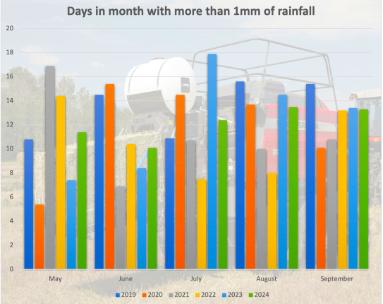
This shows that in the past three years in particular, there has been a marked 22% drop in sunshine hours during the spring and 16% in the summer. In contrast, the number of days with more than 1mm of rainfall in the spring and summer increased by 47% and 39% respectively, with

overall total rainfall during those periods rising by 70% and 49% respectively.
For farmers and forage producers in particular, working within these narrowing weather windows has proved a challenge, especially for hay producers where relying on the crop naturally drying down to the optimum 15% moisture content for baling has been particularly problematical.

Faced with this


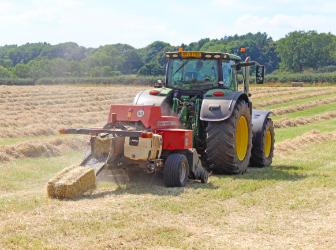



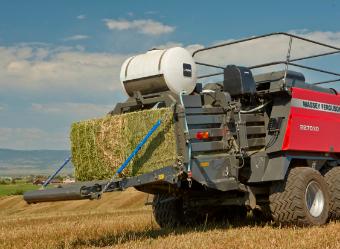



challenge, the use of Baler’s Choice hay preservative has been a lifeline. From as little as £1.43/bale, Baler’s Choice enables hay to be safely baled at moisture contents above 15%, so preserving hay quality without the risk of bales heating up, becoming mouldy or at worst spontaneously combusting.
Well proven over many years, the core ingredient within Harvest Tec’s Baler’s Choice preservative is a near neutral, buffered form of Propionic Acid. This retains all the well recognised and proven benefits in reducing heating and stabilising temperature within bales, in addition to the prevention of
moulds, dust and loss of bale quality. But being near neutral Ph, it avoids damage to the baler and is safe to handle. This is combined with Citric Acid to aid colour retention and palatability.
For contractors and other baler users, this has the great benefit that when applied at the correct rate, by enabling hay to be safely baled at above 15% moisture, this offers the potential to lengthen the baling day by maybe an hour each end or bale on days when previously the crop would not be dry enough.
Not only is there a financial benefit through higher daily throughput from the baler, but it also helps simplify logistics and planning and also the potential to save on the time and cost of additional tedding, with the associated risk of damage to the crop. For those selling hay or straw, Baler’s Choice ensures that bale quality is preserved and potential heating and the development of mould prevented.
The Harvest Tec Baler’s Choice applicator systems for large square, round and conventional balers, range from simple, straightforward applicators with manual rate setting, through to the advanced Automatic 700 Series applicator that monitors both baler throughput and real time moisture content of the hay or straw as it passes through the baler to automatically adjust the application rate accordingly.
To provide technical advice, ensure prompt availability of applicator systems and the rapid supply of spare parts throughout the UK, Harvest Tec has established a network of regional technical specialists, supported by Carr’s Billington, who in addition to handling sales within their own area, also act as a central distribution hub for Harvest Tec, holding both applicator units and spare parts for dispatch to all other Harvest Tec UK dealerships.
Further information on Baler’s Choice applicators and preservative can be found via the Harvest Tec UK website: VISIT THE HARVEST TEC UK WEBSITE


eading quarry and minerals processor Kilwaughter Minerals has officially launched its new Soil Health Hub, an educational resource designed to empower farmers with expert knowledge on soil health, pH management, and nutrition strategies.
The free-to-access online service offers advice, articles and case studies as well as a dedicated portal for soil testing, including personalised tracking, field management, nutrient guidance, lime recommendations and a unique soil health dashboard specific to individual farms.
The hub was officially launched at Kilwaughter’s headquarters in Larne at an event that brought together industry experts, government representatives, customers, and farmers for an engaging and insightful discussion on sustainable soil management.
Taking place on Valentine’s Day, the event reinforced Kilwaughter Minerals’ deep-rooted commitment to soil care with its ‘love for soil’ message, highlighting the crucial role of healthy soil in agricultural productivity.
Gary Wilmot, Chief Executive Officer at Kilwaughter Minerals, emphasised the company's dedication to agricultural education and innovation, saying:
“The launch of our Soil Health Hub is part of Kilwaughter’s ongoing commitment to education and innovation in agriculture.
“By promoting data-driven decision-making and sustainable soil management practices, we aim to support a thriving and environmentally-responsible farming sector.
“Soil health is fundamental to farm success, and this hub will provide farmers with the tools and knowledge they need to ‘love their soil’ and maximise productivity.”
The launch event featured a distinguished panel of guest speakers, each providing valuable expertise on soil management and sustainability. Agronomist Mark Tripney shared insights on the significance of maintaining healthy soil, while Hannah Shirt, Business Development Manager at Lancrop Laboratories, discussed best practices for soil testing.
Steven Johnston, Senior Ruminant Technologist at the Department of Agriculture, Environment and Rural Affairs (DEARA), also highlighted government initiatives such as the Soil Nutrient Health Scheme while farmers Gabriel and Claire Kelly offered real-world perspectives on how soil testing and the use of granulated lime have positively impacted their farm operations.

The launch event underscored Kilwaughter Minerals’ commitment to empowering the agricultural community with practical solutions and expert guidance.
The Soil Health Hub is set to become an invaluable resource for farmers seeking to enhance their understanding of soil management, improve productivity, and foster long-term soil health for future generations.
For further information please visit: https:// www.kilwaughter.com/
KWS Vegetables, world leader in spinach seeds, has once again held its open days from February 11 to 13 at its trial field in Miranda, Murcia. A total of 20 hectares where the Dutch multinational has presented new improved varieties and has received customers from all over Europe.
From its extensive catalogue of spinach, all of which are notable for their quality, performance and resistance, KWS Vegetables' novelty for this season highlights KSP 0066. "This is our fastest variety for the winter segment. It even surpasses Quartz by bringing forward the harvest by 4-5 days, offering an ideal window for harvesting," says José Carlos Grajeda, regional product manager. "Its bright and uniform colour, of a very intense green, as well as its tolerance to salts and local breeds, such as mildew and 1.20, makes it optimal for any producer, as it also adapts very well to all locations and terrains," he adds.
Offering personalized and constant support is a priority for KWS Vegetables. To this end, the multinational continues to evolve its "Spinach 365" program with which iervice throughout the year to its customers. "With this program we help producers to supply the same quality of leaf—and in the desired quantities to supermarkets— throughout the year. This benefits their consistency in supply and helps their image in the eyes of the
suppliers," says René van Meijel, team leader for Baby Spinach and Swiss Chard Europe.
In its desire to provide added value, and as a novelty for this edition, the Dutch multinational has held a conference on Pythium exclusively for customers. This pest has a great impact on crop profitability and is one of the main challenges for spinach producers. To learn how to manage Pythium effectively, KWS Vegetables' experts, Mark Charlesworth, Product Manager for Spinach and Chard, and Anita van Nieuwehhoven, Manager for Technology Applied to Vegetable Seeds, presented their strategies and tips to the attending professionals.
Finally, the INITIO nutrient substrate has been present again for another year in the test field. This nutrient-rich coating, which provides a strong start to spinach crops by improving their growth and yield, is already highly popular and is applied to most European spinach orders.
After the success achieved in Miranda, Murcia, the Dutch seed company already has its sights set on its next field days. Among all of them, the highlight will come from the already consolidated Pop Fest, which will take place in Aandijk, the Netherlands, from September 20 to 24. Finally, and closing the circle, the Winter Pop Fest will once again present the company's novelties in Murcia. It will be during week 7 of 2026, this time at its experimental station in Miranda, Murcia.

AMelrose-based entrepreneur is set to become the first in Scotland to offer advanced crop spraying services using a state-of-the-art, supersized drone, following a funding boost from the British Business Bank.
James Braid, the founder of Sky-Pin Drones Ltd, first learned to fly a drone in 2017 and launched his business after being made redundant from a career in financial services. In 2019, he established the company and began offering commercial aerial drone services, specialising in multispectral plant health mapping, photogrammetry, and aerial mapping surveys to assist landowners and farmers
across Scotland.
The use of drone technology supports sustainable agricultural practices and land restoration in sensitive areas such as peatlands and woodlands. It helps farmers reduce their environmental impact by leveraging data, using fewer chemicals, and conserving resources.
In response to the growing demand for precision agriculture and environmental restoration, James set his sights on growing the business and expanding its services to include crop spraying and spreading, seeding for conservation projects, horticulture greenhouse shading and cleaning, and

solar panel inspection and cleaning.
Following his completion of the CAA/Lantra Approved Remote Pilot & Drones Spraying Certification – achieved in collaboration with AutoSpray Ltd, Precision Spray, and Harper Adams University in Newport – James became the first and only person in Scotland qualified to operate drones in agricultural spraying and spreading.
With a £48,000 loan through the British Business Bank’s Investment Fund for Scotland, managed by DSL Business Finance, James purchased a cutting-edge drone to deliver these new services. The drone, weighing 110kg, boasts a wingspan of over two metres and can spread up to 150kg of material per minute.
In addition to its crop-spraying capabilities, Sky-Pin Drones integrates multispectral plant health mapping technology – sensors that capture light in specific bands beyond the visible spectrum – to

provide valuable data on crop health. These insights allow farmers to identify areas of poor crop performance within larger fields, minimise chemical use, and optimise fertiliser application.
James said: “Sustainability is playing an increasingly vital role in modern farming, and I’ve noticed a growing shift among my clients toward adopting more biodiverse products and practices. The drone technology I use is specifically designed to enhance sustainability by reducing chemical usage and promoting environmentally friendly approaches. It has already made a positive impact on ecological projects such as peatland restoration and habitat management.
“Running a small business with limited capital can be challenging, so I’m grateful to the teams at the British Business Bank and DSL Business Finance for their support in helping to bring this technology to Scotland for the first time.
“Currently, I’m managing the business independently, but I’m excited about the prospect of expanding the team as more people discover the advantages of drones in agriculture and land management. I’m looking forward to this next chapter and showcasing how this innovative technology can unlock new opportunities and drive progress in these sectors.”
Sky-Pin Drones’ new services will be available to clients by summer 2025.
The Investment Fund for Scotland offers loans ranging from £25,000 to £2 million and equity investments up to £5 million. The fund is part of the Bank’s commitment to fostering sustainable economic growth by supporting smaller businesses across Scotland.
Sarah Newbould, Senior Investment Manager, Nations and Regions Investment Funds, at the British Business Bank, said: “Sky-Pin Drones is an ambitious and innovative business looking to provide the agriculture and forestry sectors with access to technology that could make a significant contribution to protecting the environment. The Investment Fund for Scotland was created to support businesses like Sky-Pin Drones to access the finance they need to develop and grow.”
Lesley Prentice, loan officer at DSL Business Finance, added: “Working with James throughout the loan application process at DSL Business Finance was incredibly inspiring. His passion for using drone technology to promote sustainable farming is truly impressive. From gaining specialised qualifications to understanding the needs of local farmers, James has worked to bring his innovative service to Scotland. I’m excited to see how Sky-Pin Drones will benefit the environment and farming communities, and I wish him every success as the business grows.”
Anew study has found that Miscanthus offers farmers a long-term profitable and low-risk alternative to conventional crops like wheat and barley, in less productive areas of the farm. By improving farm resilience and long-term profitability, the perennial crop provides a promising solution amid rising uncertainty.
The study from Miscanthus specialist, Terravesta, using certified 2023 UK crop prices and factoring in government schemes such as the Sustainable Farming Incentive (SFI) and Countryside Stewardship (CS), shows that despite high establishment costs, Miscanthus delivers greater profitability over a 10-year period compared to wheat and barley. Beyond this point, its low maintenance costs further boost returns.
Ultimately, it shows that adding Miscanthus to the farm can improve overall resilience and profitability, particularly in low or medium yielding areas.
“Planting Miscanthus may initially appear financially challenging due to high establishment costs and delayed returns. However, this analysis shows that stable, long-term returns outweigh these initial
hurdles,” explains Terravesta managing director, Florian Ilias.
“Even considering attempts to compensate for low market prices with farming schemes and to capitalise on higher price years, as well as the early opportunity costs when Miscanthus is not yet yielding, farmers are still better off with Miscanthus after 10 years compared to the two alternative crops. Beyond year 10, its low maintenance costs further improve profitability,” says Florian.
Stable and predictable returns: Miscanthus provides steady income with less vulnerability to price fluctuations compared to wheat and barley. Resilient to weather and pests: Unlike annual crops, Miscanthus withstands poor weather and is pest-resistant, offering dependable yields.
Consistent option in uncertain markets: With stable, inflation-linked pricing, Miscanthus delivers financial reliability.
SFI and CS fall short: While SFI and CS options are appealing, growing perennial Miscanthus is
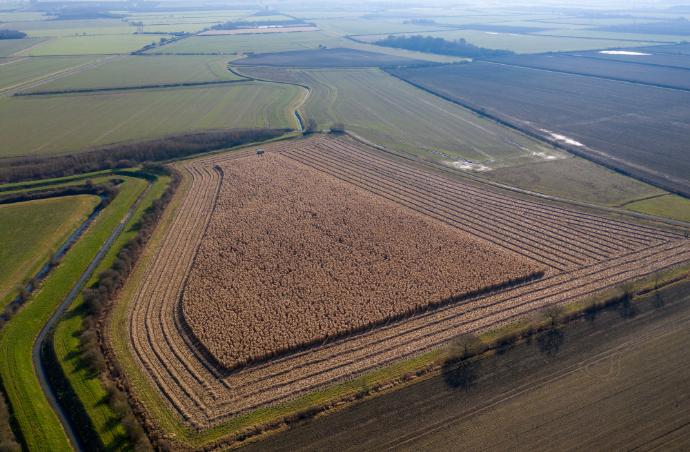
typically more profitable long-term and less dependent on erratic government decisions.
Long term security: Annual crops or farming schemes do not offer long term security over a period of 10 years.
Why Miscanthus?
Unmatched stability
While wheat and barley prices have fluctuated significantly over the past decade - with wheat ranging from £99 to £227 per tonne and barley from £100 to £224 per tonne - Miscanthus offers predictable, inflation-proof returns. This stability makes it an attractive option in volatile markets.
“Miscanthus requires no fertiliser, no inputs postestablishment or annual reseeding, unlike arable crops that face rising costs for fertilisers, chemicals, and labour. The cost of fertilisers has also risen sharply, often by more than 100%, and this will continue, with the incoming carbon tax on fertiliser due to hit farmers.
“Additionally, Miscanthus is pest-resistant, eliminating the need for costly treatments,” Florian says.
longer Miscanthus remains in production, the greater its profitability compared to traditional arable crops.
Miscanthus is a reliable option especially in volatile markets.
The comparison of net margins shows the impressive performance of Miscanthus even when compared to a situation of relatively high market prices for wheat (£190 / t) and barley (£175 / t).
Miscanthus margins remain unchanged between 2014-2020
These compared to Miscanthus net margins over the same period which did not respond to market price fluctuations.
Rob Meadley, Brown and Co agricultural business consultant and East Yorkshire arable farmer, planted 12 hectares of Miscanthus in 2012 on varying quality, outlying land which previously wasn’t delivering a viable return with arable crops. Ultimately, Rob explains that there would not have been another option for a crop on that land which would have been as profitable. “Back in 2012 when we decided to plant Miscanthus, the principle was looking at the whole farm net margin and identifying the risk in this area.

profitability
The report shows a long-term scenario comparing a 100 hectare ‘food farm’ growing cereals and a 100 hectare ‘biomass farm’ growing Miscanthus over a 10-year period.
Adjusted for inflation over 10 years, the ‘food farm’ achieved a cumulative net margin of £342,920, driven by early income from arable schemes and two years of unusually high crop prices.
In contrast, the ‘biomass farm’ faces initial setbacks due to the high establishment costs of Miscanthus but breaks even by year five. With stable yields and inflation-proof (index-linked) prices, it eventually outperforms ‘food farm’, generating a total profit margin of £424,663—around £80,000 more. The
“It wasn’t performing as well as other parts of the farm and Miscanthus was 100% the right decision for it. The only other option for that land would have been environmental grass, but Miscanthus beats these hands down from a net margin point of view.
“Miscanthus is a vitally important crop due to its soil carbon capabilities and positive ecological impact, and with the uncertainty around farm subsidies under the Environmental Land Management (ELM) model, it provides a long-term fixed price, reliable income,” adds Rob.
Miscanthus offers UK farmers a stable, highyielding crop with minimal annual inputs. It thrives on poorer quality land, is resistant to pests and can withstand extreme weather conditions, making it an ideal choice for diversification. Adding Miscanthus to the farm can improve overall resilience and profitability, particularly in low or medium yielding areas.
To read the Miscanthus report, visit https://bit.ly/ 3CcOa1R For more information about Miscanthus and how it can transform your farming operations, visit www.Terravesta.com
ForFarmers has launched a new range of premium blends aimed at those who feed both cattle and sheep out of troughs and hoppers rather than feeding via mixer wagons.
Alister Davies, ForFarmers' UK beef and sheep commercial manager explains: "Premium blends are an offering which now sit between compound feeds and traditional mealy blends and allow farmers to benefit from quality blends, without the need to put it through a mixer wagon."

Made from predominantly nutty or whole ingredients, the blend includes whole oats and maize for the sheep blends, rolled barley, sugar beet, micronized flakes, North American soya and wheat feed pellets.
"As a total feed company, ForFarmers has an offer in every segment of the feed sector bar premium blends and this launch now fills that demand," explains Alister.
"Demand for premium blends is growing, and is already supplied successfully in Scotland and the north of England from ForFarmers blend plant at Brydekirk."
The construction of a new purpose-built site, next door to the compound mill at Newcastle under Lyme in Staffordshire, increases ForFarmers ability to meet the needs of its expanding beef and sheep customer base.
Alister says: "Delivery will be available across middle England and north to mid Wales with 800kg totes available nationally. The Newcastle under Lyme site's convenient location alongside the M6 will also allow customers and merchants to collect should they wish."

Trinity Grain, the farmer-owned grain storage and marketing cooperative, welcomed farmers and industry leaders to a well-attended speaker event on February 5th. The evening, themed “Helping Yourself and Helping Each Other,” provided a forum for open discussion on the challenges facing UK agriculture, with a strong emphasis on the power of collaboration as a means of securing a sustainable future.
Alongside representatives from Trinity Grain, a panel of respected industry figures, including former NFU President Minette Batters, Velcourt CEO Nick Shorter, Evolution ABS Director Dan Knight, and Openfield CEO James Dallas, explored key issues such as policy uncertainty, market volatility and the need for transparency and fairness. Discussions underscored the importance of collective action in strengthening farmers’ negotiating power and influencing decision-makers.
Reflecting on the success of the evening, David Evans, Managing Director of Trinity Grain, commented:
“Trinity Grain members and invited industry guests were fully engaged, eager to collaborate, and embraced the cooperative spirit - demonstrating that our strength truly lies in working together.
“Beyond the panel discussions, the event provided an invaluable opportunity for members and invited guests to connect, exchange ideas and build relationships. Seeing so many engaged in meaningful conversations reinforced the importance of events like this in fostering collaboration and driving positive change in the industry.”
The evening also provided an opportunity for Trinity Grain to outline its strategic direction. Evans highlighted the cooperative’s commitment to affordable grain storage, expert pool marketing and risk management solutions designed to protect members’ interests and maximise returns. He emphasised the importance of strong governance, strategic leadership and professional management in delivering long-term success in an increasingly challenging sector.
Chairman Richard Williamson addressed the broader difficulties facing UK farming, acknowledging the mounting pressures on farm profitability and the importance of continued advocacy on issues such as imported food quality standards and fairer market conditions. Despite the challenges, he reinforced a message of optimism:
“Beyond legislative changes, it was highlighted that maintaining profitable farming businesses is becoming increasingly difficult. It is crucial that attention and advocacy extend to other pressing challenges, such as the quality standards of imported products.”
“However, despite these challenges, there remains a strong sense of optimism. Farming communities must sustain hope, resilience and progress.”
“Our thanks go to the panel and everyone who attended and contributed to making the evening such a success. We look forward to continuing these discussions and working together to shape a brighter future for UK farming.”

Against a backdrop of poor planting conditions in Autumn 2023 and a large carry forward of crops into 2024, the British farmer-owned grain marketing and arable inputs co-operative has reported a profit of £0.8m for the year to 30 June 2024 (2023: Profit £2.3m). This was achieved as the group focussed on servicing its UK consumers with UK sourced
grain and growing their domestic sales.
In addition to growing their sales with leading UK consumers, Openfield continued their relentless focus on improving service to their 4000 farmer members and enhancing links in the supply chains with their consumer customers. The group also sought opportunities across all areas of their operations to improve their Member Proposition, including enhancement to Insight, their member portal and their Insight App, where members can now access a number of new features including the option to receive grain delivery alerts, tipped net weights information and an excellent small seed offer which can support informed SFI decisions.

Commenting on its performance, Openfield’s chairman Philip Moody said: “I’m very pleased that our strategy to increase the size of our own fleet has paid dividends. These include improved service and reduced operating costs, which enabled us to maintain our profitability in another challenging year for our industry. It’s also very pleasing to see that our own fleet team is now a professional logistics provider, able to service our members and

consumers better, as we took on additional work to increase our fleet revenues.”
Looking forwards, the group acknowledges that supply chains are increasingly seeking strong environmental, social, and governance (ESG) policies. To support their own ESG ambitions, Openfield is developing new supply contracts to support a sustainable agriculture model. The group is also trialling electric powered trucks and reviewing alternative fuel sources for their fleet, including Compressed Natural Gas. These actions will reduce their own carbon emissions, which have increased significantly since their own fleet of trucks increased.
Openfield performance to June 2024:
• Profit before tax of £0.8m compared with £2.3m in 2023;
• Operating costs reduced by 18.5% to £14.1 (2023 £17.3 million);
• Group revenues reduced by 31% to £555m (2023: 806m);
• Net assets (exc. pension fund) increased by 2% to £29.5m (2023: £28.9m)
• Total exported volumes were 244,000 tonnes (2023: 878,000 tonnes).

ALincolnshire farmer Mark Popplewell has won gold at the 2025 Yield Enhancement Network (YEN) awards for achieving a record-breaking oat yield of 11.46 t/ha, more than double the national average.
The impressive yield, achieved by Happy Days Farming, was credited to the oat variety - Merlin, as well as precise nutrition, and an unusually wet spring. "The numbers were so high we thought the equipment was faulty," said Mark. "The grain tank was filling faster than even a strong wheat crop."
This was Happy Days Farming's first oat harvest, planting 300 hectares of Merlin oats in late March after a wet winter. With advanced seed treatment, growth regulators, and optimised fertiliser application, yields reached up to 14 t/ha in some areas.
“We’ll grow more Merlin in 2025 as it fits well in our rotation,” said Mark, who manages 2,000 hectares of arable land and ‘B&B pigs’.
Gemma Clarke, Managing Director of seed and grain specialist COPE, who launched Merlin to the market in 2021, highlighted the importance of investing in new varieties. “Resilient seed varieties are critical as farmers face increasing challenges from climate change and unpredictable weather.
“There is no greater feeling than connecting world renowned plant
breeders to growers and end markets. We are thrilled with how Merlin has been performing for farmers across the UK showing its strengths across a range of different seasons. It really is a consistent and reliable variety, with huge yield potential as demonstrated by Mark,” says Gemma.
Merlin oats are accepted by all mills and valued for early harvest, low screenings, high disease resistance and strong yield potential make it attractive to farmers nationwide.
“It’s one of only two spring varieties on spring oat contracts. It’s an early variety (-2), offers a competitive lodging score of 8, and has a high rating of 7 for mildew. It also has low screenings which is a real bonus to the mills and a good specific weight,” adds Gemma.
TheYield Enhancement Network (YEN)is an independent knowledgeexchange network allowing farmers to measure and compare their crop performance on 60 different factorsincluding agronomy decisions and soil health. The network, open again to growers in 2025, encourages members to share ideas, learn from each other, and work together towards better crop yields.
For more on Merlin oats, contact your merchant.

One of Ireland’s best-known and long-established transport operators reports significant time saving, faster invoicing and improved job management since switching over to a new transport management system.
Martin Ryan & Sons, based in Cappamore, Co Limerick, specialises in container transport and provides a diverse range of logistics and warehousing services for numerous industry sectors, including waste, dairy and agriculture.
Run by brothers and co-directors, Brendan, Declan and Martin Ryan, the family firm was established over 60 years ago and now
operates over 100 vehicles, including container carriers, curtainsiders, refrigerated trailers and tankers. Regular routes outside Ireland and the UK include France, Germany Belgium and the Netherlands.
“With over 150 separate movements each day, says Brendan, “we needed a TMS system which could control and integrate all aspects of the operation while giving us the ability to connect the people and processes involved at every stage – from initial job creation to invoicing and everything in between.”
To achieve this, Martin Ryan & Sons switched from a less capable system in November 2021, to Eureka’s MoveIT TMS. Since then,

says the company, it has increased efficiency and raised the bar concerning day-to-day communication between customers, drivers, office staff and sub-contractors.
“The MoveIT system has everything in one place,” says Brendan. “We use EDIs (electronic data interchange) to connect with customers and bring jobs in using excel and PDF files. The web portal then allows customers to view work in real time and to download PODs (proof of delivery) at any point. The documentation is automatically completed and filed, while at the same time allowing invoices to be quickly raised via direct connection with Sage 50 accounting.”
This, synergistic and ‘paperless’ process, says Brendan, saves at least one day a week in admin time – just for one customer.

“We used to manually enter all information, including job creation, new deliveries, sudden changes to shipping lanes, driver info’, subcontractors, POD’s and invoices etc. Now, the MoveIT TMS ties it all together in digital form and saves all documents to the correct place, for quick and easy retrieval. Good for us and great for our customers.”
Furthermore, adds Brendan, the system’s Live Planning and Resource Boards enable each business unit within the company to view a daily summary, including priced and unpriced jobs, vehicle utilisation and subcontractor involvement.
“The resource boards use automated charts to give us a snapshot of how each day is going,” says Brendan. “We can see all info regarding consignments and deliveries etc. and can
instantly let the customer know the status of each job. Also, we can see how many vehicles are employed, make adjustments where needed and monitor overall performance against set targets.”
According to Brendan, Drivers too are able to take a proactive role in day-to-day operations, by using the Transics In-Cab communication solution, integrated with Eureka’s MoveIT TMS.
“Just as our customers are able to submit, monitor and view all kinds of useful information pertaining to ongoing jobs, so too are our drivers,” says Brendan. “With 90 to 100 drivers on the road, that’s a lot of individual records and job-related data to manage. However, the driver portal not only allows drivers to keep track of and reply to real-time job information, but it also enables them to submit timesheets and holiday requests; report any vehicle damage or incidents and keep on top of any infringement or licence issues – all invaluable for effective HR management and compliance control.”
Moreover says Brendan, messages can be sent from the traffic office in English and received in the language of any non-English speaking driver, who can respond with updates in their own language, which are instantly translated and received in English.
“The MoveIT TMS provides us with a host of operational efficiencies, fingertip management control, and significant savings. Plus, it is aligned to satisfying individual customer needs,” concludes Brendan Ryan. “Thanks mainly to the knowledge, commitment and close support from Eureka’s General Manager, Mark Healy, the system proved to be simple to install, easy to operate and above all, a comprehensive management tool.”
Martin Ryan Haulage also supplies a fully accredited warehousing service including unloading, palletising, storage, pick & pack and distribution. The company is a longstanding member of the Irish RHA.
More about Martin Ryan & Sons here:https:// www.martinryanhaulage.ie/
More about Eureka here:https://www.eureka. ie/

Makita has added a new telescopic pole saw to its growing range of LXT tools designed for professional
in 50 mm cedar square timber and in addition to its high work efficiency, Makita has incorporated several design features to offer increased ergonomics and greater


lubrication simplifies maintenance and ensures consistent performance.
On the new launch, Kevin Brannigan Marketing Manager at Makita said: “This new tool is part of Makita’s expanding 18V LXT System, which encompasses over 300 tools from garden machines, power tools and accessories such as kettles and heated
jackets - all powered by the same battery. We are delighted to add this fantastic pole saw to the range, that delivers impressive performance for high drain applications, while reducing fatigue for the operator.”
To find out more about Makita, visit www. makitauk.com

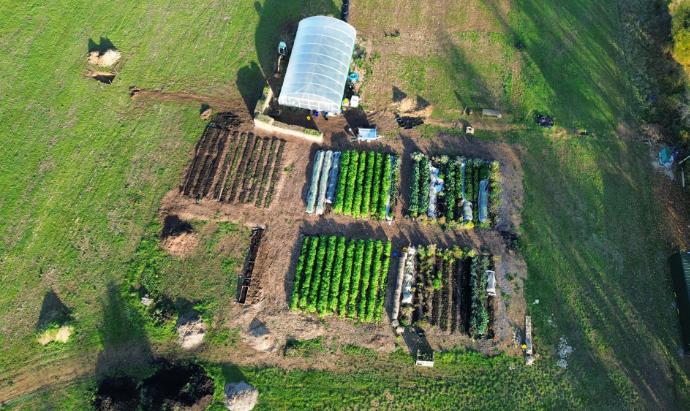
In an attempt to tackle the increasing adverse effects of climate change on UK farming, the Royal Agricultural University (RAU) has joined forces with an award-winning local regenerative farming business to make the University's teaching farm fully regenerative.
Coates Manor Farm, which is next door to the University's main Cirencester campus, is a vital part of RAU students' learning about agriculture and related disciplines, and the 457-acre arable farm is now being farmed in an exciting new collaboration between the University and local

This change in farming system - which includes a more diverse crop rotation, a range of cover crops, grazing cover crops with livestock, and direct drilling - has enabled RAU students to gain experience in a wider range of farm management techniques including growing peas, beans, and spelt wheat, as well the management of over winter cover crops.
RAU Agriculture Professor Nicola Cannon, who oversees the teaching at Manor Farm, said: "The RAU is at the forefront of both education and research to find solutions to the challenges


currently facing the agricultural industry and our Manor Farm site provides a vital canvas for our teaching as well as our research projects and links with the agricultural industry.
"In addition to using the farm as a base for practical field classes, real-life scenarios, case study based learning, and environmental planning, it also allows us to teach students the more traditional agricultural skills, such as crop and livestock monitoring and evaluation, understanding a range of husbandry practices, and weed, pest, and disease identification.
"It's really important that we are able to offer our students a diversity of enterprises to enhance their learning opportunities whilst also addressing the challenges facing the food supply chain. During the Covid-19 pandemic, many food supply chains suffered and we had empty shelves due to the restrictions that were imposed and we know that using ultra-local food supply chains can help improve food security."
Regenerative farming focuses on enhancing soil health. A combination of practices - including maintaining soil cover, integrating crop and livestock


enterprises, maintaining living roots in the soil, practicing diverse crop rotations, and minimal soil disturbance - helps to build organic matter which, in turn, stabilises the soil and helps to reduce erosion as well as creating diverse soil microbiomes and decreasing the risk of environmental stress.
Ed Horton, RAU Alumnus and partner at SS Horton and Sons, explained: "We are aiming for the RAU's farming operation to be a guide to regenerative agriculture at scale. Utilising our access to local markets for produce allows us to grow a more diverse range of cropping, such as spelt wheat for Northern Pasta, and durum wheat for our local mill, Matthews Cotswold Flour.
"Having a close working relationship with the customer means that the end user has full traceability and transparency in how their food is produced, and what the long-term benefits are to biodiversity, soil health, and water quality.
"We also aim to show to students and the wider farming community that, over time, a reduction in external synthetic inputs will still produce commercially viable yields in a tough market, with far less risk exposure to the vagaries of the global


commodity markets."
Regenerative farming is a key step towards developing resilient farming systems which can cope with extreme weather conditions and a changing climate.
Professor Cannon explained: "The UK is experiencing more extreme weather conditionsincluding named storms, prolonged wet periods and flooding, and, at times, very hot and dry periods limiting growth - and these extremes are occurring much more frequently.
"Farming systems, not just here in the UK but across the globe, need to respond to this changing environment to ensure that we can carry on producing food whilst also acting as of part of the solution for climate change."
This method of farming offers resilience to changing market conditions as it is not reliant on a single crop, and it also encourages diversity on farms through a wider range of crop rotations which not only improves the ability to cope with environmental stressors but also creates a wider range of habitats to improve biodiversity.
Professor Cannon added: "As well as helping farmers to deal with climate change, regenerative farming is also a climate change solution as it is one of the most reliably tried and tested ways of sequestering carbon. It also reduces emissions by using less fossil fuel for cultivations and being less reliant on crop protection products so it should therefore also lower greenhouse gas emissions."
The University is also working with Zerodig - a social enterprise which established a seven-acre site on land adjoining the RAU's Cirencester campus last year - not only to teach students on the RAU's MSc in Agroecology course but also, working directly with the

University's kitchens, to provide produce for hospitality and retail markets.
RAU students are actively involved in all aspects of Zerodig and the planting schedules for this season are currently being finalised to match the University's catering requirements for the next year.
Edward Bonn, Farm Environment Adviser at Farming and Wildlife Advisory Group (FWAG) South West which is working with Zerodig, said: "We grow a wide range of crops using a low soil disturbance system to try and improve soil health. Our site offers students a great opportunity for hands on involvement in horticultural production throughout the year.
"The RAU wants to ensure that as much of the food as possible that it serves through its student and staff catering, and also its external commercial bookings such as weddings, conferences, and the like, is RAU grown. Not only does this cut down food miles but it also raises the visibility of seasonal vegetables which can be harvested to directly meet the market demands."
Professor Cannon concluded: "Both these partnerships help us to provide real time examples of regenerative farming practices and sustainable food production systems to teach students across a wide range of our courses – from the BSc and Foundation degrees in Agriculture to Countryside Management and Land and Property Management, as well as International Business and our MSc in Agroecology.

"Meanwhile, our focus on supplying locally produced food really helps consumers connect with their food, as well as supporting and driving local business and maintaining the UK as a valued producer of the food we eat. Basically, it's win, win and absolutely what, as an agricultural university, we should be doing!"
Astudent who has floated an idea to boost butterfly and moth populations in Scotland has won first prize in an enterprise challenge.
Leòdhas Massie, who is studying for a BSc degree in Environmental Management at Scotland's Rural College (SRUC) in Edinburgh, took home £1,000 to take his sustainable business proposal to the next level.
The 30-year-old from Garmouth, Moray, said: "Entering SRUC's Enterprise Challenge has been an incredible experience. Before taking part, my idea felt like an aspiration for the distant future. Winning the competition feels like an incredible endorsement of what I want to do and brings my idea to life.
"My aim is to supply ethically sourced native moth and butterfly species for a range of markets that will also work to support biodiversity and conversation efforts."
including one to a team of ten Countryside Management students from SRUC's Elmwood campus in Fife.
The competition asks students to develop innovative ideas that can develop into potentially transformative businesses, with the winners receiving a seed fund prize to help grow their dreams.
Entries were judged by SRUC Entrepreneur in Residence Jackie Brierton MBE, Co-CEO of GrowBiz, Tommy Dale, Managing Director of Forth Resource Management and Dr Lissa Herron, Enterprise Manager at Converge.


"As usual, the enterprise competition at SRUC produced many highquality applications," said Jackie. "The presentations were of a particularly excellent standard, and it was a difficult job for the judges to make a decision."
Growing up on the Moray coast, Leòdhas found himself surrounded by nature from an early age, where he took a particular interest in lepidoptera and developed a fascination with their forms.
Against a backdrop of moth and specialist butterfly populations in decline across the UK, among other insect types, he sees local solutions as key to tackling national problems. Restoring moth numbers poses a particular issue, not least due to their negative public perception compared to butterflies.
As varied and important pollinators, however, they are also important to a balanced and sustainable recovery.
Coming in a close second in the competition was BSc Equine Science and Management student Eilidh Garrett, who won £750, while Gregory Webzell and Rakshanda Uikey came in joint third, winning £500 each.
Aberdeen-based Stacy Brodie came in fourth, and three highly commended prizes were given,
"We were delighted to see such a range of ideas put forward, and it was great to support this endeavour at the college."
Funding for the prizes was provided by Anderson Strathearn, Forth Resource Management and GrowBiz, with further support for running the competition provided through Knowledge Exchange and Innovation Funding from the Scottish Funding Council.
Dr Carol Langston, Director of SRUC's Enterprise Academy, said: "At the Enterprise Academy our goal is to accelerate the uptake and delivery of more sustainable enterprise. We are doing this by developing the enterprising mindsets and boosting the business skills of the next generations.
"Our Enterprise Competition is an annual culmination of this work. It's been a real privilege this year to work with such inspiring students as they start their entrepreneurial journeys, and we look forward to continuing to support them as they start to test and validate their ideas."
For further information, visit www.sruc.ac.uk/ enterpriseacademy


can’t remember when I decided I wanted to be a farmer, it was just something ingrained deep within me. Growing up on a farm, you’d be hard-pressednotto catcha bitof the farming bug, but I always knew there was no place else for me.
I was lucky enough to grow up on the beautiful Yorkshire farm I still get to call my home. My grandfather moved here in the early 60s; he was what nowadays we’d call a new entrant. My Granny joined him shortly after, once she’d been to Agricultural College, to farm alongside him and help mould it into a mixed farm, with livestock for her to tend to, like the one she’d grown up on. Nowadays, the farm is around 225 acres, a mixture of rented and owned land, and we run a beef suckler herd of around 35 cows, selling the calves as stores, alongside growing a mixture of arable crops. It’s a family farm, run by my dad and uncle, with my uncle’s sons also working here as needed. We also run an agricultural contracting business alongside it, as the farm isn’t big enough to support


everyone on its own.
I’d always planned to follow in my Granny’s and Dad’s footsteps, despite some school teachers trying to persuade me otherwise because of their belief it was a man’s world and not one for an A* student... which only made me more determined to farm. But as I turned 16, I developed some chronic health conditions, the main one being Myalgic Encephalomyelitis (M.E.), which derailed my plans of Agricultural College and becoming a

farmer in the way I’d imagined. I spent a lot of years only able to experience our farm through a window or screen, and once I was well enough to, had to find a different way of being a part of it.
There’s been lots of adapting and thinking outside of the box over the years. At first, we basically had to bring the farm to me, so my dad set cameras up in the cow shed so I could watch for calving problems, and that was the beginning of finding my place here.




Today, alongside ‘maternity watch’ each spring, I’m also in charge of all the paperwork that comes with running our farm and contracting business. It’s my way of being a part of the industry I love while also being able to take care of my health and be flexible with when and where I work from (usually my bedroom). I’m so grateful that farming has so many different roles within the industry other than physically being a farmer, which means I’m still able to play a part in the story behind the food on our plates.
When my health allows, I also love helping out with our cows. You’ll often find me outside in my powered wheelchair, that’s been ‘farm-proofed’ with some tyres with tractor tread, doing the evening checks or helping with field moves throughout the summer, checking the latest arrival in the calving shed in spring, or watching one arrive, on hand to break the birth sac if necessary to make sure the calf doesn’t suffocate, or sitting by the cattle crush helping with routine management tasks like vaccinating or weighing when the cattle come inside for winter.
One of my other biggest passions is helping
reconnect people to their food and bringing the world of British Agriculture to those who perhaps don’t have the same view out of their bedroom window, and trying to ensure future generations know they’re welcome to join us. Something I try to use my blog and social media platforms for. It’s often assumed that farmers justsit on a tractor all day, but there’s much more to the job than your driving skills (or like me, lack of!). Although I’m not able to work in the industry as I’d intended to, I love the fact that as there’s so many components which go into being a farmer, we’re able to adapt roles to suit my disability.
One of my biggest wishes is that more people knew how many different jobs there are within agriculture, all of them playing a vital role in getting the food onto our plates. There’s so much more than being an actual farmer, and new ideas and perspectives are always needed.
As an industry, we’re definitely not going to win any prizes for our diversity, and there’s lots of people in society who don’t see themselves represented here yet and are put off, or actively discouraged, from joining us. But there’s some of us working really hard to make sure one day, every child will see themselves reflected back so they can grow up knowing that if they have a passion for agriculture, there’s a place for them here, whatever their background, race, sexual orientation, disability, gender or lack of connection to farming.
I know howimmenselylucky I’ve been to have had a childhood interlaced with farming, and family and friends who’ve never been anything but supportive, and to have had the support to join the industry after becoming disabled, and I’d love nothing more than to encourage others to give somebody else that support as well. There’s plenty of people who want to join us, and it’s up to us to open doors and give them the support they need.


You can follow Holly’s ramblings of a farm bound girl on the following: Instagram: @onegirlandhercows Facebook: @One Girl and Her Cows

Another year, and other challenging season for growing potatoes. The 2023 harvest ended, for some, in a bog, with crops abandoned to the floods. 2024 did not begin in a way to induce confidence. A wet winter was followed by a wet spring and a shortage of seed. Planting for some was a never-ending story, well ending in June perhaps. Cold and gloomy growing conditions for crops that had made it into the ground did not bode well, but, in the nick of time, the clouds parted, the sun came out and crops put on weight with gusto.
With no hangover of old crop (Cypriot potatoes were not hard to find in the summer of 2024 - when did anyone last say that?), prices remained buoyant as harvest approached. However, the weather was not yet done with tormenting potato growers, as September broke all sorts of rainfall records, and indeed set some new ones in conditions not seen at any time since the early C19th. Climate change really is here to stay.
With four seasons of experience behind them, many growers have turned to Biox-M to clean up stores in which parts are sprouting, other areas have eyes blinking and some are just pleased to be indoors. BioxM has managed a range of situations in store well, setting crops and stores up for the remainder of the storage season. Ongoing store management still requires care and attention to detail, where crops are varied with differing sprouting pressures.
Biox-M:
• Is a naturally occurring and truly sustainable product, in widespread use in the food industry,
• Is approved for use on organic potato crops,
• Has no harvest interval or MRL beyond the one-day mandatory withholding period after treatment, and is thus ideal for use on crops for which the date of movement is uncertain,
• Has flexibility of timing of application,
• Results in minimal weight loss in store,
• Does not leave persistent residues in the fabric of stores and boxes used for storage,
• And is therefore suitable for use in stores, which may subsequently be used for the storage of other crops or seed potatoes,
• Is effective at higher storage temperatures, reducing the risk of acrylamide development when crop is processed,
• Sequesters carbon during growth, removing 1t of CO2 for every 1,000t of potatoes treated,
• And should be a component of the sustainability plan for every farm and every customer; effectively carbon neutral.
Biox-M is the only 100% natural and sustainable sprout control for potatoes.




The only completely natural product. Stand-alone. Truly sustainable. Excellent efficacy.
Sequesters carbon during growth. Flexibility of timing.
Minimal weight loss in store. Curative and preventative. No MRL.

The
The UK distributor of one of the longest-established biostimulant brands is celebrating 20 years of helping farmers protect their crops and increase yields.
MJP Supplies began representing the seaweed-based biostimulant Algifol in 2005 and has since sold more than 100,000 litres to UK growers.
Spalding. "So I gave Algifol a go, and in that first year, we saw our yields and quality improve considerably compared to our control area. In fact, I was so impressed with its effect over several years, that I asked Neo-Med Pharma if I could represent them in the UK as they didn't have a strong presence over here.
"I started selling Algifol locally to farmers in Lincolnshire and Cambridgeshire. Since then, we've gone from strength to strength, and today, there are over one hundred growers across Great Britain applying Algifol to their crops and seeing the benefits.

Developed in Germany by Neo-Med Pharma, Algifol is concentrated brown algae gathered from the North Atlantic. It is dried and refined to maximise its wealth of trace elements, vitamins, enzymes, amino acids, carbohydrates, polyuronides and growthregulating plant hormones.
Marcus Palmer, who owns MJP Supplies, discovered Algifol when researching biostimulants in 2004 following concerted marketing efforts by some of the large chemical companies.
"I was very curious about whether or not a biostimulant could help my potatoes," says Marcus, who farms at Rose Villa Farm near
"The farmers using Algifol are generally really happy with the effects. It is completely natural, improves yields, reduces stress caused by droughts, heat and heavy rainfall, and is incredibly costeffective, with just one litre being enough to spray one hectare. It also combines well with Nitrogen, allowing growers to reduce the amount of Nitrogen they apply and, therefore, save money without impacting the quality of their crops."
One of Marcus' first customers was Greg Gowler, who was using Algifol before Marcus started to represent the brand. Greg, his son and grandson have stayed loyal to Algifol and are still applying it to their potatoes today! In fact, it was talking to Greg about Algifol's performance that gave Marcus the confidence to take on the brand and market it to other growers.
Applied by knapsack, trailed or mounted sprayers or planes, Algifol is used worldwide on a diverse range of crops, including bananas, grapes, tea, potatoes and cereals. In the UK, the majority of Marcus' customers are growing potatoes, oilseed rape and sugar beet, with the manufacturer NeoMed-Pharma recommending four applications of one litre of Algifol diluted at a ratio of up to 1:1,000.
Algifol is available in one litre cans for £21.99+VAT, ten litre cans (£164 + VAT) and 1,000 litre reusable bulk containers (with sliding scale pricing depending on quantities).
For more information about Algifol or to make a purchase, visit www.mjpsupplies.co.uk, call 07702 293 727 or email marcus@mjpsupplies. co.uk
The end of 2024 saw Tong Engineering Group Ltd proudly mark the first anniversary of Tong SwiftLift’s integration into the group, and now the new division is looking ahead to the second full year of trading. This milestone highlights a successful year of growth under the Tong Engineering umbrella, with an increased order book reflecting strong demand for the company’s well-known mobile storeloading elevators and conveyors built to streamline farm and industrial operations.
In addition to celebrating these accomplishments, Tong SwiftLift is pleased to announce the launch of its brand-new website, www.tongswiftlift.com.
Richard Knighton, General Manager at Tong SwiftLift, said, ‘We’re very pleased with our first year’s progress, building on the solid foundations of Terry Johnson Ltd. Demand,
especially from export markets, has been strong, expanding the product’s reach through our existing distribution channels. The launch of our new website aligns with growing demand, and will play a key part in achieving our goal of making Tong SwiftLift machines more accessible to customers across the UK and worldwide.’”
“We have exciting plans for 2025 to develop our capabilities and continue delivering highquality elevating and conveying solutions.”
With Tong’s agricultural engineering heritage and focus on advanced handling solutions, both companies are well-positioned to drive industry success and innovation.
Visit www.tongswiftlift.com to learn more about the company’s product range and explore its latest mobile conveying and elevating solutions.

Potatoes in Practice (PiP), Scotland’s largest field-based potato event, will take place on Thursday 7th August 2025 at The James Hutton Institute’s Balruddery Farm in Invergowrie, near Dundee.
Organisers are calling on those who would like to reserve a field plot or a space for a working machinery demonstration to make their booking by the end of next month by submitting their booking form by 28th February 2025.
Bookings for outdoor exhibition and static machinery spaces must be submitted by Thursday 1st May 2025.
Potatoes in Practice is hosted by The James Hutton Institute through the National Potato Innovation Centre (NPIC) in partnership with Scotland’s Rural College (SRUC), and Agrii and is a must-visit for all those in the potato industry.
The annual event aims to foster learning and agricultural innovation, offering a comprehensive showcase of the latest developments in the potato industry.
For more information, Home | Potatoes in Practice.
If you have any questions about bookings or other arrangements, contact events@hutton.ac.uk.







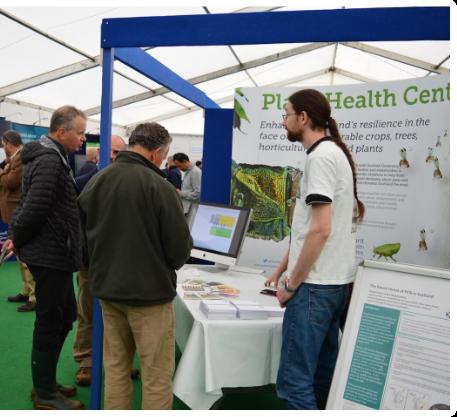




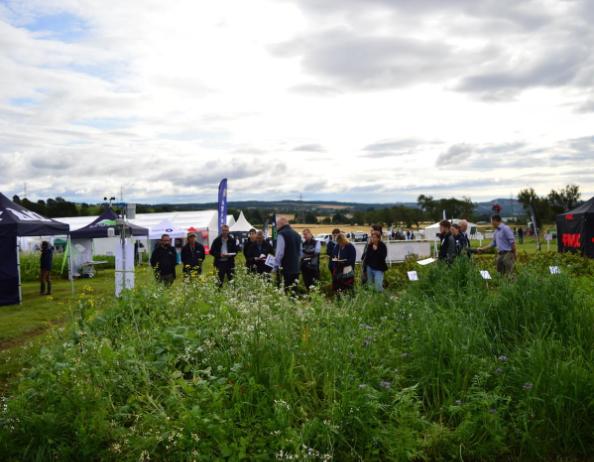


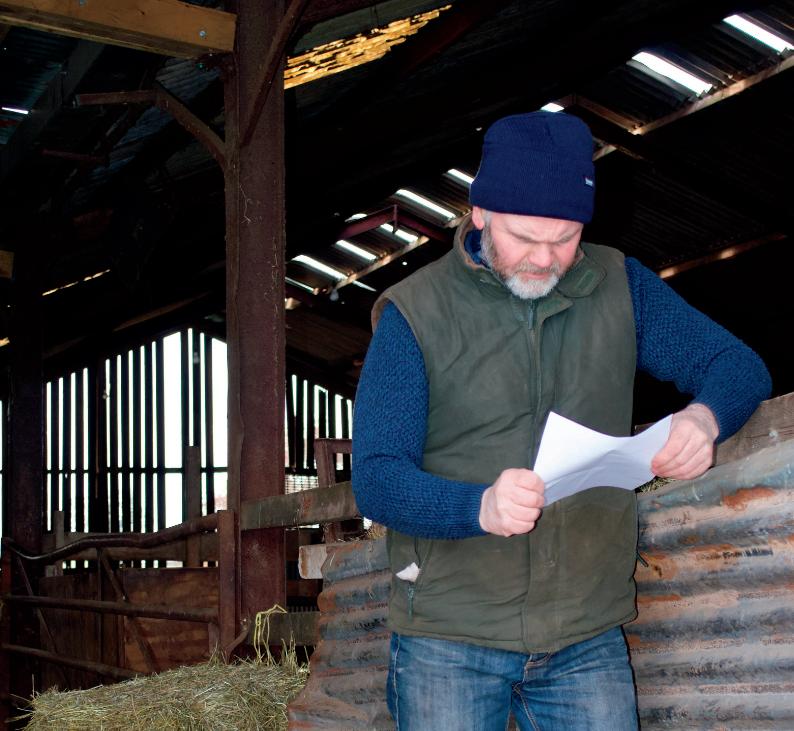









Tucked away in the rolling countryside of Norfolk, a remarkable story of resilience and generosity is unfolding—one that proves community spirit is alive and thriving in Britain today. At the heart of this movement is Heidi Glendenning, the trailblazer behind The Pantry Kenninghall, a community-led food hub that has grown from a simple act of kindness into a vital resource for hundreds of families.
"This isn’t just about food; it’s about dignity, connection, and empowering our community to thrive," says Heidi


Glendenning.
As a mum, a wife, and a dedicated volunteer, I never expected to find myself leading such a significant initiative. My background is in marketing, and before becoming involved with the Nourishing Norfolk Network, I knew very little about food poverty. However, during the pandemic, I saw a need within our community and acted. What started as delivering food boxes from my garage to residents quickly revealed the extent of hidden rural poverty.
Thanks to the support of the Norfolk Community




Foundation, The Pantry Kenninghall was able to expand, becoming an official food hub in November 2021. By September 2022, we had a physical space, and today, we support over 260 households—more than 650 members. Nationally, food hubs like ours have provided critical assistance to over 50,000 people, showcasing the pressing need for such initiatives in rural communities.
Our members receive free fruit, vegetables, bread, and period products, alongside essential food and toiletries at an average of 30% less than supermarket prices. Beyond food, we offer wraparound support services, including fuel assistance, school uniform purchases, transport help, cookery workshops, craft sessions, children’s birthday support, and Christmas hampers. Every week, our mindfulness café brings people together for activities like bingo, flower arranging, and conversation—a lifeline for those who may otherwise feel isolated.
Building on this success, we have now opened Thrive, our community café and workshop space at Redgrave and Lopham Fen, with a wonderful grand opening that I had the privilege to attend. Thrive is already demonstrating how vital these hubs are to the wider community, not only in terms of food security but also in fostering essential skills, knowledge-sharing, and overall wellbeing. The workshops and classes on offer provide hands-on learning experiences, whether it be cooking nutritious meals on a budget, learning a new craft, or engaging in mental health support sessions.




The programme ensures people can access the food they need now while also receiving the support necessary to escape food insecurity for good. It fosters deeper connections with food production, working closely with local farmers to source fresh ingredients and provide education on sustainable food practices. Their contributions of surplus produce, fresh ingredients, and financial support play a critical role in keeping these initiatives sustainable. These partnerships not only help reduce food waste but also strengthen the local economy, ensuring that good, wholesome food is accessible to all.
Additionally, the programme engages young people by welcoming Duke of Edinburgh students, offering them the opportunity to gain hands-on experience in community service, food sustainability, and social responsibility. This engagement helps instil a lasting

appreciation for the importance of food access and community support.
Thrive is part of a growing network of community hubs across Norfolk, each addressing the unique needs of their local areas while collectively working towards the same goal—ensuring that no one is left behind. These hubs serve as lifelines, providing a sense of belonging, opportunities for social interaction, and access to critical support services. Across Britain, this model of community-driven support echoes the age-old traditions of village life, where neighbours look out for one another and local resources are shared for the good of all. It is a modern extension of the British ethos—stronger together, supporting one another, and making do with what we must create something even greater.
Their work hasn’t gone unnoticed. It has changed lives, restored hope, and proven that community spirit is not a thing of the past, but a force that still thrives in places like Kenninghall. In March 2024, The Pantry featured on BBC Radio 4’s Feeding Norfolk programme alongside Delia Smith, highlighting the innovative ways communities are tackling food insecurity. In May 2024, we were honoured to receive the Excellence in Volunteer Management Award—a testament to the dedication of our incredible team of volunteers.
At its core, The Pantry Kenninghall is about more than food; it is about dignity, hope, and the unwavering spirit of community. As we look to the future, our mission remains clear: to ensure that no one in Norfolk faces food poverty alone. Through hubs like Thrive and many others, we are collectively building stronger, more resilient communities where skills, knowledge, and support networks can flourish.
The power of food to bring people together is deeply woven into the fabric of British culture. Whether it's sharing a hearty meal at a village fete, gathering for a Sunday roast, or simply popping in for a cuppa and a chat, food is at the heart of connection. In that spirit, initiatives like The Pantry and Thrive are not just feeding people; they are nourishing communities, strengthening bonds, and proving that the Great in Great Britain is, above all, its people.
Hear The Pantry Kenninghall on BBC Radio 4’s The Food Programme, exploring the power of local communities in the fight against food insecurity.

orger has launched a new cutting-basket macerator that helps protect wastewater/biogas pumps and downstream equipment by consistently


mashing solids.
Designed with pivoted cutting blades that adjust automatically, the OrbitGrinder operates at an even cutting speed, with its cutting basket’s blades arranged in a special star shape to maximise shredding.
Not only is flow through the OrbitGrinder’s cutting basket homogenous, but the baffle plate also ensures that the suction force of the pump is evenly distributed.

Compared to standard, round perforated disks, the circumferential speed of the Orbitgrinder’s blades is the same in every cutting point, delivering uniform macerating results. Macerators with round perforated disks also typically see excessive wear of the cutting plates’ outer edge, whereas the OrbitGrinder’s design and durability provides a significantly prolonged service life.
The OrbitGrinder’s simple inlet and outlet can

be positioned at different angles to suit, and with the top and bottom parts connected by standard screws, this highly effective new macerator can be easily integrated into any existing system.
As with all proven Borger equipment, the Maintenance-InPlace design makes servicing much easier than laborious alternatives. The OrbitGrinder benefits from a gas strut assisted quick-release cover. Impurities are sent into the debris collector.


hug Estate, near Corwen in Denbighshire, unveiled a series of innovative schemes and initiatives in the last 12 months, as it targets net-zero emissions.
Having introduced green energy projectsranging from 4KW to 5MW - including wind, solar, hydro and heat pumps – the 12,500-acre site invested in new technology to further lower its carbon footprint, notably an electric forklift.
Recent developments included the transition from standard cardboard and polystyrene mail order packaging to FSC (Forest Stewardship Council) certified cardboard boxes, and wool thermal liners to maintain cool temperatures and meat quality during transportation, saving more than one tonne of CO2 annually.

After securing a prestigious Royal Warrant of Appointment from His Majesty The King and Her Majesty The Queenone of just seven businesses in Wales to have been selected for the accolade - Rhug Estate owner Lord Newborough says they will do even more for the ‘circular economy’ in 2025.
“Every decision we make is to improve the service and quality of products we offer our valued customers and suppliers while ensuring we remain at the forefront of advances in technology and sustainable business practices,” said Lord Newborough. “In 2024 we set a new benchmark for the sector and there are plans to do more this year, as we strive to lower our carbon footprint and become even more energy efficient.
“The refurbishment of our headquarters was an example of that, as we installed external insulation and cladding and an air source heat pump, upgrades which should reduce heating related emissions by up to 4.5 tonnes of CO2e each year.
“Our farm shop and café have also seen improvements, with labelled recycling areas encouraging responsible

waste management in support of our waste reduction goals.
“We have also continued our partnership with Too Good to Go, and Field Fare, which offer frozen, loose, and individually packaged produce, helping to reduce waste, minimise packaging materials, and extend product shelf life.”
As a result of these and other moves toward net zero, the Estate achieved Planet Mark Business Certification, which verifies and measures carbon and social data to reduce emissions and achieve UN SDGs (Sustainability Development Goals).
One of the biggest transformations has been the ongoing trial of regenerative farming practices - such as minimum tillage, a rotational grazing process and cover cropping - to minimise soil disturbance, protect soil health, and ensure the land remains covered all year round.
Meanwhile, all feed for ewes is now grown on the farm, and the popular Rhug Wild Beauty range goes from strength to strength, a collection of products using ingredients foraged on-site.
“While these initiatives are focused on Rhug Estate, they hold us up as a beacon of best practice for the industry and demonstrate our position as a pioneer in sustainability, not just in North Wales but UK-wide,” said Lord Newborough.
“That is a top priority for us, helping to educate and support other businesses on their net zero journey and leading by example – we take that role very seriously.”
For more news and information, visitthe websitewww.rhug. co.ukand follow them on social media at @rhugestate.
For more information on Wild Beauty, visitwww. rhugwildbeauty.comor follow them on social media @rhugwildbeauty.











ill Bullen, the founder and CEO of Utilita Energy, has today announced his intention to lead the UK's solar revolution by forming a nationwide taskforce capable of installing solar PV systems for 500 domestic properties every month.The move is supported by a national advertising campaign urging Britons to 'Look up' and 'join the rooftop revolution.'
he is calling for mandatory solar panels on all new homes and a streamlined connection process.
Utilita CEO, Bill Bullen, comments:
"The government has set out its plans to triple solar power generation in the UK by 2030, and we are eager to lead this transformative journey.

Building on the firm's success in implementing low carbon technologies, having smart-enabled 92% of its customer base compared to the 65% industry average, Utilita is primed to install solar systems efficiently and confidently.
Utilita Home will offer households a straightforward, transparent online quote in just one minute, a complimentary site survey, and installation within 4-6 weeks. Customers can also enhance their systems with a solar battery solution and EV charger, furtherreducing their reliance on the grid.
The unique customer join journey includes a virtual solar survey within two working days, providing tailored home designs, including in-roof solar and flat roof installations. For reassurance and support, households are assigned a Home Energy Consultant indefinitely.
In addition to Bullen's leadership in the solar space,
"Rooftop solar is central to Clean Power 2030 and delivery of local, low-cost decarbonisation, reducing household energy spend, and is the most efficient way to ease the burden on the National Grid.
"With the cost of electricity for UK households set to rise again in April, solar PV generation has never been more cost-effective. Panel efficiency has dramatically improved over the last decade, while the price of panels has reduced, meaning the overall return on investment is better than ever.
"It's encouraging that there are discussions around how the government can support solar PV as part of its Warm Homes Plan. To maximise the impact, it's imperative that consumers can access batteries as part of any scheme. It is equally important that solar PV be mandated on all new builds as part of the Future Homes Standard.
"I'm also a strong advocate for streamlining the connection process and enforcing strict service level agreements, focusing particularly on reducing the approval time by Distribution Network Operators (DNOs). Simplifying this procedure would expedite the adoption of solar PV, enabling households to make investment decisions swiftly and enjoy both financial and environmental benefits without delay."
Utilita is currently undergoing a multi-million-pound investment round. This substantial capital injection is set to significantly boost the company's solar PV installation capacity, scaling up to 500 homes per month by the end of 2026.
For more information on Utilita's solar proposition, visit:https://home.utilita.co.uk/

leading North Yorkshire open-air attraction, Ryedale Folk Museum, has announced its latest exhibition, Farm / Mill / Bake. From Saturday 22 March, more than 50 stunning new photographs will go on display for the first time. It follows a special commission undertaken by celebrated documentary photographer, Tessa Bunney, renowned for her sensitive portrayals of rural and working life.
"The exhibition brings together the inspiring stories of farmers, millers, and bakers working to transform the way that bread is made across Yorkshire," explains Museum Director Jennifer Smith. "It's been a really exciting opportunity to work with Tessa to shine a light on these untold stories of sustainable bread production."
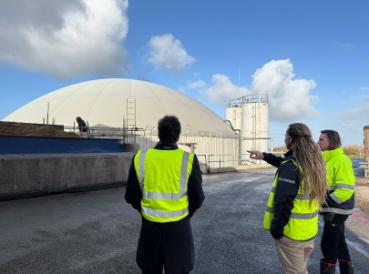
The story begins on small-scale organic farms, where individuals are working quietly to cultivate resilient and nutrient-rich wheat varieties that can thrive within their differing microclimates. "Many of us are largely unaware of the work taking place each day," says Jennifer. "We really wanted Tessa to document these stories, with her blend of insightful, sympathetic photography."
The exhibition has been made possible through a grant from the Farming in Protected Landscapes fund, managed by the North York Moors National Park Authority. Inspiration was sparked after a conversation with Nelly Trevelyan of Yorkshire Organic Millers, based at Hill Top Farm in the heart of the North York Moors. Many of those featured in the exhibition are connected to the organisation, either growing wheat for their mill or using their organic flour.
"Organic millers aim to preserve the integrity of the grains, producing less-refined flours," explains

Jennifer. "Then, in the hands of organic bakers who are typically embracing slow-fermentation methods, these flours are transformed into nutritionally rich breads. The exhibition celebrates the shared commitment of a great many people, at every stage of production, who come together to create bread that promotes sustainability and good health. "Tessa's images focus on the work taking place in Yorkshire, but they also offer a small window into the passionate network of farmers, millers, and bakers striving to revive heritage grains and traditional baking techniques across the country."
Tessa's previous projects have often centred on land usage, including the relationship between land and people, and Farm / Mill / Bake has been "a dream commission" for the artist. Tessa explains: "I love projects where I don't know much at the start – I really enjoy the detective work. Bread production is such a complex process, and, as the project developed and I learnt more, I really wanted to do justice to the work that is done."
Tessa continues: "Everyone I photographed really opened their lives to me. They have all been innovating in their own ways, making small adjustments along the way, and bringing so much care and passion to something as seemingly simple as a loaf of bread."
Farm / Mill / Bake can be viewed for free in the art gallery at Ryedale Folk Museum until Monday 5 May.
The museum and art gallery are open from 10am to 4pm in March and 10am to 5pm in April and May, from Saturday to Thursday (closed Fridays). There is no charge for entry to the exhibition. For more information, visitRyedale Folk Museum.

raham Heath Construction can help you build your next bespoke building, offering a range of options to create the ideal building for your herd. Building design is very important for maximizing animal comfort all year-round.
You need to carefully consider the roofing, ridge and cladding options for your building to suit your system. Graham Heath Construction, have a number of options to help improve ventilation in the buildings and to reduce the key factors like; excess heat, vapour & dust.
Let us talk over a few options for your building
First let look at the roof
Fibre Cement profile roof prove to be the most





popular for agricultural buildings, allowing natural ventilation and absorbing some condensation. They also come in a vast array of colours; Natural Grey, Jasper, Anthracite, Juniper Green, Black, Slate Blue, Van Dyke Brown
Most livestock buildings are designed with an open side and cantilever, this provides ventilation and an area for the cattle to feed with easy access for machines.
Next let’s move onto Ridge options
Fibre cement roof are also compatible with a vast range of ridges and accessories to suit every building type/use.





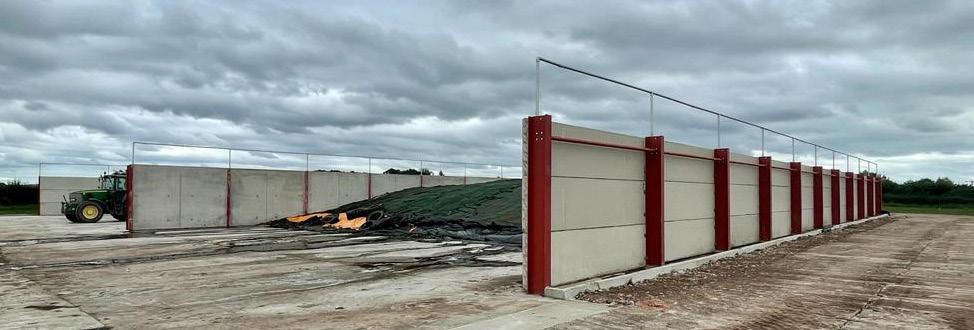











• Lightridge – designed to improve ventilation in livestock buildings and improve natural light transmission. Toughened waterproof PVC roof panels and wind guide plates will withstand most weather conditions.
• GHC Raised Ridge System – with this flexible system that can be set at a height determined to suit your cattle, the raised ridge system allows airflow were most buildings will accumulate warm, moist and stale air. The ‘Cap’ protects the inside from the rain whilst efficiently allowing the air to flow.
• Open Protected – With importance of airflow comes the importance of natural light which this ridge system offers. With a polycarbonate strip to minimise the driving rain, allowing natural light and potential to minimize the risk of heat stress on your cattle.
Cladding options …
Yorkshire Boarding is the most popular with livestock buildings. Installed with a 25mm-50mm gap allowing good airflow and ventilation in the building to help remove heat, moisture and even bugs!
Concrete Panels
90mm | Ideal for livestock walling
140mm | Suitable for retaining wall for grain, silage and earth
170mm | Great for excess weight loads for high walls

Concrete Panel walling gives you a costeffective and fast way of constructing grain storage, slurry storage and agricultural buildings.The concrete is easily cleaned and stays looking new.
To see the latest building offers from Graham Heath Construction visit https://ghconstruction.co.uk/offers/
If you are considering a new farm building talk to the today for advice and a free quote on 01270 781158
Or get a quote online at www.gh-construction. co.uk/quotation/



Driven by the simple principle of creating a healthy environment and that ventilation is not the volume of air in a building, but critically it is the rate of air exchange, simply clean air in and stale air out - Farmplus design and build to these principles.
Animals left to nature always try to find shelter in the basic form, they use hedges, walls & natural hollows to get out of or reduce the impact of the winds. Likewise, they will use trees for shade from the sun and shelter from the rain. When we look at buildings we should aim to replicate these basic principles of nature wherever possible. Remember that animals want in the basic form shelter from the wind, rain, shade from the sun, and plenty of fresh air. Ideally giving animals a shelter wall to be able to lie behind with a decent gap above for air to pass over. All air movements need to be above animal height so as not to create a draft.
Depending on the height of the wall, the gap above will often need some form of wind break material to reduce wind speed on bad days. The best and cheapest form of ventilation is and always will be natural ventilation using the stack effect with sufficient gaps at the low eaves and open ridges. No fans using electricity, no moving parts & nothing to breakdown, so no ongoing expense.
In very high rainfall areas, special ventilated ridge capping’s can be supplied. For most situations, the best ridge treatment is still, simple upturned flashing, for these will make the outside air lift over the ridge of the roof. The base of any upstand should always be at a minimum 50mm (2” inch) back from the top edge of the roof sheet, so any water/rainfall that hits the inside of the upright flashing can then drip of the heal and drain away down the roof sheet.
Animals left to nature always try to find shelter in the basic form, they use hedges, walls & natural hollows to get out of or reduce the impact of the winds. Likewise, they will use trees for shade from the sun.





ith the construction industry facing a significant skills shortage, it's especially important that plans are in place to attract and encourage talented young professionals to begin careers in building controls. This is especially pertinent given the increasing need for smarter and more energy efficient buildings.
That is exactly why the BCIA, in partnership with national training provider, Group Horizon Ltd, introduced the BEMS Controls Engineer Level 4 Apprenticeship back in 2021 – the only focused apprenticeship available to the building controls sector.
Three years on, the first cohorts of this scheme will soon be formally qualified as Level 4 BEMS Controls Engineers.
As an organisation that focused on individual development and nurturing the future of the industry, the BCIA very much acknowledges the need for a dedicated approach to apprenticeships, training, and ongoing support.
The aim of the apprenticeship scheme, and accompanying End Point Assessment, is to ensure talented BEMS Controls Engineers are able to use the technical skills they learn on the scheme to keep the buildings of tomorrow running as efficiently as possible. Furthermore, this will help to reduce the built environment's carbon emissions and ensure a healthier, greener, and more costeffective construction industry.
With the first cohorts approaching formal qualification in just a few months' time, it's important to acknowledge the hard work and dedication that's been put in, not only by the apprentices and their employers, but the trainers and End Point Assessors, too.
The close collaboration between all involved has been so pleasing to see and really highlights the drive and determination to reduce the skills gap and help apprentices obtain a high level of technical competence for the betterment of the industry.
In fact, the apprenticeship scheme, and EPA, works in a similar way to the Experienced Worker Assessment, which was brought in following the news that the Construction Skills Certification Scheme (CSCS) would no longer be issuing cards under industry accreditation – also known as Grandfather Rights.
With trusted and reliable ways of proving competence at both the start and latter years of a building controls career, it will be much easier to drive up competency throughout the construction industry and reduce the chance of tragic incidents like Grenfell Tower happening again.
The incredible demand for places in the apprenticeship scheme also reflects the desire to improve service quality and enhance knowledge across the sector. The total number of apprentices on the programme is around 180 and the 16th cohort has just commenced. As I mentioned above, the first three cohorts, totalling 45 apprentices, are currently approaching gateway between now and January.
The demand is such that there are typically two to three cohorts per year, each featuring around 20 apprentices. So, the rolling number of apprentices in training will sit at around 200. This is a great pipeline for the industry and illustrates the potentially bright future ahead – provided this talent is supported, encouraged, and nurtured.
I spoke at this year's BCIA Awards evening about the need for more experienced and dedicated industry professionals to become End Point Assessors – and while we've got a good number of industry assessors, we still need more. We currently have positions available for assessors in the North East, North West, and South West regions, so if you're interested in helping expand the knowledge of talented young professionals –and you're not already involved in another training capacity – the BCIA would love to hear from you.
Talking of the BCIA Awards leads me neatly on to next year's event. Now just a few months away (with how quickly this year has gone, it will be with us in no time), the BCIA Awards 2025 entries are now open. With 10 categories available and competition expected to be as fierce as ever, the evening promises to be an exceptional spectacle and one that will shine a spotlight on the incredible talent and innovation throughout the building controls sector. If you would like to enter one or more of the award categories, you can do so by using theonline entry system, which will allow you to start, edit, view, and download your entry before submitting it.
Tickets and tablesare also available, so don't hesitate to get in touch if you'd like to attend. The BCIA Awards 2025 looks set to be the biggest and best yet, so it won't be one to miss!
Ahead of the spring application season, farmers, growers and distributors of plant protection products (PPPs) are urged to guard against well-organised criminals seeking to raid secure storage facilities.
TheAgricultural Industries Confederation(AIC)is warning farmers and growers to be wary if offered PPPs for sale from unknown or suspicious sources following break-ins at two distributor stores in Bedfordshire and Norfolk in recent weeks.
Thieves used tools to cut through fencing and buildings, gaining access to PPP storage units before stealing significant quantities of valuable products.
The UK’s agri-supply trade association said that crop protection and agronomy companies and farm businesses should be on high alert for the risk of further thefts in these areas as well as throughout the country, and also consider reviewing their security arrangements.
AIC'sHead of Crop Protection & Agronomy, Hazel Doonan, said: "In light of these thefts, businesses which store professional plant protection products may wish to check that own their security measures are sufficiently robust.
"Farmers and growers are reminded to only purchase PPPs from reputable suppliers. A professional PPP supplier must employ a member of theBASIS professional registerto give advice on professional PPP use.
"Using PPPs that are of unknown provenance can risk business reputation, the acceptance of end produce treated with the product, farm assurance status, and even prosecution."
If you are suspicious of any products being offered for sale, contact theHealth and Safety Executive (HSE)by emailingCRDEnforcement@hse.gov. ukimmediately.

The UK's leading rural insurer NFU Mutual has called for a Machinery Theft Bill in Scotland at a drop-in event for MSPs in Holyrood this week.
Sponsored by NFU Mutual, the rural crime drop-in session at the Scottish Parliament was hosted by Rachael Hamilton MSP on Thursday 6thFebruary following First Minister's Questions.
Representatives from NFU Mutual and police officers from the National Rural Crime Unit attended to discuss the issue of equipment and machinery theft across Scotland.
The session not only demonstrated the impact rural crime has on farmers and the wider community but encouraged Scottish politicians to consider legislative solutions to deter and tackle future incidents. NFU Mutual is calling for a Machinery Theft Bill in Scotland similar to the Equipment Theft (Prevention) Act in England and Wales.
NFU Mutual Rural Affairs Specialist Hannah Binns said:"Machinery and equipment are vital for Scottish farmers and crofters to complete their dayto-day work and feed the nation, and theft can cause needless delays and disruptions.
"Growing up on a family farm, I understand rural crime impacts more than the practicalities of farming; it can leave farmers feeling vulnerable in what is not just their workplace, but often their family home. It's also second guessing yourself, and the worry that those responsible could return in the future.
"All indications suggest rural crime is becoming more organised and determined in nature. It is clear that co-ordinated efforts from insurers, farmers, manufacturers, police and politicians are key in providing a united response to the challenge presented by organised criminals and opportunistic thieves.
"A Machinery Theft Bill in Scotland could help deter and prevent future thefts, and we look forward to

working with industry and lawmakers to push this forward."
Superintendent Andrew Huddleston, National Rural Crime Unit and NPCC lead for stolen construction and agricultural machinery, said: "I am very pleased that so many Members of the Scottish Parliament have shown such great interest and support for the call to insist on valuable machines having basic security to reduce thefts in the first place and forensic marking so we can stand a chance of returning it to its owners."
Rachael Hamilton MSP said: "The costs of crime across rural Scotland have soared in recent years and far too many rural residents and businesses are worried they will next to be targeted.
"I know this from my speaking to people in my own Borders constituency and I am determined we will get tough on rural crime. Those living in these communities are paying far too heavy a price simply due to where they live.
"I was delighted to bring NFU Mutual and the National Rural Crime Unit to the Scottish Parliament this week to discuss what more we can do to tackle rural crime.
"We have seen tough measures to prevent equipment theft passed down south and I am urging the UK Labour government to release the consultation responses in relation to that bill to allow us to deliver the same benefits to Scotland."
The Equipment Theft (Prevention) Act in England and Wales, brought into law in 2023, aims to prevent both the theft and re-sale of agricultural equipment such as quad bikes and ATVs,by ensuring immobilisers and forensic marking is fitted as standard and a registration database is created.
NFU Mutual invested more than £400,000 in 2024 to help tackle rural crime across the UK, including funding for the Scottish Partnership Against Rural Crime (SPARC).


Sticking to a traditional May cutting date for making first-cut grass silage could be putting winter milk yield at risk, a silage specialist is suggesting.

According to Amanda Clements, Ecosyl technical business manager at Volac, recent seasons indicate that dairy farmers who take first-cut grass silage during April or very early May, rather than at the traditional timing of 10 May onwards, can end up with better overall silage quality.
“We saw this in 2024,” says Amanda, “but we’ve also seen it in previous seasons. It’s potentially down to two reasons.
“Firstly, with the generally mild winters we get nowadays, grass growth doesn’t seem to truly stop. So by the time mid-May comes around, swards can contain a lot of overwintered, dead or dying grass in the base. This thatchy material is of poor nutritional quality for milk production, but it’s also likely to contain increased numbers of unwanted bacteria. These can interfere with how well the silage ferments.
“The second reason is if you set out with a target cutting date of around 10 May, but cutting becomes delayed due to contractor availability or poor weather, grass can rapidly go to head at this time of year.
“When this happens, grass becomes more stemmy and fibrous, and therefore less digestible, and its metabolisable energy (ME) might fall from 11.5 to 10.5, which could lose 5-6 litres of milk/cow/day.
Added to this, stemmy grass is more difficult to consolidate, which can add to fermentation problems and lead to silage heating in the clamp.” By seizing available weather windows to take a slightly earlier first-cut, Amanda says it can reduce the chance of these problems occurring, as well as removing the poorer quality, old and overwintered grass, and stimulating fresher sward growth for the next cut. “An early first-cut could be especially beneficial if you haven’t grazed off old grass with sheep over winter,” she adds, “or have an excess of overwintered growth.
“An early first-cut might not produce a lot of yield in some cases, but it paves the way for a better second cut, and farmers who follow this approach can get into a position where they already have two cuts ‘banked’ by June.
“If you’re able to maintain this momentum of taking each cut before grass turns stemmy, you stand to harvest grass that’s higher in digestibility, and therefore ME, for the rest of the season. Younger grass also tends to be higher in protein, and because each cut will be lighter than if leaving grass to bulk up, it should wilt faster. This means less chance of being caught out with mown grass lying in the field if it rains.
“Cutting earlier might mean you increase from taking three cuts to four or five cuts over the year. But we’ve seen from our on-farm research that cutting more often yielded more grass over the season, and the value of the extra yield and quality outweighed the extra contractor costs. If the quality of one cut does become affected by the weather, it will also represent a smaller proportion of the total amount of silage made. And by using different cutting dates to other farms in the area, it can improve contractor availability.”
Timely cutting remains particularly important during summer months, says Amanda, because in hot conditions grass goes to head and becomes stemmy even sooner. But as well as using more timely cutting to produce better silage, it is important not to overlook the silage quality benefits of using a proven additive, she adds.
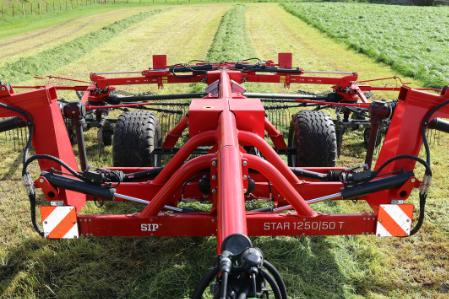
“Ecosyl additive is proven to boost the speed of fermentation and to preserve more dry matter and better silage ME,” she says.
“Feeding cows a range of silages preserved with Ecosyl in independent trials also boosted average milk yield by an extra 1.2 litres/cow/day.”

Pedigree Livestock Services (PLS) is delighted to announce a new partnership with the Beef Shorthorn Cattle Society, effective 1st March 2025. This collaboration marks an exciting development for both organisations, as PLS takes on the role of administrative partner for the society.

Under this new arrangement, PLS will manage a comprehensive range of services for the Beef Shorthorn Cattle Society, including administration, registrations, membership enquiries, and DNA enquiries. This partnership aims to streamline operations and enhance efficiency for society members.
Andy Ryder, Managing Director of PLS, commented, "We are delighted to join forces with the Beef Shorthorn Cattle Society. Our team's extensive experience in livestock society administration will ensure a smooth transition and improved services for all members."
John Scott, President of the Beef Shorthorn Cattle Society, added, "This partnership with
PLS represents an exciting new chapter for our society. We are confident that their expertise and innovative approach will greatly benefit our members and contribute to the continued growth of the Beef Shorthorn breed."
As a family-owned business with decades of industry experience, PLS understands the unique challenges faced by livestock societies and breeders. Our team of industry experts is dedicated to reducing costs and allowing members to focus on what matters most – their herds and the advancement of the Beef Shorthorn breed.
This partnership reinforces PLS's position as a leading provider of administrative services to livestock societies. With its tailored approach and comprehensive range of services, PLS continues to support the agricultural community in navigating the ever-changing landscape of the industry.
For more information about this partnership or to learn how PLS can support your livestock society, please contact our office.

K sheep meat production is forecast to grow by 2% in 2025, reaching 272,000 tonnes, according to the latest analysis from the Agriculture and Horticulture Development Board (AHDB). This increase is largely supported by a higher carryover of lambs from 2024, which will contribute to higher slaughter numbers in the first half of the year.
However, imports are anticipated to fall by 13%, largely due to higher domestic supply, although they remain historically high.
In terms of domestic demand, retail and foodservice consumption of lamb is projected to decrease by 2% year-on-year following the exceptional demand in 2024. This is attributed to a combination of economic uncertainty and an expectation of fewer promotional deals.

However, the lamb crop for 2025/26 is predicted to fall by 2% compared to the previous year, bringing the total to 15.5 million head. This decline is primarily driven by a reduction in the size of the female breeding flock, which has been shrinking steadily, and is forecast to reduce by 2.5% year-onyear.
Becky Smith, AHDB Senior Analyst (Livestock), said: "The reduction in the breeding flock is a key concern for the long-term sustainability of the sheep meat sector. While the carryover of 2024born lambs will boost slaughter numbers in the short term, the overall forecast for 2025 reflects ongoing challenges in maintaining flock sizes, which will impact lamb production in the years to come."
Despite a slight reduction in the overall lamb crop, demand for UK lamb is expected to remain robust in some markets. Exports are forecast to grow by 0.9% in 2025, primarily driven by continued demand from the European Union, with France being the largest market for UK sheep meat.
Becky added: "The economic climate will certainly play a role in shaping consumer demand for lamb in 2025. With less emphasis on deep promotions and potentially lower spending, we expect some softening in demand. However, addedvalue products like ready-tocook lamb cuts and meal deals could help sustain interest in the category, especially in the retail sector."
Production of lamb in the first half of 2025 is expected to be higher, thanks to the carryover of lambs, but clean sheep slaughter in the second half is predicted to remain steady. This more typical slaughter pattern, coupled with the expectation of stable carcase weights, means total production for the year should see a modest increase.
As the sheep meat industry heads into 2025, the ongoing challenges of a smaller breeding flock, potential disease risks, and the unpredictability of weather conditions could influence the sector's stability. However, with targeted marketing efforts, including AHDB's successful 'Let's Eat Balanced' campaign, there may be opportunities to encourage consumers to continue enjoying lamb, despite the anticipated economic pressures.
Find out more in ourLamb Market Outlook. We will be releasing Agri-Market Outlooks for Lamb, Pork, Cereals, Oilseeds and Farm inputs (feed, fertiliser and straw) over the coming weeks.
For more information on market trends and forecasts, visit the AHDB's livestock pages or follow updates on the upcoming developments in the sheep meat sector.
Dairy cows can consistently thrive on an optimised, soya-free diet, producing more milk from forage while maintaining milk quality. That’s according to new research by Wynnstay, Trouw Nutrition, and the University of Nottingham.

The initiative, conducted on the University’s 400head herd of Holstein Friesians, resulted in a 4.8kg increase in milk per cow compared to 2023. Additionally, milk urea levels dropped from 249mg/litre to 176mg/litre, signalling improved protein efficiency.
The move was driven by the University’s goal of reducing farm emissions and improving its overall carbon footprint per kg of fat and protein corrected milk (FPCM), in line with milk buyer expectations.
The diet shift, fully implemented in March 2024, replaced soya with rumen-protected amino acids, protected rapeseed meal and rumen energy sources, while reducing crude protein levels from 17.5% to 16.7%. Starch content increased from 18% to 22.5%, further supporting milk yield and fertility.
Since moving to a 100% soya-free diet the cows have consistently outperformed their previous production levels thanks to a better balance of nutrients.Other key findings from the transition revealed forage intake rose by 14%, leading to a significant boost in milk produced from homegrown forage. This contributed to more than a 10% reduction in CO2e per kilo of milk, and a decrease in the diet impact per portion from 37kg CO2e to 21kg CO2e.
Speaking at a dedicated press event at the University's Centre for Dairy Science Innovation, David Howard, Wynnstay's Head of Dairy, emphasised the importance of these findings for the wider industry. “We’ve proven that cows can thrive without soya in their diet, which is a huge step forward in reducing the carbon footprint of dairy farming,” he said.
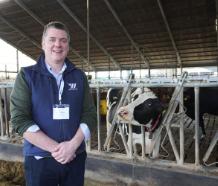
“Our approach not only benefits the environment but also supports the farm’s profitability by increasing milk from homegrown forage. Our results show that rethinking ration formulation with amino acid precision can unlock efficiencies and deliver better results for both cows and the planet.”
Looking ahead, the team aims to exceed 5,000kg of milk from forage per cow, and will focus on further refining feeding strategies for first-lactation heifers to maximise growth and efficiency.
Wynnstay’s commitment to sustainability aligns with the global push to lower agricultural emissions, in which theUK already outperforms global averages with an estimated 1.24kg CO₂e/kg of FPCM compared to the global average of 3kg CO₂e/kg.
"This trial demonstrates how innovative approaches in dairy nutrition can help close the gap even further," added Mr Howard.
The University’s Dairy Herd Manager, Nigel Armstrong, echoed the enthusiasm for the findings. “We have only seen positive results around higher milk yields, greater forage intake, and lower urea levels,” he said. “As a high production commercial herd operating within a University, we aim to lead in dairy innovation. I just wish we had done it sooner.”
Dr Liz Homer, Sustainability Manager Ruminants Europe at Trouw Nutrition, said: “It is important to review all diet changes for their impact on productivity, profitability and the planet.
“It is key for all feed advisers to review the whole diet and question why high emission raw materials are being used, and if there is a better alternative. Feed is one of the biggest contributors to carbon footprint and there are quick wins to reduce emissions by reviewing the diets, which have a positive impact straight away.”



dairy farmer and farm vet have joined forces to launch a new device to improve management, health and welfare of ‘down’ cows, as well as staff safety.
CowRecovery is a new handling system based on a specially modified telehandler bucket and moving technique designed to maximise cow welfare while minimising the risk of injury – to both the cow and staff. Launched at Dairy Tech in early February, the system has been perfected by farmers and vets in an extensive field trial involving 15 leading UK dairy farms and more than 10,000 cows over a 10-month period.
“Moving animals in a welfare friendly way is often a challenge due to a lack of manpower, limited availability of appropriate equipment and poor training of farm staff. Having spent over 30 years farming and dealing with the challenges of moving down cows, I decided it was time to make a change.”
The cause of a ‘down’ cow – which is unable to stand - can be caused by a difficult calving, milk fever, grass staggers, metritis, mastitis, a bone fracture or nerve paralysis. It’s important that cows are moved to a well-bedded yard, with food and water in easy reach, and are medically treated. They should also be helped to shift sides at least twice daily to release the pressure on their muscles and nerves.

It comes with a comprehensive training programme developed by Synergy farm vets to ensure safe and consistent use, as well as straps and a halter.
The system is the brainchild of James Yeatman, who milks 400 cows in north Dorset. “Dealing with a ‘down cow’ is a common incident on farm and is a distressing experience for both cow and farmer,” he says.
“The cost of a fatality in early lactation is estimated to be £3,499, so saving less than two cows over the lifetime of the device will repay the investment,” notes Sam Gayton, commercial director at Synergy Farm Health.
The device, with its green and white ambulance livery, is manufactured by Albutt, which has a reputation for making very high-quality equipment designed to last a lifetime.
“Overall CowRecovery will improve the lives of cows and the people who care for them,” says Mr Yeatman. “Farmers will be encouraged to create a heat map of incidence, which will be reviewed with their vet to create an action plan to reduce down cow incidence.”
CowRecovery is on the market for £4,995 including delivery anywhere in the UK. For more information visit www.cowrecovery.com
UK pork production is expected to remain steady in 2025 according to the latest analysis from the Agriculture and Horticulture Development Board (AHDB). Limited growth in breeding herd numbers and continued pressure on export markets due to geopolitical tensions are also forecast.

However, a thriving foodservice sector and evolving consumer demand for convenient, affordable cuts of pork provide opportunities for the industry to navigate challenges in the year ahead.
Freya Shuttleworth, AHDB Senior Analyst (Livestock), said: "While the pork market faces challenges such as fluctuating export demand and rising geopolitical uncertainties, we are seeing signs of resilience. The continued growth of the foodservice sector and increasing consumer interest in value-driven cuts of pork offer potential areas for optimism. The industry's focus must remain on meeting the evolving needs of consumers while maintaining high standards of welfare and sustainability."
UK pork production is anticipated to remain stable in 2025, with clean pig slaughter volumes reaching approximately 10.32 million head, a slight decrease of 0.1% compared to 2024. Average carcase weights are expected to remain at around 90kg, in line with performance from previous years. While the size of the UK breeding herd is forecast to rise by 1% to 330,000 head by June 2025, long-term growth remains limited, with the herd expected to return to 2023 levels by 2027.
Despite these relatively small changes, productivity improvements have been a driving force in the sector.AHDB's quarterly estimated cost of productionhas seen a slight decrease over the course of 2024, contributing to positive industry sentiment and net margins of £15 per head. However, ongoing uncertainty, including economic challenges and fluctuating costs, continues to impact producer confidence, especially as some producers exit the industry.
The outlook for trade in 2025 is mixed, with geopolitical tensions and market volatility continuing to affect UK exports. The EU remains the UK's most significant trading partner, with over 99% of UK pig meat imports and over 42% of exports coming from the region. However,
demand from the EU is expected to decrease as EU consumption weakens.
Despite these challenges, there are brighter prospects in markets like Southeast Asia, where African Swine Fever (ASF) has impacted local production. Therelisting of two UK processing sites for Chinaand the potential for stronger trade ties with countries like South Korea could help offset weaker demand from traditional markets.
Retail demand for pig meat is likely to remain under pressure in 2025 due to economic challenges and fluctuating consumer perceptions around the health credentials of pork. However, the continued growth of the foodservice sector, particularly in dining out and on-the-go meal occasions, presents a valuable opportunity. Consumers are seeking affordable, convenient meals, with pork well-suited to quick, tasty options such as sandwiches and savoury pastries.
Vanessa Adamson, AHDB Retail & Consumer Insight Manager, said: "As we continue to face economic pressures, promoting the nutritional benefits and versatility of pork will be key in encouraging consumers to incorporate more pork into their meals. With increased interest in affordable meal options and a growing foodservice sector, there are significant opportunities to expand pork consumption, particularly through convenient products like sausages, burgers, and pre-prepared cuts."
To enhance the outlook for pork consumption in 2025, industry players are urged to focus on communicating the health benefits of pork, such as its rich vitamin and protein content. Additionally, promoting versatile recipes, batch cooking ideas, and affordable meal options will help capture consumers' interest. Premium cuts of pork should also be marketed as indulgent, treat-worthy options to appeal to those seeking high-quality, cost-effective dining experiences.
In response to these challenges and opportunities, AHDB is launching its 'Love Pork' campaign and other marketing activities throughout 2025 to encourage increased consumer engagement with pork.
Find out more in ourPork Market Outlook. We will be releasing Agri-Market Outlooks for Cereals, Oilseeds and Farm inputs (feed, fertiliser and straw) over the coming weeks.

The RamCompare project is celebrating its tenth year and is seeking new rams to join the 2025 breeding season.
The national progeny test, joint-funded by the Agriculture and Horticulture Development Board (AHDB) and Hybu Cig Cymru(HCC), once again needs rams or semen from performance-recorded, terminal sire breeds.
Launched in 2015, the project tests terminal sire rams with Estimated Breeding Values (EBVs) in the top 20% of their breed. Natural service sires should be shearlings or stock rams with a known, high health status. Older stock rams are welcome providing they are fit and fertile. The project also purchases frozen semen in batches of 30 doses for use via artificial insemination (AI).
Bridget Lloyd, RamCompare project coordinator,
said: "This is a great opportunity for breeders to get involved. Testing their ram's genetics within the national progeny test will provide them with important data which can be used to promote future ram sales.
"Improving efficiency and reducing costs are key drivers for any business. Nominating rams to RamCompare allows breeders a unique opportunity to gather information which can demonstrate how their rams could benefit individual enterprises for potential buyers."
Matt Harding is the owner of the Bentley Suffolk flock and has supported the project for many years and is enthusiastic about the benefits it brings to his business: "Putting our stock rams onto RamCompare via AI is a great opportunity to test them while retaining their genetics for our own flock.

"Progeny performance is recorded on commercial farm settings, with growth data collected from birth through to slaughter. This vital feedback allows us to ensure we are moving our flock genetics in the right direction, and we are excited to see how our latest rams have performed."
Since RamCompare's launch, over 503 rams have been tested, producing more than 48,000 lambs, helping farmers select high-performing sires whose progeny deliver valuable carcases and reduced production costs.
Samuel Boon, Senior Animal Breeding Manager (Signet) said: "This is an exciting time for the project, with Signet set to release genomic breeding values for abattoir traits. It is great that breeders like Matt recognise RamCompare results as valuable when marketing rams. Practical demonstration of the benefits of breeding values to
aid commercial ram selection are vital."
For more information,visit:ramcompare.com. Nominations close on Friday 16 May 2025. You can access the forms directly through the following links:
• Ram nominations
• Semen nominations
You can also contact project coordinatorBridget@Bridget-Lloyd.comdirectly for more details.
For technical information about performancerecorded terminal sires visitPublications | Signet Breeding (signetdata.com)

USD Feakes Farm Servicesis a family run Agricultural Contracting business based in the heart of West Sussex, operating for over 30 years. They provide all aspects of grassland, livestock and arable management for their customers. Due to their busy contracting work and their own farming operations, they recently invested in the SlurryKat umbilical system for spreading, to help combat "a tricky season with weather," Jack Feakes, Farm Manager commented.

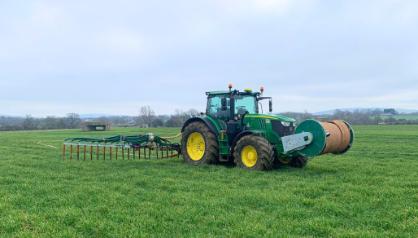

"600 acres of beef cattle, sheep and haylage production," Feakes explained.
The SlurryKat "umbilical setup enables us to move a lot of slurry when ground conditions are less favourable and our SlurryKat tanker works to move slurry further afield in the summer months." Their own farm includes
Alongside their own farm, SD Feakes run their agriculture contracting business to dairy farmers. Their customers farmland ranges from 90 acres to 400 acres, requiring them to

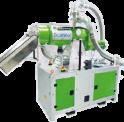





spread at varying distances per farm, including "up to 1600m."
For slurry, SD Feakes operate the SlurryKat umbilical spreading system, including Premium Plus™ 12m Duo Dribble Bar with GPS rate control, 1000m BakPak™ Reeler with Oroflex 5 inch pipe, Premium Plus™ 600m Front Reeler with Oroflex 4 inch pipe and 3500G Tanker with 7.5m Farmline Dribble Bar.
"We invested in the SlurryKat umbilical system in 2022. The SlurryKat system is the best one to have, as it is high quality and a straight forward setup," said Feakes. All SlurryKat products are expertly designed to seamlessly integrate together, being engineered to connect easily. This is a unique, userfriendly feature on all SlurryKat equipment, compared to other slurry handling manufacturers on the market.
Jack Feakes continued, "I've been really impressed with the quality of build on every SlurryKat machine we have purchased. The umbilical system is great."


The SlurryKat umbilical system allows the user to spread further and faster, no matter the distances or conditions. "I've been very impressed from the get go in terms of output, we can comfortably achieve 9001000m3 per day with multiple field changes and if we're in good sized fields, we've had quite a few days up to 1500m3 per day. Having a combination of 5 inch to 4 inch Oroflex hose enables us to keep output very high with minimal down time."
Minimal downtime is critical and the umbilical system has been fantastic, both SlurryKat front and rear reelers are built very strong and require very little maintenance." He added, "The SlurryKat couplings are brilliant. They're seriously strong and easy to use, due to the swivel system design."
On their other SlurryKat machinery, Jack commented "The SlurryKat tanker again has been great, the 8inch lazy arm it takes no time to fill up and saves a huge amount of time when filling."
"We've had a tricky season with the weather (2024) meaning most of our customers had first cut picked
up within about ten days. We were running the tanker on jobs we would normally umbilical and I was very impressed with how low the cost per cube was with the tanker, on short distances and very close cost wise to the umbilical, which kept our customers very happy. Feakes went onto say, "it's very nice to tow on the road, you barely know it's there."
"The 12m duo dribble bar is nice and light in the field which is great when the ground is soft." At SlurryKat, we aim to maximise crop fertilisation and nutrient uptake, without disrupting the plants, or compacting soil. The light weight design of our equipment lets the user benefit not only for time, fuel and efficiency, but environmentally and crop yield also.
SD Feakes purchased their machinery from their local SlurryKat dealers MJN Tractors Ltd and Haynes Agriculture Ltd. We want to thank SD Feakes for choosing the SlurryKat multi-awardwinning system.


t its dairy operation in the Yorkshire Dales, the introduction of new separators has given Metcalfe Farms the opportunity to futureproof the pumps it uses to transfer large volumes of slurry from its 2,000 (1,300 dairy) cows.
Separating slurry has undoubted benefits, but putting together a streamlined slurry transfer system covering three tanks, has presented plenty of challenges, especially with the need to feed the site’s 200kWh biogas plant.
Aside from the separators, one of first issues was to address the final pump in sequence
that ultimately sends slurry (about 6% to 8% dry matter) about 120 meters (and 10 meters of lift) up to the 3,500m3 anaerobic digester.
Annoying bits and pieces inevitably find their way into slurry, which was enough to make the pump block quite regularly.
“I used to dread coming down here to sort it out,” said Robert Metcalfe, who oversees all things engineering on the dairy side of the business.
“The pump did an okay job when working but wasn’t the best with solids. It wasn’t a pleasant job spending over an hour unblocking it each time; a two-man job, so all very time-consuming, especially having to retrieve it with a pipe because there was no clutch at the bottom.”

That’s all changed now with the old unit replaced by a Chopper Pump made by Landia, who also supplied an integrated guide rail and a bespoke pipework system for easy access and lifting.
‘It is much a better design’
“Everything flows through so much smoother now,” added Robert. “It is much a better design. You don’t have to worry about any sort of pipe bending or extra weight of the added pipe. Generally speaking, the new pump doesn’t block, although just recently a large chunk of rope stopped it! But unlike before, it’s now a job for one person, and on this occasion, only took 20 minutes before simply lowering it back in again.”
‘Digestate from the AD plant provides significant benefits’
At the biogas plant, which is run by Iona Management Services, a second CHP (combined heat and power) engine has recently been added, which will help increase the amount of clean energy that is exported to the grid. Metcalfe supplies a slurry-only feedstock to the AD plant, and then buys power back at a discounted rate for its own use. In the winter this is around 300 kilowatt hours, rising to 360 kilowatt hours in the summer. In addition to providing power for the dairy and the sell-on to the grid, the digestate from the AD plant also provides significant benefits, as Robert Metcalfe explains:
“The digestate does wonders for our grassland. We spread a little bit on the crops, but it’s mainly focused on the grass. This year we did five cuts over 1,000 acres. We hardly spend anything on chemical fertilizer now.”
Working closely with Landia to look at how best to integrate the new separators, a 22kW pump was chosen to manage the slurry feeding task, with an existing longshaft Landia pump moved up from its existing task on another tank.
“We’ve had this pump since 2004,” added Robert Metcalfe, “which has understandably endured plenty of wear, but when tested by Landia engineers during a service, the 20-year-old unit was still happily pumping full pipe, which I have to admit, I was pleasantly surprised by. Now that we have separators, we can remove solid material to reduce our environmental impact.”
To replace the old long shaft unit, a new 7.5kW Landia Chopper Pump has now been installed so that slurry levels don’t rise. Meanwhile, the existing Landia long shaft chopper pumps, which have already been in service for 20 years, since Metcalfe had its first shed, continue to work away.




‘Far less hassle’
Robert Metcalfe continued: “The pump at the front of the loop system that has been created gets plenty of pain, so no surprise it’s had some repairs over the years, but steadily pumping away, it, with the others, has ensured that the dairy’s channels never fill up. We’ve found that by keeping our channels narrow, the pumps keep them flushed out completely, whereas with wider channels, the whole thing would still need flushing out. Now that we have it all set up on timers, it’s seamless, so far less hassle.
“The Landia pumps are very strongly built things, and I like the fact that they are electric and quite modular, so we don’t have to hook up to a tractor. This very much fits in with what we constantly work towards with fewer engines turning and less burning of diesel. One Landia pump we’ve had now for three years, and it’s never given us a bit of trouble.”
Over in the Metcalfe milking parlour, Robert has been glad to see the back of having to replace small vortex pumps that blocked or
blew completely, even though the liquids are very watery.
Heexplained: “As soon as any foreign debris or plastics came into play, straining the pump,we were having to buy a new one almost every six months due to burnout or component failure,soastheyclearlyweren’t up to the job,I called Landia forhelp. Also, the pump(s) had been installed on winches and over time, blockages and sediment buildup forced us to keep raising the pumps closer to the top of the tank,which in turn meant we ended up with sediment right upto the mouth of thetank.
‘Since we’ve had it installed, we haven’t had to touch it’
“We now have a new 5.5kW Landia pump that just flies through any debris or solids, which are an inevitable part of dairy wastewater/slurry. Nothing settles out with this new, much faster pump. It’s absolutely spot-on, and what’s great is that it is completely automatic. Since we’ve had it installed, we haven’t had to touch it. You can configure it so that in this case it knows we want to keep this tank pumped out and empty. The sensor knows the tank’s dimensions and capacity. It is so much better than what we're doing before.”
Synching the pump operation, together with the investment in separators is just part of how Robert Metcalfe is helping focus on improvements to help take the diary part of the business forward, but without expanding too quickly. The dairy provides around 45 tonnes of milk per day to Paynes Dairies at Boroughbridge. Exceptionally high animal welfare standards for the Metcalfe cows continue to see a rise in yields.
“Going forward,” said Robert, “everything matters, even the little things. For all its benefits, we’d possibly consider sand bedding, but I don’t think our slurry channels would take it, and there’ such a big wear factor on pumps and machines. The sawdust we use is perfect, apart from the price!
“We’ve also been improving the lighting for

our cows, again with some help from an automatic, dimmable system. Previously in hot summer spells, you could see that our cows were uncomfortable, which we don’t want. The milk output would drop. As well as the lighting, we’ve also put up new roof sheets to block out any intensive heat, which has made a big, positive difference.”
He concluded: “In time here we will probably phase out other brands of pumps as they come to the end of their life or cause problems, and just stick with Landia. I think it helps that they focus on pumps, rather than some who try to provide everything, plus we always get very good backup and no problems with the supply of spare parts.”

pearhead Machinery has appointed Jack Wyatt as Director of Sales and Marketing as the British manufacturer looks to unveil new machines in 2025.
Following the departure of Antony Prince, who recently became General Manager of Alamo Group The Netherlands, Jack Wyatt now leads the team at Spearhead.
Jack joined the company in 2021 having completed an Agricultural Engineering degree. He has since gained broad experience across the company, most recently as Export Sales Manager under the mentorship of Antony. Jack has also been closely involved in product development, liaising with both customers and the Spearhead engineering team to develop new features on various machines.
Comments Jack Wyatt, Director of Sales and Marketing at Spearhead: “I’m delighted to follow in Antony’s footsteps and succeed him as Director of Sales and Marketing. Having worked together for several years, I share his innovative vision and our customer-focused approach that ensures Spearhead leads vegetation management machinery.” 2024 was the second-best performing year to date for
Spearhead. Working with an established network of dealers and distributors across the UK and overseas, the company unlocked several new markets. These included winning a 100-machine contract for the Danish Armed Forces (via Danish Agro) to help maintain green areas, shooting ranges, and airfields.

Moving into 2025, Spearhead plans to launch several new machines along with updates across the full product range. The most exciting for reach arm customers is a new range of attachments that will be targeted at professional users across the world. New developments are also imminent for rotary mower customers in the coming months.
“We’re keen to support all our customers with strong and reliable machines while growing the Spearhead brand in all sectors and markets around the world. With direct user feedback and a skilled UK manufacturing base, we’ll continue adding further value to every machine purchased,” says Jack.
For further information about Spearhead’s range of vegetation management machines, please visit www.spearheadmachinery.com or call +44 (0)1789 491860




•
Jim Price Machinery Ltd
Farmore Mills, Craven Arms, Shropshire
SY7 9QG
01588 673746
www.jimpricemachinery.com
Day & Coles Agricultural
Newton Close, Town Centre, Wellingborough NN8 6UW 01933 673900
www.dayandcoles.co.uk
Readman Mowers
The Shed, Sand Lane,Wilberfoss, YO41 5PB 01759 380 231 or 07860 684 597 www.readmanmowers.co.uk
Veryard Machinery Sales
Blackworthy Road Castle Cary, Somerset 01963 351089 / 07860 479700 richardveryardmachinery.co.uk
Sharnford Horticultural Limited
Lodge Farm,Broughton Road Frolesworth, Lutterworth LE17 5EH
Telephone: 01455 202639 www.sharnfordhorticultural.co.uk
ABREY AND SON LTD
Pamphillions Farm
Debden, Saffron Walden CB11 3JT
+44 (0)1799 543208 www.abreyagricultural.com
C&M Tractors Ltd
Station Approach
OAKHAM, Rutland LE15 6QT 01572 722355
rutlandfarmandgardenequipment.co.uk
Southam Agricultural Services Station Road, Southam, CV47 2DH 01926 813426
www.southamagri.co.uk

The ultimate combination of raw power, versatility and precision.
Easy to manoeuvre, delivering best-in-class cutting performance, STIGA Park can handle large multi-level grass areas with ease. The position of the deck ensures control and visibility around every corner
With the trend towards alternative energy production, working methods in agriculture are also changing. For example, whole crop silage is playing an increasingly important role in the operation of biogas plants. This involves chopping up entire grain plants and using them as a fermentation substrate. This also results in biogas plant operators being less dependent on weather conditions and crop yields.

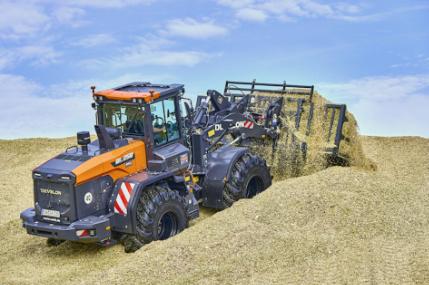
Particularly powerful machines are required to handle the biomass. A new DEVELON DL250-7 wheel loader recently passed its baptism of fire in this respect when it was successfully deployed for the first time at the biogas plant of Bioenergie Gut Lauenbrück GmbH located between Bremen and Hamburg in Germany.

When purchasing the 14-tonne machine, Bioenergie Gut Lauenbrück GmbH placed its trust in the local company and Develon dealer, ATLAS von der Wehl GmbH. The Develon dealer recommended the DL250-7, which delivers 128 kW at 2100 rpm thanks to its Develon DL06 Stage V engine, not least because of its high power reserve. This ensures that the wheel loader works efficiently even in demanding conditions and achieves a fast travelling speed in road traffic.
With its impressive breakout force and high traction, the DL250-7 is ideally suited for various types of silo applications. At Bioenergie Gut Lauenbrück GmbH, it has proved its worth
particularly when pushing the silage material, which is unloaded from the bottom of the silo by the trailer, onto the steep silo mountain. Its high operating weight makes the DL250-7 ideal for compacting the silage. It can also be optionally equipped with a high-tipping bucket and used to fill the biogas plant with the silage.
ATLAS von der Wehl recently delivered a 15 tonne Develon DL280-7 wheel loader to another customer. This machine, which is powered by a Develon DL06 Stage V engine, is also used for silage maize harvesting. For this purpose, the DL280-7 was additionally equipped with a Bekamax central lubrication system optimized for agricultural and construction machinery, a loading shovel, green forks and a high-tipping bucket. Thanks to the hydraulic quick hitch, these attachments can be fitted particularly quickly and easily.
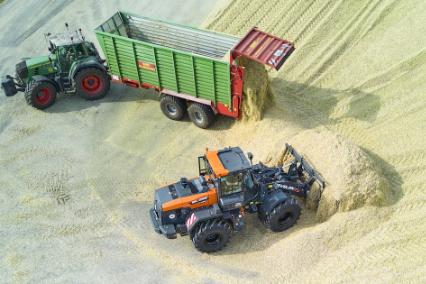

In addition to the larger wheel loaders such as the DL250-7 and DL280-7, Develon offers a diverse range of different smaller wheel loaders for demanding agricultural applications. For example, attachments such as agricultural buckets with grapples and bale clamps are available for the Develon range of compact wheel loaders such as the DL60-7 model, with an operating weight of 3.8 tonne or the DL85-7 with an operating weight of 5.1 tonne.
For more on Develon, please visit the website: https://eu.develon-ce.com/en/











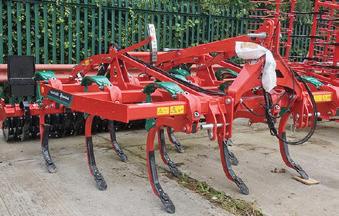






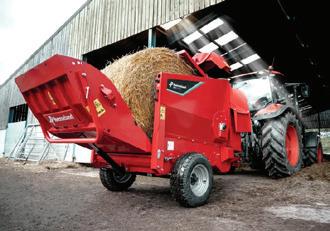





ohn Deere announced significant steps to support customers' ability to maintain and repair their machines across the agricultural and construction industries. The digital solutions will be rolled out in the US in the second half of this year. European farmers will also benefit from these new functionalities. The enhancements will provide even more support to customers and independent repair workshops, including enabling to re-program John Deere manufactured electronic controllers.
It should be noted that the legal framework conditions for the US and EU market differ in some cases. In Europe, the RMI (Repair and Maintenance Information) regulations apply. In the EU 27 different EU regulations are legally framing the right to repair for the agricultural equipment industry. These regulations list all data to be shared with independent operators or workshops. Data are available for many model years, on theJohn Deere Repair and Maintenance

TheARION600and500range-thenewmid-rangestandard Assistingyou,whereveritisneeded. Oneofourmostpopulartractorshasjustgotevenbetterthankstoahostofnew functionsdevelopedbyourengineersinconsultationwithARIONdrivers. Afterall,theyworkinthefieldeveryday,sotheyknowexactlywhattheywant. https://www.claas.co.uk
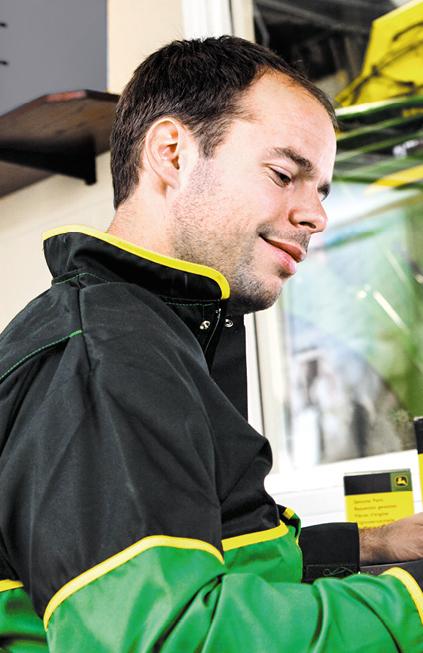
Informationwebsite. These include, among others:
• John Deere Bookstore - for free viewing operators' manuals and purchasing technical manuals (https://techpubs.deere.com)
• John Deere University - provision of training materials (https://jdu.deere.com)
• Service Gard - availability of special tools (https://servicegard.deere.com)
• Partscatalog - online spare parts catalog(https://partscatalog.deere.com/jdrc)
• ReadyTo - provision of diagnostic and repair instructions
The new functions primarily expand the repair options in the US. However, functionalities have

also been added to European RMI, which already today offers many options. One new feature is the integration into the John Deere Operations CenterTM. This means that farmers can use the Operations Center not only to manage field and machine data, but also for maintenance and machine information. The extension offers a userfriendly, centralised platform with a comprehensive range of tools for the entire life cycle of machines.
The new features include:
• Equipment Mobile - a free app with extensive machine information including operator and parts manuals, maintenance schedules, quick reference information, error code search and software updates for selected 4G connected machines.
Will joins KUHN to support the dealer network across the East of England.
• Shop.Deere.com - currently available in the UK and Ireland for finding and purchasing parts online
• Quick Reference Guides - offers various instructional videos and maintenance tips
• Customer Service ADVISOR - provides free digital manuals for clearing and updating codes, reading diagnostic data, and performing limited calibrations
The latest enhancements show that John Deere is continuously working to improve its products. The company is already a leader in providing self-repair resources. With the new options, farmers themselves can contribute even more to the uptime of their machines.
CLAAS has extended its range of agricultural tractors with the addition of the AXOS 3 series. With their powerful, efficient engines, large wheels, high payload and generously proportioned cab from a maximum height to the upper edge of the roof of 2.50 m, these compact tractors are positioned between the ARION 400 and the AXOS 200.

The new AXOS 3 from CLAAS can do all this, and more. With four models, it is positioned between the ARION 400 and AXOS 200; as well as bearing the same DNA as the earlier AXOS 300 and CELTIS 300, it boasts outstanding performance data combined with a host of impressive features and unique equipment.
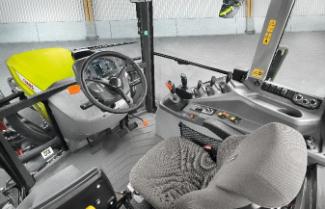
Compact tractors in the under-120-hp performance class spend a good 40 per cent of their operating hours handling materials and working around the yard. But they must also be capable of mastering field and grassland work. So not surprisingly, customer requirements are wide-ranging: compact dimensions, low height to pass through shed and barn doorways, uncompromising manoeuvrability, high payload, agile handling and excellent operator comfort, to name just some of the attributes tractors in this class are expected to provide.

Convenient shifting vastly reduces operator's workload
The AXOS 3 is powered by the fuel-efficient yet lively 3.6 l four-cylinder Fiat Powertrain (FPT) engine with modern Stage V exhaust gas aftertreatment. The four AXOS 3 models have outputs of 92, 103, 112 and 120 hp with maximum torques from 366 to 466 Nm at a low 1,500 rpm. The engine block and radiator panels – highly rated for their performance and reliability – are familiar from the NEXOS 200 and AXOS 200. Their widespread use in the CLAAS tractor programme means that spare parts availability and service capabilities are a given.







The fuel tank holds 160 litres – enough for long, hard working days. Furthermore, these tractors are approved to run on hydrotreated vegetable oils (HVOs), enabling their carbon footprint to be significantly reduced. Two engine speeds can be saved by the operator and applied at the press of a button as required.
To transfer power to the ground effectively while protecting the soil, the AXOS 3 can be fitted with large rear tyres with an external diameter of up to 1.6 m (420/85 R38 or 540/65 R 38). Large front wheels guarantee maximum efficiency in fourwheel drive mode and precise manoeuvrability even on difficult terrain and when using heavy implements.
Convenient shifting vastly reduces operator's workload
Engine speed reduction is provided by a modern, well-stepped six-speed transmission available in three versions to suit customer requirements and conditions:
• 12/12 (2 ranges) with mechanical reverser.
• 24/12 (2 ranges) with TWINSHIFT powershift transmission and REVERSHIFT clutchless reverser.
• 36/18 (3 ranges) with TWINSHIFT powershift transmission and REVERSHIFT clutchless reverser.
Top speeds of 40 km/h are achieved at a fuelefficient 1,750 rpm, and in models fitted with REVERSHIFT, you can shift using the clutch button on the gear lever instead of the foot clutch –shifting has never been so easy! Eleven gears are available between 5 and 15 km/h and overlapping gears ensure smooth shifting between the two or three ranges.
In addition to the mechanical hand brake, versions with 24/12 and 36/18 gears can be fitted with an optional electric parking lock which is activated via the REVERSHIFT lever to the left of the steering wheel. Customers can also opt for SMART STOP, which enables the operator to stop and start without using the clutch pedal – a huge advantage during front loader and transport operations, and when baling round bales..
Designed exclusively for the AXOS 3, the cab has several distinguishing features that make the working day easier. Inside the cab, the retractable and adjustable steering console incorporating the instrument panel immediately stands out. Dynamic steering with adjustable steering ratio (optional extra) reduces the number of turns of the steering wheel between the steering locks from 3.8 to 1.9 when operating at speeds of up to 10 km/h.
The right-hand side console houses the key control elements along with a bottle holder and a storage compartment. Additional generous storage areas and two USB ports are situated to the left of the operator. The electrohydraulic E-PILOT S can be installed in the right-hand side console for fingertip control of all front loader functions.
ISOBUS terminals such as the CLAAS CEMIS 700 can be installed in the cab for controlling ISOBUS implements.
With a payload of up to 3,600 kg and a maximum lift capacity of 5,300 kg at the rear (continuous lift capacity 4,000 kg), the AXOS 3 is not fazed by heavy implements. The optional integrated front linkage provides an impressive additional lift capacity of 3,240 kg. Up to four double-acting mechanical spool valves with a flow rate of 60 or 90 l/min are available for implements and front loaders, up to two of which have mechanical flow control.
The rear PTO can be optionally supplied with either two or three speeds and automatic PTO engagement/disengagement, while a 1,000-rpm front PTO is available to drive front-mounted implements.
Various models in the three CLAAS front loader series up to FL 100, FL 100 E and FL 100 C are suitable for the AXOS 3. They can be operated either by the mechanical PROPILOT four-way control lever or the electrohydraulic E-PILOT S. The latter actuates FASTLOCK and SPEEDLINK for hydraulic locking and unlocking of the front loader and its attachments, as well as automatic bucket return.
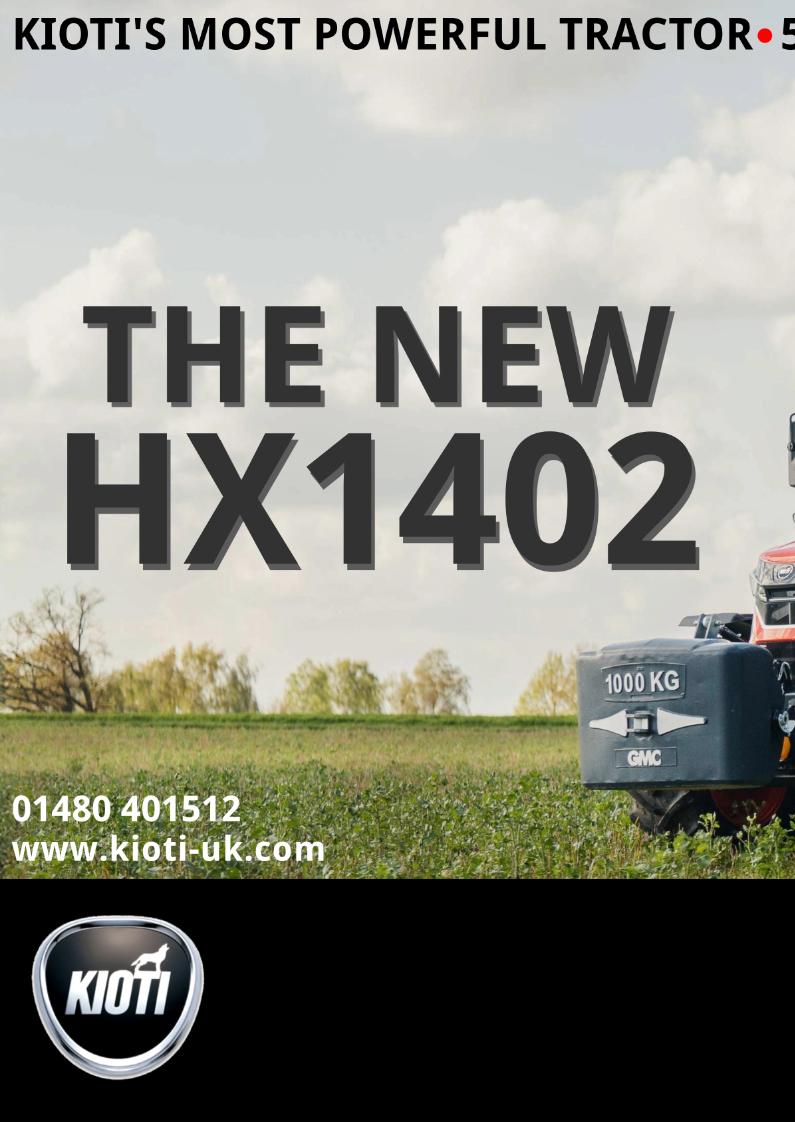

Crawfords Group is proud to announce that it has been appointed as an authorised dealer for Indespension trailers across its extensive sales territory, covering Essex, East Hertfordshire, Kent, Sussex, Surrey, Hampshire, and in addition East Berkshire.

Indespension is one of the UK's leading trailer manufacturers, offering a comprehensive range of high-quality trailers and towing solutions. Their product range includes trailers for agricultural, commercial, and leisure use, renowned for their durability, reliability, and innovative design. The partnership ensures customers in the region gain easy access to Indespension’s industry-leading products, backed by Crawfords Group's exceptional service and support.
“We’re delighted to welcome the Crawfords Group as part of our UK Dealership Network. Their reputation of providing exceptional customer service and support compliments Indespension’s manufacturing ethos of producing best-in-class trailers to meet the demands of industrial sectors. We look forward to supporting their teams in building a successful partnership.” Commented Paul Bonar, Sales & Marketing Director
By joining forces with Indespension, Crawfords Group continues to expand its offering of premium equipment for the agricultural, automotive,
construction and leisure industries. Customers can now purchase a wide selection of trailers, parts, and accessories through Crawfords Group’s dedicated dealerships, with expert advice and aftersales care readily available.
"We are excited to add Indespension to our portfolio of trusted brands," said Nunzio Rio, Group Sales Director at Crawfords Group. "Indespension’s reputation for high-quality trailers aligns perfectly with our commitment to delivering exceptional products and service to our customers. We look forward to supporting farmers, contractors, and businesses across our territory with this excellent range of trailers."
Indespension trailers are engineered to meet a variety of needs, from transporting heavy machinery to moving livestock or leisure equipment. With a focus on innovation and durability, Indespension provides reliable solutions for professional and personal towing requirements.
Crawfords Group invites customers to visit their dealerships to explore the Indespension trailer range, learn more about financing options, and benefit from expert advice tailored to their specific needs.
For more information about the Indespension range or to locate your nearest Crawfords Group dealership, please visit www.crawfordsgroup.co.uk
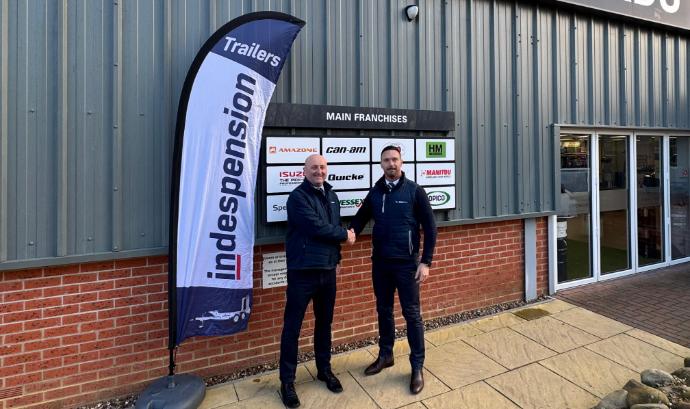




OPICO Comb Harrows are now available with the option of on-themove hydraulic tine adjustment.
By providing the operator with the facility to alter the angle of attack without needing to leave the tractor cab, the weeding harrow is kept running at optimal efficiency as crop and soil conditions change across the field.
Current models require manual adjustment on each independent floating bed; however, with this hydraulic ability, operators will now have variable adjustment at their fingertips to allow fine tuning. Altering tine pitch changes how aggressively the harrow works and it is critical it set correctly to match both to crop and weed seedling growth stage. This new feature enhances the removal of unwanted weeds by maintaining the gyroscopic movement of the tine in the soil.

integrated “hybrid” approach – combining chemical and mechanical options – is increasingly being adopted as we enter an age of herbicide-resistant weeds. The reduction of available active ingredients in the UK to combat weeds along with the shift to environmentally-led policies are likely to encourage farmers to seek out alternative weed removal options that don’t derive from a can or bag.
With a range that spans working widths from 1.5m to 27m, OPICO has one of the widest offerings of weeding harrows on the market.
This season the company will have a 12m demonstration Comb Harrow fitted with an Air16E Pro Seeder available for on-farm trials across the country. Customers are encouraged to get in touch with their local OPICO Territory Manager to organise a demonstration this spring, to fully appreciate the benefits this new feature can offer.
Organic farmers have been using mechanical weeding technology for many years but an
A 12m OPICO Comb Harrow fitted with hydraulically adjustable tines retails at £22,460.


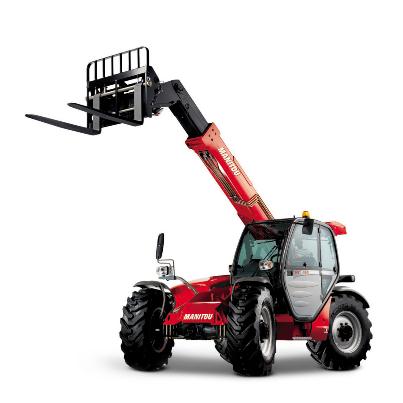



CLAAS has extended the ARION 500 series with the addition of the ARION 570 CMATIC featuring a genuine 180 hp and a range of innovative functions with the focus on maximising customer benefits. The powerful four-cylinder engine with continuously variable, split-power CLAAS CMATIC transmission is also available in the NIGHT EDITION.

The ARION 500 series marks the rise of the CLAAS standard tractor programme to the professional league. With growing demand for increasingly powerful, yet agile, four-cylinder models, CLAAS is launching a new top-of-the-range model with high-spec equipment for the series. This tractor class encompasses a broad sweep of applications ranging from tillage, drilling and general cultivation work to yard work with or without front loader, transport operations and municipal work.

powered zero and a top speed of 40 or 50 km/h. This type of transmission has demonstrated its efficiency, resilience and reliability under challenging field conditions in runtimes amounting to over 10,000 operating hours. Its optimally coordinated powertrain management is equally impressive; acceleration, deceleration and direction changing are effortlessly smooth. Furthermore, the transmission software developed in-house maintains a perfect balance between engine speed and transmission ratio at all times, whatever the task, to enable powerful yet efficient work.
The ARION 570 CMATIC works with a 4.5 l Stage V engine, which delivers a maximum output of 180 hp without boost. The maximum torque of 730 Nm is available at 1,400 rpm.
The ARION 570 CMATIC has a reinforced Dana front axle to match its higher output. In addition, the compact, manoeuvrable four-cylinder is available with Trelleborg VF 710/60R38 tyres on the rear axle and VF 600/60 R28 on the front, a combination which effectively converts engine power to tractive power while protecting the soil. The ARION 570 CMATIC also benefits from a 50:50 kerb weight distribution.
Intelligent and efficient: CMATIC, CEMOS, CMOTION and that's not all
The ARION 570 CMATIC works with the latest configuration of the CMATIC continuously variable transmission developed and manufactured by CLAAS Industrietechnik, which boasts two automatically selected drive modes, active
Wheel-loader mode is another stand-out feature of this CMATIC transmission. When this mode is activated for front loader work, the transmission software uses intelligent torque and engine speed sensor monitoring to prevent the wheels spinning in push mode, for example in the silage clamp or when loading soil or solid manure – exactly like a wheel loader. In addition, precise speed control in the hydrostatic range, especially when stacking straw bales or pallets, ensures greater accuracy and relieves the operator's workload. What's more, the automatic engine speed increase triggered by demand for more hydraulic power from the front loader ensures that load cycles are always performed with maximum productivity.
Furthermore, the CEMOS dialogue-based system for optimising the productivity and efficiency of field and grassland work is available as an option. In terms of road travel, the automatic trailer stretch brake provides additional safety, especially when travelling downhill with trailers, as well as when working on slopes with attached implements –such as balers or slurry tanks. When decelerating, the automatic braking system automatically activates the air brakes of the trailer or attached implement as soon as critical thrust forces are exerted on the tractor. The system uses data from sensors in the transmission, which record engine drag torque and thrust in the drive train.







Stubbings Bros Ltd.
Ventnor Isle of Wight PO38 2JN
Phone : 01983 551443
www.stubbings-bros.co.uk
RVW Pugh, Mellington, Churchstoke, Montgomery Powys. SY15 6TQ
Phone : 01588 620545 www.rvwpugh.co.uk
D.A. Forgie Lisburn, BT27 5QB
Phone : 02892677736 www.forige.com
RVW Pugh, Oakwood Park, Holmes Chapel, Cheshire
CW4 8AX
Phone : 01477 533560 www.rvwpugh.co.uk
D.A. Forgie Co Londonderry, BT49 9DW
Phone : 02877722375 www.forgie.com Or
Lister Wilder
Ashford 01233 619 290
Reading 01189 884 888
Bibury 01285 708 234
Bristol 01454 807 850 www.listerwilder.co.uk

www.cooksmidlands.co.uk
Standard equipment in the ARION 570 CMATIC includes the ergonomic control armrest with 12inch CEBIS terminal and CMOTION drive lever, which keeps the right hand in a relaxed position while providing access to more than 20 functions including cruise control and direction changing, along with tractor speed adjustment in drive lever mode.
comfort and safety
Operator comfort is firmly embedded in the DNA of today's CLAAS tractors. Here too, the ARION 570 CMATIC impresses with its quiet cab with four-point suspension and optimally balanced PROACTIV front axle suspension. A PREMIUM operator package with leather steering wheel, air conditioning, Premium seat and electrically adjustable and heated rear view mirrors is available as an option.
free deceleration and braking.
Fully connected to the new CLAAS connect

The CLAAS CEMIS 1200 terminal with 12-inch colour screen is available for automatic steering, precision farming and documentation. In addition, every ARION 570, unless otherwise specified, will be automatically connected to the new CLAAS connect. This enables digital operating manuals, lubricants and wear and spare parts specifically for the machine to be accessed from any end device via Machine connect, as well as the maintenance history and upcoming maintenance work. Moreover, machine performance data and current tractor location can be viewed at any time and licences such as Farm connect, Fleet connect and Field connect can be managed effortlessly.
The advantageous 50:50 kerb weight distribution –despite a 2.56 m wheelbase designed with maximum manoeuvrability in mind – ensures a high degree of suspension comfort without the need for additional ballast as well as ensuring the safe transport of heavy implements and safe and trouble-free use of heavy trailers with a high drawbar load. The front axle is equipped with dry disc brakes as standard to ensure effective, jerk-

If the farm already has a CLAAS connect ID, the ARION 570 CMATIC is simply added to the existing machine fleet. In the absence of a CLAAS connect ID, one can be created when the tractor is purchased and used with a free 5-year Machine connect licence.
Even more exclusive: the NIGHT EDITION ARION 570 CMATIC
CLAAS has a solution at the ready for customers seeking an even greater degree of exclusivity for their ARION 570 CMATIC. The NIGHT EDITION of the new four-cylinder features custom grey paint on the rims, roof and side engine panels. The CLAAS logo on the side of the bonnet is white on a custom grey background, and Night Edition lettering is prominently displayed on the side of the bonnet. The emblem above the road light provides a nice finishing touch to the external design. Inside the cab, the steering wheel badge and floor mat display the NIGHT EDITION lettering. For drivers who enjoy top in-car entertainment, there is also an in-built Apple CarPlay radio.
Interested farmers and contractors can order their NIGHT EDITION ARION 570 CMATIC from their CLAAS dealer now or go to night.claas.com to secure their exclusive model and take advantage of a special discount on the list price.
We are pleased to announce that we have been appointed as main dealer for Strautmann machinery in North Wales. We have already conducted two on-farm demonstrations with the 19m3 Verti-Mix 2401 Diet Feeder, so we would be pleased to hear from you if you have interest or further enquiries about these high-quality machines.


Cornish Tractors
Timberlake, Week St Mary Devon. EX22 6XG
Phone: 01288 341326 www.cornishtractors.co.uk
The W240 Weed Wiper is a simple, robust, yet highly effective tool for the selective application of herbicide to undesirable weeds such as reeds, rushes, bracken and thistles. A unique electric drive system eliminates dripping due to over-saturation and ensures consistent application and killing of weeds.
Contact Your Dealer
Yorkshire ATV
Unit 3, Tong Park Industrial Estate, Tong Park, Baildon, BD17 7QD
Phone: 07701 070156 www.yorkshireatv.com
J. Bourne Tractors
Valley Farm, Thorncliffe Rd, Leek ST13 8TG Phone: 07915 242942 www.jbournetractors.co.uk
01538 224228
CJ Keitch
Dunkeswell Airfield, Honiton, EX14 4LH
Phone: 01404 891796 www.cjkeitch.co.uk
Used4Turf Ltd
Tye Rd, Elmstead, Colchester CO7 7BN Phone: 07483 869941 www.used4turf.co.uk
www.chapman.co.uk

Riley Beet Harvesters, UK importer of Vervaet, is introducing an updated version of the popular Vervaet Q-616 sugar beet harvester for the 2025/26 harvesting campaign. This latest Q-616 features a new cab, a range of technical improvements, updated styling and numerous new options. This facelift continues the progression of the Q-Series harvester design in line with Vervaet’s policy of ongoing development.
"Since its launch in 2016, the Q-Series has been a huge success,” says Jonathan Hoekman, commercial director at Frans Vervaet BV. “Thanks to its modular design, manoeuvrability, and straight-forward layout this machine has proven itself across various markets and countries. With this latest update we aim to continue and strengthen this success. As a family-owned company now in its third generation, we feel we have built a robust machine for the immediate future.”
The Q-616 is Britain’s favourite sugar beet harvester, outselling both its siblings in the Vervaet range and machines from competitor manufacturers by a considerable margin. With almost a decade of proven performance now under its belt there is also a strong demand for refurbished used machines, of which Rileys supply a considerable number to new owners annually.






“The Q-616 has proven itself in the UK as a worthy successor to the legendary Vervaet 17-T and Beet Eater 617,” points out J Riley’s managing director Matt Carse. “Its versatility makes it well-suited to both farmers and contractors lifting across the full range of soil types, it has consistently outsold the competition since its introduction. The large UK population means we can also offer good-quality refurbished machines. Plus first-class backup, which is all as part of the package.”
•New Claas X11 cabin: The Q-Series is now equipped with the new Claas X11 cabin, which is larger, quieter, and more comfortable for the operator. The cabin is fully CAN-bus controlled, ensuring better and more accurate data transmission.
•Updated lifter frame: The lifter frame has been upgraded to improve efficiency and precision during harvesting, resulting in fewer losses and a cleaner harvest.
•Latest topping and lifting gear: The Vervaet Q-616 now comes as standard with the third generation front-end. Owners can choose from three toppers to match their specific needs. Additionally, there is a choice between a rollerbed or turbine-only primary cleaning system to suit different soil types and harvesting conditions.
•New look and styling: The Q-Series has received a new look. With this update, the


harvester becomes the first machine to display the new Vervaet corporate image.
• Hydraulic improvements: Several hydraulic upgrades have been implemented, including new valves and

pumps. These improvements provide better responsiveness and greater efficiency.
• Major software update: The new harvester comes with an extensive software update which ensures better performance, greater ease of use, and even more reliability.
• 360-degree camera system: To enhance safety and visibility, the machine is equipped with a new 360-degree camera system. This gives operators a complete overview of the machine and work area, contributing to more efficient operation and reducing the risk of damage.
• Electric mirrors and cameras: The QSeries now features fully electric mirrors that can be easily adjusted for optimal visibility.





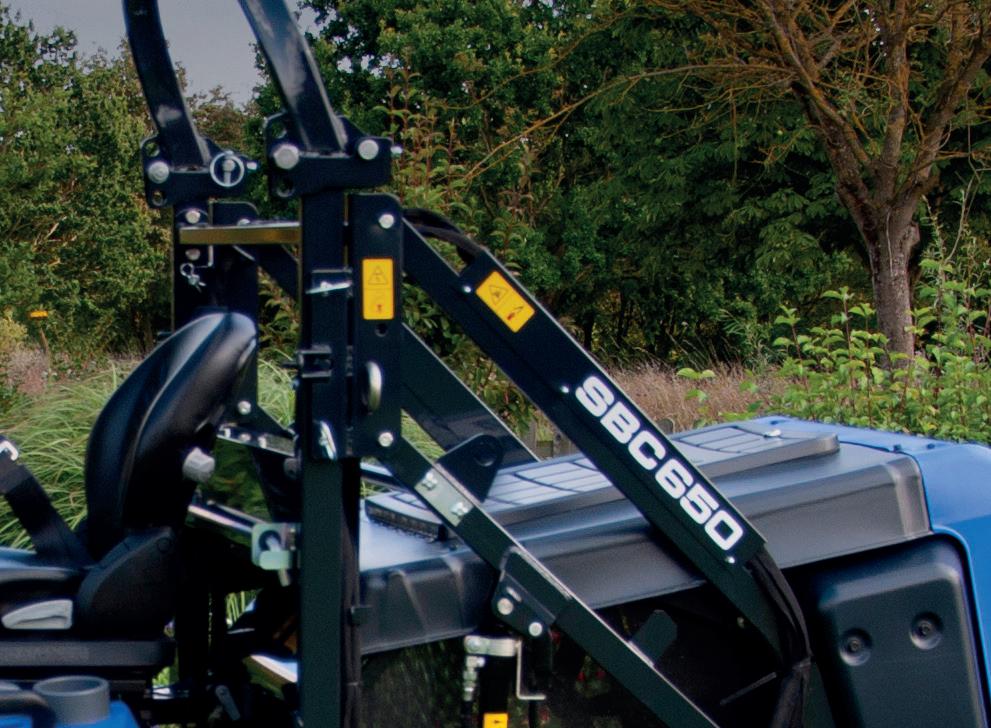


Contact your local dealer to book a demo on your premises today!
Veryard Machinery
Blackworthy Road, Castle Cary, Somerset, BA7 7PH 01963 351089 richardveryardmachinery.co.uk
RVW Pugh
Mellington, Churchstoke, Montgomery, Powys, SY15 6TQ 01588 620545 www.rvwpugh.co.uk
Readman Mowers
The Shed, Sand Lane, Wilberfoss, YO41 5PB 01759 380231
readmanmowers.co.uk
Celtic Mowers
Celtic Mowers Limited, Celtic House, Fabian Way, Swansea, SA1 8QB 01792 641517
celticmowers.com
An acquisition agreement has been reached between two Scottish John Deere dealers which will see J&S Montgomery expand into Lanarkshire, South Stirlingshire and West Lothian.

The purchase of DKR Agricultural Services at Coulter, near Biggar, adds a fourth depot to the J&S Montgomery business.
Agricultural Services, said: "We have known the Montgomery business for many years and our positive relationship will ensure sales and service continues uninterrupted.
"We are extremely proud to have worked with John Deere for so long, achieving a strong market share, and attracting great employees who delivered the best possible customer service along the way."

The dealer principals at both companies –which together have more than 75 years' experience of John Deere sales and service –are focusing on a smooth, seamless transition for customers in the territory.
Douglas Montgomery, Dealer Principal at J&S Montgomery, said: "DKR Agricultural Services is an excellent business with skilled staff and a well-earned reputation across Lanarkshire and beyond.
"We are pleased to have been able to reach an agreement with the owners – the Doig family – and in the coming weeks and months we will work together to incorporate and ensure it's business as usual for all customers and staff."
David Doig, Dealer Principal at DKR
DKR Agricultural Services is run by David, his brother, Keith, and sister, Susan. It has been trading since 1989 and predominantly serves livestock and dairy farms as well as contractors and a significant number of arable-focused operations.
J&S Montgomery became a John Deere dealer in 1980 when it had just one depot based on the family farm near Beith, North Ayrshire.
It grew in 2005 and 2015 and now has depots in Stranraer and Ayr.
"We have a loyal customer base down the west coast of Scotland which is largely grassland operations such as dairy, beef and sheep," Douglas added.
Brian D'Arcy, Division Sales Manager for Agriculture at John Deere UK and Ireland, said: "We are hugely grateful for the 35 years of loyalty and customer service excellence that the DKR Agricultural Services team has given customers. I would like to thank David and all the team at DKR for all their hard work and commitment to John Deere.
"We know that J&S Montgomery's reputation for customer-focused service will be carried over into the new depot at Coulter and wish them every success in their expanded territory."
North-East-based agricultural machinery specialists, Ancroft Tractors Ltd, recently marked a significant milestone - 30 years as a Merlo dealer. The achievement was celebrated with a long service award presented to Managing Director, Tom Brown, at LAMMA Show last week.
Founded in 1979, Ancroft Tractors is a family-run business with a proud tradition of serving the agricultural community. With head office in Berwick-upon-Tweed, along with a depot selling and servicing Merlo’s in Kelso, Ancroft Tractors ensure comprehensive coverage across Northumberland, the Scottish Borders, and Mid/East Lothian. Specialising in new and second-hand machinery sales and service, the company has built a solid reputation for reliability and customer service.

Reflecting on the partnership, Shaun Groom, General Manager of Merlo UK, said: “Ancroft Tractors have been selling Merlo products and supporting their customers since 1994. Only a year after Merlo UK was established
in 1993, and two years before Merlo’s Turbofarmer range was launched. Ancroft Tractors were one of the first dealers in the UK to sell Merlo machines to the agricultural industry and over the past 30 years and they’ve witnessed Merlo’s continuous innovation and evolution—from the introduction of the Multifarmer in 2000 to the launch of Merlo's Generation Zero electric telehandlers in 2021. Merlo owes Ancroft Tractors a debt of gratitude for their loyalty and support, and we are proud to count them as a valued Merlo dealer.”
Tom Brown, Managing Director at Ancroft Tractors added, “As a friendly, family owned-business, backed by the best parts, service and sales teams we have embraced new products and technologies and introduced them to our customers. It has been a privilege to work with Merlo for the past 30 years and we look forward to continuing this strong partnership in the future.”
This milestone celebrates a decades-long partnership built on shared values of innovation, quality, and commitment to customer success.



KUHN Farm Machinery has updated its popular Espro trailed drills featuring a redesigned operator platform, a new straight disc option, and a lighter version of the 6m model.

The updates focus on the 3-6m models with the 3002 (3m), 4002 (4m) fixed, and 4002 R and 6002 R (6m) folding units, introduced as upgrades to the existing 3000, 4000 and 6000 drills. The new models will begin production in spring 2025, and Edd Fanshawe, KUHN’s arable specialist, says the upgrades will be welcomed by new and existing users.


“The Espro is growing in popularity and has many features to improve seed placement and consistency in tricky conditions. Wheel design and layout, headland turn customisation, and Vistaflow valves, are all qualities that highlight how versatile and accurate the drill is.”
Hopper access and operator safety has been improved with a new mid-height platform, that spans the full length of the hopper and automatically folds when the drill returns to transport mode. This prevents overreaching to split bags and allows full visibility into the
hopper. A half open mode – one side of the drill folded while the other remaining in work position – improves loader access to the hopper for filling. A new hopper cover has an automatic winding and locking system.
A straight disc option, suited to users reducing soil disturbance across each pass, can replace the standard 460mm concave notched discs. The straight disc ensures soil is only moved in the narrow band where the disc runs, helping to reduce power requirements of the drill along with preserving soil moisture. Furthermore, the Espro 6m 6002 R is 700kg lighter than the outgoing Espro 6000 model it replaces. This will help to reduce soil compaction and fuel consumption, making a high-output drill easier to pull.


Edd concludes: “The new series of Espro is safer, lighter and more compatible with different establishment systems. It offers agronomic benefits, with accurate seed placement and even soil consolidation, alongside operational ease through easy filling and setup.”
The full line of New Holland Braud grape and olive harvesters and straddle tractors is now supplied as standard across European markets with a two-year factory warranty, underlining New Holland’s belief in the standards of manufacturing quality at the brand’s Centre of Excellence in Coëx, France, and assuring growers of high reliability and low running costs.
With many vineyard and olive grove owners putting their trust in New Holland Braud straddle tractors and harvesters to manage the treatment and harvest of their crops, machine product quality, and the reliability that results from it, are at the core of thousands of hectares of grape and olive production. The 2025 products produced by the people and the procedures of the Coëx factory are fully guaranteed by the new twoyear warranty.

This new warranty covers all major components of each machine, and allows grape growers to be assured not only of machine reliability, but also of the operating costs of the first two years of their machine investment. Rather than a single year warranty, this is a true factory twoyear type, without working hour limitation. Standard warranty terms and conditions apply.
New Braud machines also come with two years’ Uptime Support. In high season, this provides 24/7 back-up as soon as an assistance request is recorded.
Working with the customer’s New Holland dealer, New Holland does everything possible to provide the quickest and most effective support until the matter is resolved, using a range of solutions including technical and logistics support, and a back-up unit if available, to get the customer working again within 24 hours.
Also standard from 2025 are lifetime-enabled connectivity services for connected machines via FieldOps™, the telematics platform from CNH that helps users stay constantly
connected to their equipment. This allows monitoring of machine data, performance, location, precision farming operations and more 24/7 services. New Holland technicians operating in the dealer’s IntelliCentre remotely monitor the connected machines to help prevent possible failures before they occur.
The two-year warranty introduction comes in the same year that New Holland marks the 50th anniversary of the launch of the first Braud self-propelled grape harvester, which will be the subject of forthcoming celebrations and communications.




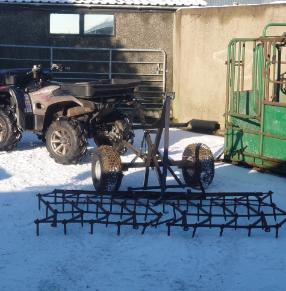





















Last month CFMOTO held its first demo day in the UK, welcoming over 70 customers and dealers to test ride their full range of ATVs and UTVs. The event, set in a dedicated off-road woodland featured steep inclines, descents and muddy pits, giving customers the chance to experience the performance and versatility of CFMOTO’s vehicles first-hand. For many, this was an opportunity to compare models in real-world settings, and the feedback was overwhelmingly positive.

Attendees were particularly impressed with the allnew U10 Pro UTV, which stood out for its capability to handle both demanding workloads and challenging terrains. Its modern features and robust power, practicality, and reliability demonstrate that it’s built for heavy-duty applications - all for only £18,000 + VAT (cab included)
The lineup included the popular agricultural machines including the UFORCE 600 UTV andthe CFORCE 625, CFORCE 520, and CFORCE 450 ATVs, but also gave customers the rare chance to experience the excitement of its powersport range – the ZFORCE 950 Sport, Gen 3 CFORCE 850 and CFORCE 1000 Mudder MV CFORCE which turns heads with its powerful


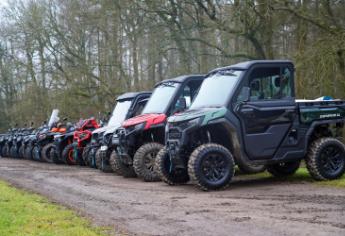
engine and ability to handle tough, muddy conditions with ease.
The event wasn’t just about the machines, though. It also created a platform for customers to engage with CFMOTO UK representatives and dealers directly. In addition to the CFMOTO UK representatives, Lin Wul from the CFMOTO Global factory also attended the event to answer any questions.

Attendees valued the opportunity to discuss their specific needs, ask questions, and learn more about the machines they were testing.
Stephen Dargue, a livestock farmer from Cumbria commented, “It was great to see and ride the different models to compare them – I was particularly impressed with the U10 Pro buggy. We already run two CFORCE 520 quads on our farm and they are clearly built for the kind of hard work we deal with daily. They’re robust and perform exceptionally well.”
Dealers were equally impressed, highlighting the event’s smooth organisation and the chance to engage directly with their customers.
CFMOTO’s UK demo day has firmly established the brand’s position in the market. With a range of vehicles designed to meet the demands of British land management and off-road enthusiasts, they are proving to be a strong contender. For those looking for reliable and versatile machinery, CFMOTO has shown they’re well-equipped to deliver.
This event signals a bright future for the brand in the UK, and it’s clear they’re committed to supporting those who depend on reliable vehicles for daily work.
If you’re interested in attending a future CFMOTO Demo Day, you can get in touch with your local dealer at cfmoto.co.uk/find-a-dealer







olaris Off Road continues its Ranger Stories video series in a new light with the introduction of the ‘Ranger Stories: Driving Change’ initiative.
Polaris is a firm believer that a product comes to life through its applications, partnerships but most importantly, via the people who use it; which is why once again, Polaris has embarked on a journey across Europe, the Middle East and Africa to discover and capture how its customers are driving change alongside the Polaris Ranger. Dedicated to the good that Polaris customers do, Ranger Stories: Driving Change is inspired by the many Polaris customers working hard to positively impact the world.

The future of farming: For Hectar, it’s about utilising technology, thinking innovatively and valuing economic and environmental sustainability to reinvent the agricultural way of life.
Situated just outside Paris, Hectar is a unique ecosystem making strides to accelerate the social and economic transition of regenerative agriculture. Providing a testbed for the next generation of farmers and agri start-ups through its pilot farm, Hectar combines the best of human ingenuity with a supportive space to innovate, model and deploy new agricultural methods and practises.
Hectar, founded by French tech mogul Xavier Niel and Audrey Bourolleau, a former advisor to French President Emmanuel Macron, is a place to springboard food tech and agricultural entrepreneurs’ ideas into feasible business models; where both new and existing farmers unite to discover new farming methods that do not compromise their values and quality of life; and where mentors and educators are making an impact with forward-thinking seminars and support programs.
It’s here, in a place that is cultivating a future where technology and agriculture work hand in hand, where the Polaris RANGER XP Kinetic comes into its own.
“It’s a tool that aligns perfectly with what we’re trying to achieve at Hectar,” said Eléonore de Brek, Farm Manager at Hectar. “The electric Polaris Ranger aligns perfectly with our commitment to shape the agricultural industry with sustainable practices, without compromising on quality or value. Not only does it support our productivity on-site, but it demonstrates

what the future of farming looks like for the generations to come.”
With its pilot farm covering more than 300 hectares, Hectar needed a versatile vehicle to help with the daily demands, as well as a vehicle that aids productivity for its entrepreneurs working on site. For this, the team chose the RANGER XP Kinetic - the 100% electric sideby-side that doesn’t compromise on off-road capabilities, strength or power.
“Whilst it’s a huge benefit to have an electric UTV here, it wasn’t just the electric element that sold us on this vehicle,” continued Eléonore. “We have a lot of land to manage; it gets extremely muddy in the winter, we’ve got some big hills to climb to reach the animals, and we have to move a lot of heavy feed and materials around the site, so naturally, we had to be sure the vehicle could cope with these demands. In this respect, the Ranger has completely transformed our way of working.”
The RANGER XP Kinetic not only boasts a large 567kg cargo bed capacity but also a 1,134kg towing capacity for trailers. Add that to its 140lb-ft instantaneous torque, on-demand all-wheel drive (AWD), 35.5cm ground clearance and up to 80-mile range on a single charge (Ultimate trim), XP Kinetic sets a new standard for offroad capability.
Hectar also needed a vehicle they could comfortably use all day without interruption. XP Kinetic features an automatic gearbox and electric power steering (EPS) for easy driveability, and Hectar chose to fit their vehicle with a windshield and roof for added weather protection and in-cab comfort.
Polaris is proud to support Hectar with the RANGER XP Kinetic, helping to reimagine the possibilities of tomorrow and reinvent the future of farming.

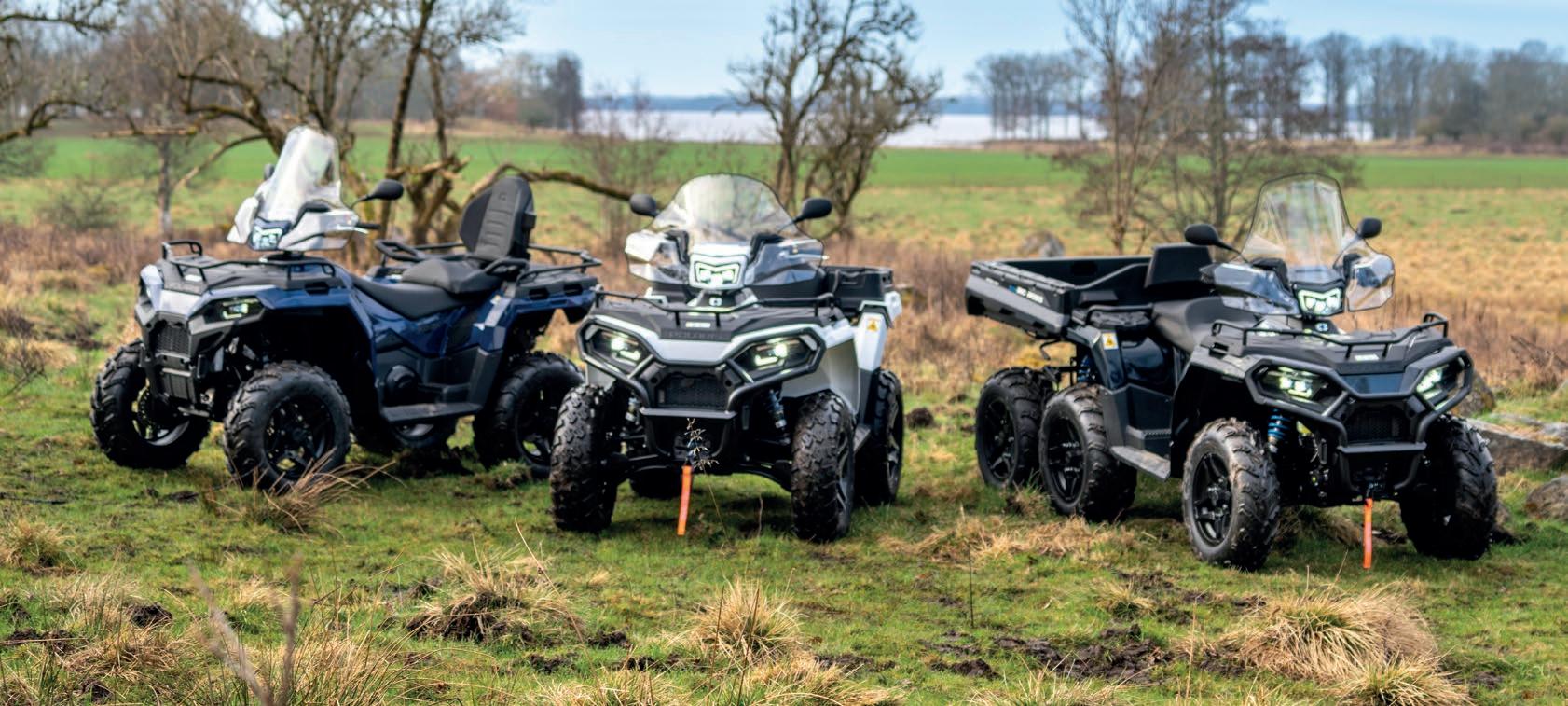



Bruce Hopkins Limited
Shenington Airfield Oxon, OX15 6NW Tel 01295 680 711
www.brucehopkins.co.uk
Argyll Engineers Limited Glenshellach Road, Oban PA34 4BH. Tel 01631 565 011 www.argyllengineers.com
Day & Coles (Agricultural) Limited Newton Close , Park farm Wellingborough, Northamtonshire, NN8 6UW Tel 012933 673 900 www. dayandcoles.co.uk
Bruce Hopkins Limited
LJ & CA Cannings
Shenington Airfield, Oxon OX15 6NW. Tel 01295 680 711 www.brucehopkins.co.uk
Challow House Farm, Main Street East Challowm Wantage, OX12 9SR Tel 01235 763 103 www.ljcannings.co.uk
Clwyd Agricultural Limited
Taylors Tools (KL) Limited 43 Hempstead Road, Kings Langley, WD4 8BS Tel 01923 268 355 www.taylorstools.co.uk
Terfyn Buildings, Caerwys Road Dyserth, Rhyl LL18 6HT. Tel 01745 571 018 www.clwydagri.co.uk
Day & Coles (Agricultural) Limited
BRM Ltd

Tel: 0330 041 5141 Polarisbritain.com

Birkby Lane, East Cowton, Northallerton, DL7 0DX Tel 01325 506001 www.polaris-northallerton.co.uk
Usk and Wye Valley ATV Ltd
Newton Close, Park Farm, Wellingborough, Northamptonshire NN8 6UW Tel 01933 673 900 www.dayandcoles.co.uk
Little Ton Lands, Tredunnock, Monmouthshire, NP151LY Tel 01291 408581 www.polaris-monmouthshire.co.uk
Halls of Bromyard Tenbury Road, Bromyard Herefordshire HR7 4LL Tel 01885 489 199 www.hallsofbromyard.com
David Evans Agricultural Ltd
Old Middlehill, Walterston, Llancarfan, Vale of Glamorgan, CF62 3AD Tel 01446 311101 www.polaris-glamorgan.co.uk
LJ & CA Cannings
Lindstead Farm & Garden Machinery
The Garage, Linstead Parva Haleswort, IP19 0AA Tel 01986 948086 www.polaris-halesworth.co.uk
Challow House Farm, Main Street, East Challow, Wantage, Oxfordshire OX12 9SR Tel 01235 763 103 www.ljcannings.co.uk
Paterson ATV
Taylors Tools (KL) Limited
Biggars Mill, Dalbeattie, Newton Stuart DG5 4AZ Tel 01556 610 249 www.patersonatv.co.uk
43 Hempstead Road, Kings Langley WD4 8BS Tel 01923 268 355 www.taylorstools.co.uk






allowing the team at Inclusive Farm Scotland at MacRobert to tend to their sheep, check boundaries, remove fallen trees, ensure trails are clear and countless other daily tasks.
Simon Riches, Product Manager - ATV & Mule at Kawasaki Motors UK
"Having got to know Mike and Ness in recent times, it is fantastic to see their passion and drive for creating Inclusive Farm, which provides an opportunity for people with disabilities to learn and gain the confidence to pursue a career in farming. We at Kawasaki UK are very happy to support Mike and Ness at Inclusive Farm Scotland at MacRobert in this worthy cause."
Mike Duxbury, CEO at The Inclusive Farm
"I really can't thank Kawasaki enough for the support they have provided. It's a brand I've always admired, as growing up on a farm, we had motorcycles as kids, and the very first one our family owned was a Kawasaki!
From the very first chat we had, they have been invested in what we're doing at the Inclusive Farm and eager to help, and the Mule has already proven to be an invaluable workhorse. It's the ideal machine for our farm, and the manoeuvrability and performance are second to none, allowing us to showcase accessiblity farming in its truest sense."

The MULE SX 4x4 rides on 24 inch tyres and offers selectable 2WD and 4WD, with CVT drive 2 speed auto, reverse and rear differential lock. Kawasaki PRO styling, tilting steering wheel and the dependable OHV 410cc engine, 181kg load and 500kg towing capacity, make this a true go anywhere vehicle.









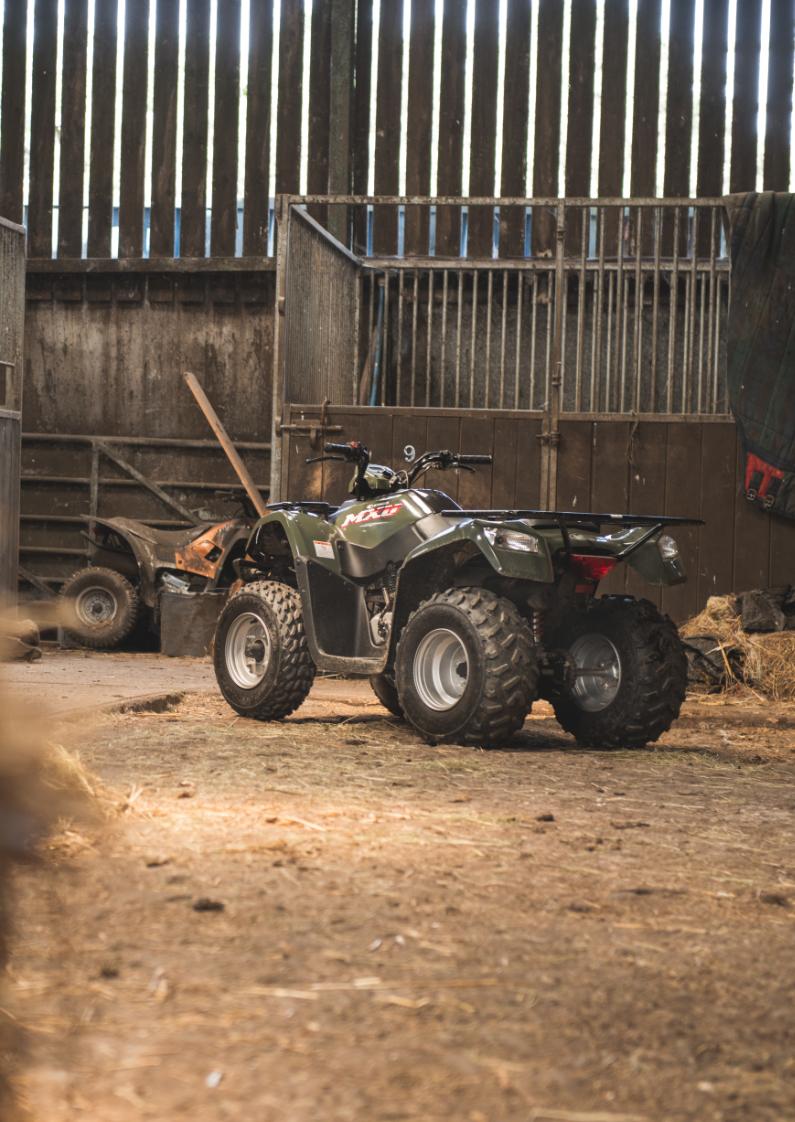


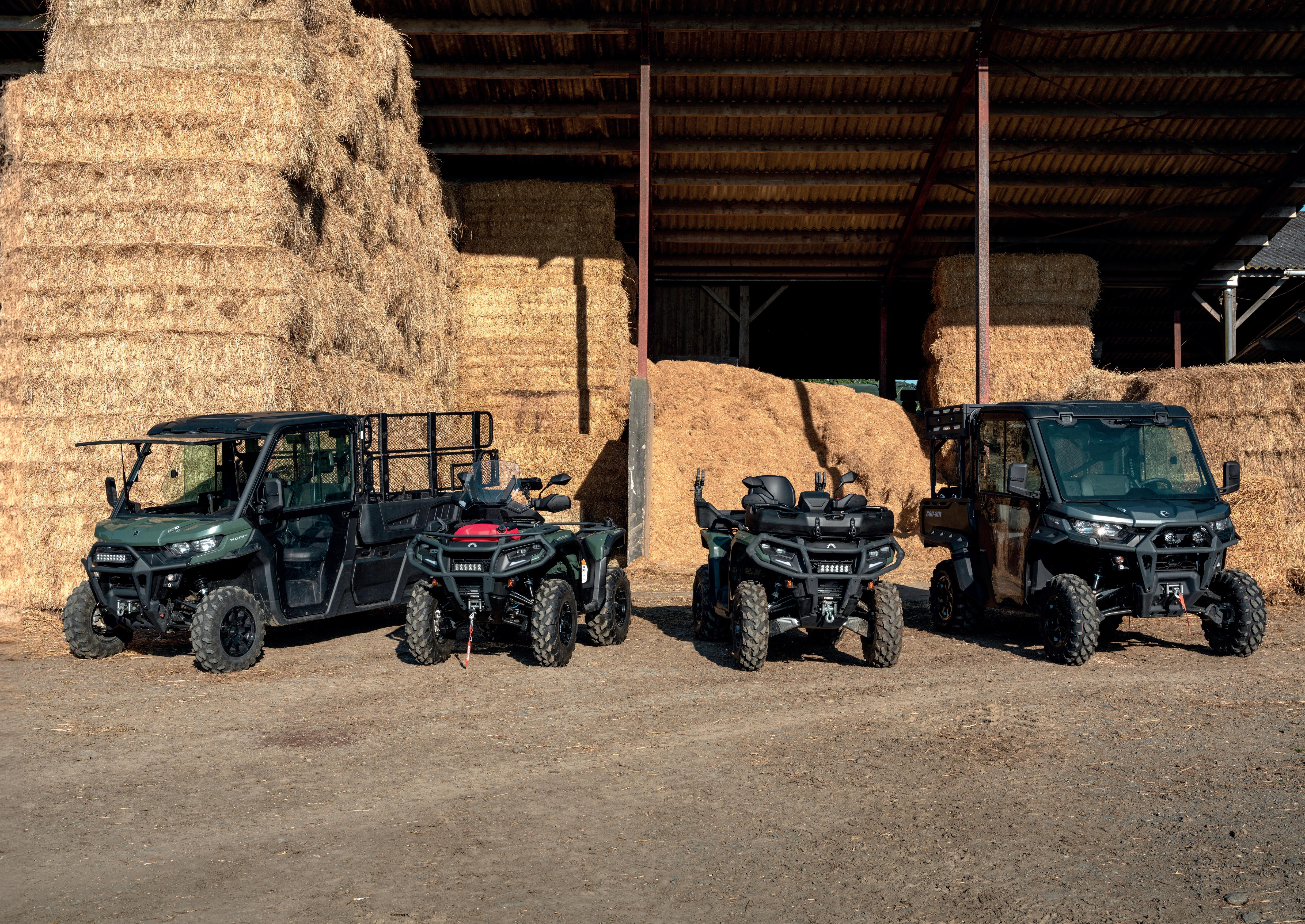


Farm, Wooler, Northumberland NE71 6QG (01668) 281 710,07860 836 173 www.andrewfrostfarmservices.co.uk

Germany's independent testing institute DLG Test Center Technology & Farm Inputs has awarded the BKT tires AGRIMAXFACTOR 600/70 R 30 and 710/70 R 42 the ‘DLG APPROVED’ quality mark for their results in the test module ‘Resources Protection’.

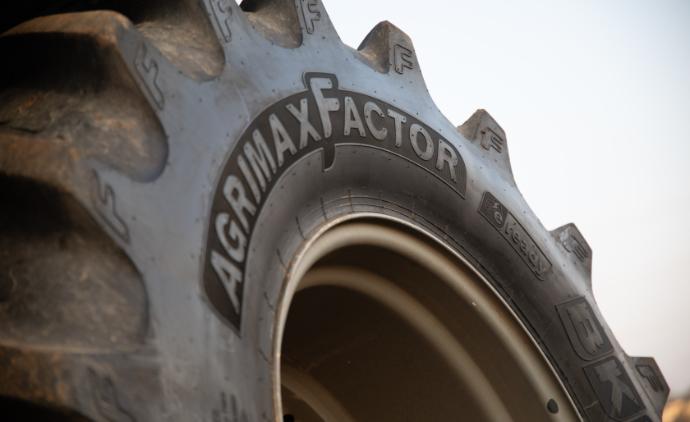
BKT, the leading multinational OffHighway tire manufacturer, gains for the second time the quality mark from the independent testing institute DLG. Having successfully passed stringent evaluation criteria, the BKT tires belonging to the AGRIMAXFACTOR range – in sizes 600/70 R 30 and 710/70 R 42 - have been awarded with the DLG APPROVED quality mark in the test module Resources Protection.
The primary objectives of the tests conducted by DLG included an analysis of the tires' effect on the soil and in terms of fuel consumption. These are two elements that are key factors nowadays when it comes to ensuring environmental sustainability and cost optimization in the farming sector.
The tests were conducted in two different phases: field tests on farmland under comparable operating conditions, and simulation tests of transport activities on both

slope and level ground on a DLG dynamometer test stand. This test performed as DLG PowerMix simulates real transport conditions on paths at different inclinations. The testing procedure enables the measurement of parameters such as the specific fuel consumption, performance at constant speeds as well as overall tire efficiency under controlled conditions.
The AGRIMAXFACTOR tires were compared against five competitor tires. The tests were conducted in March 2024 employing a John Deere 6R 250 tractor and a Claas Xerion as braking tractor. The measured ground pressure values highlighted a clear correlation between the contact area and the penetration depth. At all measurement depths (10, 20, and 40 centimeters)
AGRIMAXFACTOR
achieved the best results; the lowest ground pressure value of 0.13 bar is recorded at a soil depth of 40 centimeters and a tire inflation pressure of 0.6 bar.
The low pressure on the contact area, which on average produces a measured track depth of 7.1 centimeters, reflects the BKT tires' ability to generate a depth of just 6.5cm - thus 8% below the average value and 18% less than the last-placed competitor.

Another key point is fuel consumption. In the field tests, indeed, BKT tires recorded a by 1.7% lower fuel consumption than the average (17.4 l/ha); consumption in the transport tests was 0.3% below the mean value of the reference tires. Specifically, in the 40-km/h variant of the DLG PowerMix transport test, the AGRIMAXFACTOR tires sized 600/70 R 30 and 710/70 R 42 recorded a specific consumption of 367 g/kWh, whilst in the 50km/h variant consumption increased to just 372 g/kWh.
"Once again, BKT products have proven to be key players in the segment, distinguishing themselves from the competition by means of their high quality and outstanding performance, now also recognized by a trendsetting institution such as DLG. Having gained, for the second time in a year, the DLG APPROVED quality mark is a further confirmation of BKT's strong focus on the entire research and development process, as well as synonymous with meticulous design development that prioritizes farmland preservation and emission reduction," states Lucia Salmaso, Managing Director, BKT Europe.

The leading multinational Off-Highway tire manufacturer from India continues to pursue its growth goals, laying out ambitious future perspectives for the agricultural market and its players - starting from farm machinery manufacturers
Agriculture is an ever-evolving sector, which is highly influenced by the arrival of new technologies and increasingly innovative, state-of-the-art machinery. Today, traditional farming techniques are being overtaken by more efficient and productive operations - partly thanks to the arrival of Agriculture 4.0 applications, namely precision farming, IoT sensors, crop monitoring drones, as well as an entire series of devices and technologies that allow for 360-degree process optimization. A new scenario where sustainability is at the center of this transformation process.
BKT, as a leading Off-Highway tire manufacturer, has always been focused on continuous innovation and devotes significant efforts to research and development, pursuing its goal of bringing to life high-performance tires that meet stringent application standards and sustainability criteria. This is why BKT has analyzed the main trends that, according to the company, will shape the future of agricultural tires, matching the expectations of leading tractor and farm machinery manufacturers.
Sustainability and environmentally sustainable materials. There is a growing industry focus on biodegradable or recycled materials, making sustainability a priority for original equipment. As a response to this trend, tire manufacturers will increase their focus on the use of materials such as natural rubber or recycled compounds to reduce the environmental footprint. Also, the tire design will be conceived with due regard for improved fuel efficiency - and thus to lower emissions.
Smart tires and IoT integration. Nextgeneration tires will gradually integrate IoT sensors for real-time communication of pressure, wear, and performance data, also preventing maintenance interventions for reduced downtime. Moreover, the sensors will be able to provide relevant information on soil conditions, temperature, and load in view of optimizing overall performance and farming yields.
Endurance and durability. Increasing operational complexity requires ever stronger and more durable solutions. That is why compounds, tread design, and


sidewalls will be optimized for an enhanced product life-cycle and increased product suitability for both traditional and modern practices.
Advanced manufacturing techniques. On the production side, too, we will witness the advancement of cutting-edge techniques, such as 3D printing, which would greatly accelerate a tire’s time-tomarket while increasing their customization, thus meeting the specific needs of individual operators in a targeted manner.
Customization and adaptability. It is quite likely that in the future we will experience increasing flexibility and modularity of tires, which would then be able to easily adjust tire features according to the season, type
of application, and field conditions. Hybrid tires will also gain ground and be able to handle a wide range of agricultural tasks, leading to greater versatility.
Hence, the future of the tire industry, notably the premium tire industry, will therefore be increasingly influenced and determined by the ongoing advancement of technology and an increased focus on sustainability and crop protection. Futureoriented manufacturers like BKT, who make performance, durability, and the environment three main pillars of continuous improvement, will be emerging with a view to growth and their ability to meet the complex needs of modern manufacturers.
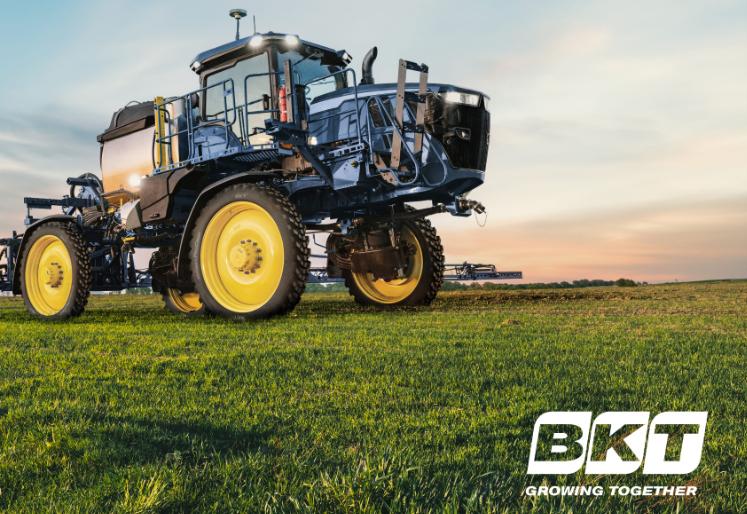
With 2025 marking the 40th anniversary of the light duty Prado’s introduction into Toyota’s global Land Cruiser range, worldrenowned extreme mobility vehicle specialists, Arctic Trucks (AT) are poised to redefine ‘cool and capable’ once again with the reveal of their highly anticipated Land Cruiser 250 / Prado AT37.
Originally founded in 1990 as a special vehicles division of Toyota, the AT37 marks the latest chapter in Arctic Trucks’ long-standing association with the leading Japanese automaker’s legendary Land Cruiser, which remains an integral part of AT’s unparalleled tally of world records and firsts in the harshest environments on earth.
Primarily developed between Arctic Trucks’ International (Iceland) and UK divisions, together with Toyota Africa distributor, CFAO, the Land Cruiser 250 / Prado AT37 combines Iceland’s deep heritage in off-road vehicle development with world-class expertise from the UK’s ‘Motorsport Valley’, the global centre of motorsport design, development and engineering, and a hub of cutting-edge automotive innovation.
Arctic Trucks International R&D Manager, Freyr Þórsson, said: “Developing this project in the heart of Motorsport Valley has allowed us to have frequent and direct face-to-face communications with multiple suppliers, and the resulting hands-on development has generated greatly improved performance.” Arctic Trucks UK Managing Director, Peter Smith, added: “This collaboration of teams across the Arctic Trucks group has resulted in a vehicle that is truly fit for use in any market. Combining our three decades of off-road expertise with technology and innovation from the UK supply chain has achieved outstanding results and reaffirms our ongoing commitment to delivering complete vehicle solutions for both work and play.”


Aligned with OEM and government standards of fit, finish and functionality, the visually imposing AT37 blends a finely tuned balance of confidence inspiring onroad handling, with superior clearance, comfort, control and mobility over all terrains. From rocky technical trails to soft snow, sand and everything in between, the AT37 achieves tracked vehicle capability with car-like drivability. #ExploreWithoutLimits and #DriveYOURadventure in the new Land Cruiser 250 / Prado AT37.
Drawing from over 35 years of unparalleled operational experience in our planet’s harshest environments, the Arctic Trucks Toyota Land Cruiser 250 / Prado AT37 is a completely re-engineered yet perfectly daily drivable high-mobility vehicle that commands attention wherever it goes.
Taking the name from its 37” rubber, the AT37 will be specified in most markets with a choice of either BFGoodrich’s new All-Terrain T/A KO3 or Mud-Terrain T/A KM3 tyres, for more grip, toughness and wear performance across a wide range of conditions. These are wrapped around Arctic Trucks’ new retro-inspired ‘Heritage’ forged alloy wheels, which offer better strength to weight and feature a unique dual-valve design for greater flexibility to monitor and modulate tyre pressures.


Improved ‘suspension effect’ from the AT37’s taller, wider tyres is combined with a bespoke 2-way adjustable performance suspension system, providing increased travel and 40mm of lift. Developed in partnership with Dakar-winning specialists, R53 Suspension, large diameter monotube dampers feature high tensile hard chrome steel shafts, enhanced sealing, matched springs and hydraulic bump stops. Low friction, nano-enhanced oil flow from external reservoirs is further enhanced by


R53’s OptiFlow technology, maintaining peak performance during the most mundane or exceptional of journeys.
To accommodate this significant increase in tyre size, Arctic Trucks have remained true to form by completely reprofiling the Land Cruiser’s frame, body, bodywork and drivetrain to balance maximum wheel/tyre and ground clearance with low centre of gravity. Combined with a wider track and extended wheelbase, this provides surprisingly comfortable, composed and direct on-road performance, while allowing the AT37 to venture with ease where others can’t.
Sharing unique design language with their extreme expedition vehicles, Arctic Trucks’ signature widebody flares incorporate a tyre pressure guide / central tyre inflation system connection recess in all four corners, while creating coverage, clearance and an unmistakable appearance that is noticed everywhere. Newly developed and contoured AT mud guards seamlessly integrate with the Land Cruiser AT37’s extended bodywork, providing ample protection during off-grid adventures.
Arctic Trucks’ usual attention to detail doesn’t stop there. Their robust extended profile side steps feature an extruded aluminium profile, high-grip rubberised inserts and durable end caps, for ease of replacement. These are complemented inside and out by distinctive Arctic Trucks black and lava badging and detailing throughout the bodywork, wheels and interior, which features unique gear selector and dash trims, together with premium AT interior mats and sill plates.
Concluding at the rear, the discrete 2” multifunction receiver hitch, common to most Arctic Trucks versions, enables quick, easy fitment of tow balls, winches, steps, seats, gear carriers, barbeques and much more; further maximising the AT37’s adaptability for the most leisurely or extreme situations.
As an official Toyota partner in multiple regions, Arctic Trucks will launch the Land Cruiser 250 / Prado AT37 from Q2 2025 as an official dealership-supplied version or direct customer conversion in Europe, North America, the Middle East and Africa. Thomas Cogez, TOYOTA Sales and Marketing Director, from CFAO (Africa) said: “We are excited to announce our collaboration between CFAO TOYOTA and Arctic Trucks on this innovative new Land Cruiser Prado AT37. By combining TOYOTA’s world-renowned engineering excellence with Arctic
Trucks' expertise in creating extreme off-road vehicles, we aim to deliver a next-level driving experience that will redefine performance and durability in challenging African terrains. Together, we are committed to pushing the boundaries of adventure and reliability, ensuring the Land Cruiser Prado and AT37 edition continues to lead the way in off-road capability.”
The Land Cruiser 250 / Prado AT37 is compatible with all engine/transmission options and trim levels, including both the passenger and commercial variants, and features:
• Extensive Arctic Trucks re-engineering to frame, body, bodywork and more
• 10-piece Arctic Trucks widebody package, featuring recessed AT tyre pressure detail (body colour & textured black)
• All-new 17×10 Arctic Trucks ‘Heritage’ dual-valve forged alloy wheels (satin black)
• 37” (37x12.50 R17) BFGoodrich All-Terrain T/A KO3 or Mud-Terrain T/A KM3 tyres
• New optimised and elevated Arctic Trucks & R53 2way adjustable performance suspension system, featuring longer travel front coilovers, rear dampers and springs (elevation: +40mm)
• Wider track and extended wheelbase (rear axle relocation) for improved clearance, comfort and stability
• Arctic Trucks and Toyota speedometer, TPMS and TSS re-calibration
• Robust extended profile Arctic Trucks aluminium and high-grip rubberised side steps
• Discrete Arctic Trucks 2” rear multifunction receiver hitch
• Contoured and integrated Arctic Trucks off-road mud guards, front and rear
• Arctic Trucks premium interior carpet mats (black & lava)
• Distinctive Arctic Trucks AT37 black & lava badging and detailing package (fender flares, doors, side steps, tailgate, wheels, mud guards, gear selector, dash binnacle, sill plates, interior mats, receiver cover)
• Arctic Trucks locking wheel nuts
• Arctic Trucks torque wrench
• Unique Arctic Trucks Land Cruiser 250 / Prado AT37 Certificate of Authenticity
*Specification, pricing, weights and dimensions may vary between regions

KGM Motors UK, formerly SsangYong Motors, is proud to announce the winners of its Dealer of the Year Awards. The awards, presented by KGM brand ambassador and TV personality, Fuzz Townshend, honour those who have demonstrated dedication, and excellence, in sales and aftersales on both national and regional levels.
The highlight of the evening was the prestigious overall ‘Dealer of the Year’ award, which was awarded to Station Garage for its remarkable performance across all business areas. The dealership also took home the National Sales Award and the Regional Sales Award, marking a hattrick of accolades for consistent excellence over the last 12-months.
Founded in 1979 in the village of Torphins in Aberdeenshire, Scotland, Station Garage has built a strong reputation over more than four decades, expanding in 1986 to accommodate growing demand. Today, it remains a cornerstone of the local community, offering new and used KGM sales alongside comprehensive aftersales services.
B V Rees and KGM Hereford jointly earnt the runners-up title for ‘Dealer of the Year’ and were recognised for strong commitment to delivering sales and aftersales results, as well as excellent customer service. Station Garage, B V Rees and KGM Hereford where also first, second and third prize winners, in the national sales category awards.
The National Aftersales Award was presented to Lamb and Gardiner, based in Coupar Angus, who was awarded for its dedication to high-quality aftersales support and exceptional customer care which earned them accolades on both national and regional levels. Lamb and Gardiner was followed
by C.S.G Pollitt in second place and Fields KGM in third place.
Kevin Griffin, Managing Director of KGM Motors UK, said: “We were, and are, thrilled to celebrate the achievements of our dealer partners at Dealer of the Year Awards in London on Saturday. The success of Station Garage as our Dealer of the Year, along with the incredible achievements of all of our winners, truly demonstrates the commitment to excellence across our entire network. I’d extend my congratulations to each winning dealership for their continued dedication and hard work. We look forward to even greater accomplishments in the year ahead.”
Kenny Cruickshank, General Manager of Station Garage, said: "Winning the Dealer of the Year award is a fantastic achievement and a testament to the hard work and dedication of our team. We take great pride in delivering exceptional service, and this recognition reinforces our commitment to meet every customer’s automotive needs. Furthermore, I’d like to thank our staff and loyal customers for their continued support, and we look forward to building on this success for the year ahead.”
The annual KGM Dealer of the Year Awards celebrate the exceptional performance of KGM’s 73-dealer partners, recognising outstanding achievements in both sales and aftersales, along with the highly coveted Dealer of the Year honours. This prestigious event took place at the renowned JW Marriott Grosvenor Hotel on Park Lane, London, bringing together the best in the business to celebrate their outstanding contributions to the KGM brand.
Regional sales and aftersales award winners are as follows:




BYD is celebrating another year of phenomenal growth in the UK. The company, which officially launched in the UK in March 2023, increased its volume by 658% to over 8,700 cars in 2024 –making it the UK’s fastest growing car brand.
In March 2023, BYD UK launched with the ATTO 3 Csegment SUV and since then has launched four new models in under two years – with the eagerlyanticipated SEALION 7 joining the line-up in the coming months. The company has grown from 14 retail sites to 60 retailers across the UK, with plans to add more sites in 2025.
The company’s best-selling model remains the ATTO 3, with the BYD DOLPHIN hatchback being BYD’s best-selling car in the retail sector.
Steve Beattie, Sales and Marketing Director, BYD UK: “In the past two years, BYD has gone from strength to strength and I’m immensely proud of the hard work and dedication of our team and retailers. BYD aims to bring high-tech and high-value cars to UK customers, and it’s fantastic to see more people choosing BYD.”
Brand awareness continues to grow with brand recognition increasing from 1% in 2023, to 31% in 2024. A huge contributor to brand growth was the company’s sponsorship of the EURO 2024 football tournament which reached a global audience of over a billion. Brand awareness also received a significant boost thanks to the launch and media campaign in Q4 2024 of SEAL U DM-i, which has quickly established itself as a core model in the BYD UK range. BYD will continue investing in brand awareness throughout 2025.
While BYD passenger cars is relatively new to the UK, BYD has a long and successful history in the UK thanks to its commercial vehicle division. BYD introduced its first fully-electric buses on UK roads in 2014, and now has over 2,000 buses in operation in major cities across the country. Plus, since 2016, BYD has provided 1.8GWh of battery energy storage to the UK’s national grid.











Dacia’s offer of the best value for money on the market is once again recognised after winning a hat-trick of awards at the What Car? Car of the Year Awards 2025.
The Sandero, famed for offering affordability without compromise, was named the ‘Best Small Car for Value’ for the fourth consecutive year. It also marks the 12th time that the model has been recognised at the awards. With prices starting from £14,200 onthe-road, the Sandero remains the most affordable car in the UK.
Dacia’s versatile family car, the Jogger, was named the ‘Best Seven-Seater for Value’ for the third year in a row. With a mix of SUV and estate car design, and unrivalled value with pricing starting from £18,400 on-the-road, it’s no surprise sales jumped 77% in 2024 compared to the previous year.
The latest generation Duster also continues its

winning streak, being named the ‘Best Small SUV for Value’. With prices starting from £18,850, its modern, robust design, practical interior as well as the option of 4x4, is already striking a chord with the nation.
What Car? Editor, Steve Huntingford, said: “Tempting pricing is obviously key to the appeal of the Sandero, Jogger and Duster. Crucially, however, they also deliver real value for money, because they’re practical and comfortable choices that offer a level of technology you wouldn’t expect.”
Luke Broad, Dacia Brand Director for the UK, added: “Dacia is always focussed on giving the best value for money on the market, so to win three-value based awards from the professionals at What Car? magazine and website is fantastic. To win two of these awards for multiple years is exceptional, and really proves that our offering is an unrivalled combination of affordability without compromise.”


Continuing its growing number of awards in 2025, Isuzu D-Max has been named ‘Pick-Up of the Year’ in the Company Car & Van Awards 2025. This marks the fourth consecutive year that The Pick-Up Professionals have triumphed in this category, a testament to the capability and performance of the D-Max.
Carrying a strong momentum into 2025, following back-to-back record sales years, the Isuzu D-Max has turned many heads with its workhorse pedigree and well-documented reliability.
One of which is Editor and Publisher at Company Car & Van, Andrew Walker, who commented: “When a pick-up wins an award 4 years in a row, it must be doing something right and the D-Max does that alright. It's available in a myriad of conversions and a range of single, extended and double cab models to suit all customer needs. It'll do the rough stuff whilst also tackling the urban jungle too.”
With an impressive range, from the work-ready Utility trim to the highest specification V-Cross offering, the Isuzu D-Max provides uncompromised
levels of performance. The pick-up boasts a 1tonne payload and 3.5-tonne towing capacity, in addition to shift-on-the-fly 4WD and 360Nm of torque, helping its way to becoming the ideal companion for businesses.
Managing Director at Isuzu UK, Alan Able, said: “It is a privilege to be announced as the ‘Pick-Up of the Year’ for a fourth year running from Company Car & Van. We enter 2025 with a strong amount of momentum off the back of a second successive record sales year, which has shown that our offering is highly competitive and well-received by our customers. This is further underscored by our class-leading dealer network and manufacturer warranty which has also received a significant amount of industry recognition over last few years.”
Company Car & Van has been in publication for 15 years and has been a beacon of expertise for fleet managers and company directors overseeing fleets of fewer than 100 units. Targeted to those with the authority to shape their company's vehicle fleet, the publication provides invaluable insights into the latest developments, trends, and innovations in the automotive sector.


Subaru UK & Ireland today announces pricing and specifications for the all-new Forester e-BOXER, marking the official UK launch of the latest generation of the brand's capable SUV, which has sold over 5 million units globally since its 1997 debut.
Available to order from February 12, 2025, through Subaru's UK dealer network, the new All-Wheel Drive Forester combines the marque's renowned all-weather, go-anywhere ability with improved refinement, enhanced driving dynamics, and the latest safety technology. Prices start from £38,995 for the Limited model, rising to £42,995 for the range-topping Touring variant.
Built on the evolved Subaru Global Platform, the new Forester showcases technical advances across its chassis and powertrain. The platform now features full inner frame construction and expanded use of structural adhesive, with the coated length between spotweld areas extended from 8m to approximately 27 m. This engineering enhancement, combined with increased rigidity at suspension mounting points, delivers a 10% improvement in chassis torsional rigidity compared to its predecessor.

Driving Stop System - a first for Subaru - which activates if the driver becomes incapacitated. This works alongside the upgraded Driver Monitoring System, which now offers additional safety and convenience functions. The software-based safety improvements are complemented by significant hardware changes, including the introduction of front seat centre airbag and passenger seat cushion airbag, as well as a revised front bumper beam layout, optimized to dramatically improve collision energy absorption efficiency.



The Forester retains Subaru's signature combination of Permanent Symmetrical All-Wheel Drive and e-BOXER hybrid powertrain. The 2.0-litre horizontally opposed four-cylinder engine features 24 technical improvements, working in harmony with the hybrid system and refined Lineartronic transmission to deliver enhanced driving characteristics. The new dual-pinion electric power steering system (EPS) provides improved response and more natural feedback, inspiring even greater confidence, whatever the conditions.
The new Subaru Forester combines enhanced on-road dynamics with class-leading off-road ability, made possible thanks to its peerless All-Wheel Drive traction and 220mm of ground clearance. This is allied with an impressive approach, ramp breakover, and departure angles of 20.4°, 25.7°, and 21.0° respectively, complemented by a substantial 1,870kg towing capacity.
Subaru has long been a leader in automotive safety, and the new Forester continues this tradition. This new model features the latest iteration of Subaru’s EyeSight Driver Assist Technology, representing a significant advancement in collision prevention safety. Now featuring a wide-angle monocular camera and new front radar, the system offers enhanced recognition performance across its 15 functions, including five new features. Notable among these is the Emergency
Interior refinement has also been elevated further from the previous generation Forester, with cabin noise reduced by 39% for a calm and cosseting driving environment. New front seats minimise head sway, reducing movement by approximately 44%, significantly improving comfort on long journeys while enhancing conversation clarity by 3.4% in the front and 12.5% in the rear.
The modernised and light-filled cabin features a new 11.6-inch Full HD infotainment system with improved operability - while retaining physical buttons and switches for climate control and other key functions. The updated infotainment suite includes wireless Apple CarPlay and Android Auto compatibility, as well as enhanced navigation supporting both Apple Maps and what3words - ideal for tracking down remote locations. The interior is also equipped with both Type-C and Type-A charging ports, so electronics can be easily topped up, even when in the wilderness.
Other practical touches include a generous boot capacity of 508 litres (expanding to 1,720 litres with rear seats folded) and an optional hands-free power tailgate. All-round direct vision has been optimised through carefully designed pillars and an extensive glass area. This is complemented by the new 360° Multi-View Monitor system, aspherical door mirrors, and LED cornering lamps.
Lorraine Bishton, Managing Director of Subaru UK, commented: “The arrival of the all-new Forester marks an exciting chapter in Subaru's UK story. This model has been central to our heritage for over 25 years, embodying the durability, capability and safety that Subaru is known for. The significant advances in this new generation of Forester, particularly in terms of refinement and technology, come at a perfect time as we continue to strengthen our presence in the UK market. This new Forester will play a crucial role in our UK growth strategy, appealing to both our loyal customers and a new generation of SUV buyers, who prioritise genuine capability alongside comfort and safety”.












We were recently invited by Subaru UK to the picturesque countryside of Oxfordshire to get behind the wheel of the all-new 6th generation Forester.
This latest iteration promises to build on Subaru's reputation for safety, toughness, and driving enjoyment; combining the rugged capability we need with modern advancements that make it more versatile than ever before, so I was eager to see how the Forester has evolved.
The Forester has long been a standout in the Subaru lineup, having accumulated awards; so many, in fact, that Subaru stopped counting after 90. The newest model certainly continues this tradition of excellence, with notable enhancements that further elevate its already impressive credentials.
The Forester's rugged appeal is front and centre with this new model, and I love that it still looks unmistakably like a Forester. Its broad-shouldered stance and boxy design, synonymous with Subaru’s tough 4x4 heritage, make you feel confident behind the wheel. The compact A-pillars and the lower shoulder line
offer better outward sightlines while giving the Forester a fresh, more modern look. Despite these updates, the iconic silhouette is still there and keeps its distinctive personality.
Inside, it is clear Subaru has focused on enhancing comfort, convenience, and technology. The cabin feels luxurious, but not too so, that you are scared of getting mud in there, in fact, the trim has design textures throughout, all in the right places where a quick wipe clean will get the cab ready for action after a busy and muddy day. The upgraded driver monitoring system ensures better driver safety with improved attention and fatigue detection. The 11.6-inch high-resolution multimedia touchscreen is the standout feature in the centre console, offering intuitive control over the car’s entertainment and navigation systems. Some physical buttons remain for essential controls, keeping a balance of tradition and modern tech. Heated seats now cover a greater area, offering added comfort during colder months, and drivers have really been considered with thoughtful details like illuminated ports and wireless charging.
A standout feature for me is that the
What3Wordssystem comes as standard on the FIELD and TOURING models, offering pinpoint accuracy even offline—perfect for finding specific gates or fields when you are off the beaten track. Postcodes are not specific enough in the countryside, so Subaru have really considered their rural customers here.
The Forester continues to offer its signature permanent all-wheel-drive system, making it well-equipped for all kinds of terrain. Powered by a 2.0-litre flat four-cylinder petrol engine, the Forester delivers smooth and capable performance while maintaining the rugged toughness Subaru is known for. Its towing capacity remains an impressive 1,870kg, ensuring it can handle everything from trailers to campers with ease.
One of the key highlights of the 6th generation Forester is how it feels on the road. It is lighter than the previous generation, making it nimble and responsive without sacrificing the robustness that makes it a go-anywhere vehicle. With a ground clearance of 220mm, it retains the capability to tackle rough terrain, while the 10% increase in torsional rigidity improves overall stability and ride comfort.
New LED cornering lamps add an extra layer of safety, helping illuminate the road as you navigate tricky corners.
Starting at £38,995, the 6th generation Forester is the only all-wheel-drive vehicle under £40k, making it one of the most affordable 4x4s in its segment. For that price, you get a durable, well-equipped SUV that offers exceptional value. It also comes with a 3-year/100,000-mile manufacturer's warranty, providing added peace of mind.
The new Forester remains true to the core values that Subaru enthusiasts know and love—safe, tough, and fun—while evolving to meet the needs of a new generation of drivers. With its impressive range of features, high level of craftsmanship, and unbeatable off-road capability, it’s clear the Forester is ready for anything.
Available now through Subaru’s dealer network, most of which are rurally based and family-run; they are on hand to help you on your buying journey. With three spec levels— LIMITED, FIELD, and TOURING—and with 8 different colour options to choose from, it will be easy to fall in love with.
Jennifer Mills - Farming Monthly



CA Auto Finance, the UK subsidiary of CA Auto Bank, and KGM have deepened ties to launch ‘KGM Financial Services’, offering consumers a seamless vehicle financing experience through an extensive catalogue of retail and contract hire finance products, value added products, and wholesale financing under the brand.
Drivalia which is the rental, leasing and mobility company of the CA Auto Bank Group, will continue to provide its services using the KGM Leasing brand.
After funding more than 1,000 vehicle purchases since the partnership between CA Auto Finance and KGM was announced in December 2023, the launch of KGM Financial Services represents a further strengthening of ties between the two companies.
CA Auto Finance and KGM UK will aim to grow the KGM Financial Services brand in 2025, providing dealers and partners with marketing collateral to promote its services to customers.
Christian Gorton, Marketing Director at CA Auto Finance, said: “We had an exceptional

year at CA Auto Finance in 2024 and the launch of KGM Financial Services with our partners at KGM UK offers an exciting start to the new year as we seek to grow the brand’s presence and awareness in the UK market. We look forward to working with the KGM UK team to establish KGM Financial Services as a unified and recognisable brand for consumers looking to finance their new vehicle purchase.”
Kevin Griffin, UK Managing Director at KGM
UK, said: “We are delighted to launch KGM Financial Services in partnership with CA Auto Finance. This joint venture provides customers with the opportunity to obtain retail financing through a trusted company, and gives access to strong offers with low deposits, low interest rates and a host of products.”
To find out more about CA Auto Finance, visithttps://www.ca-autofinance.co.uk


INEOS Automotive’s Hambach plant is back to action stations after a pause in production for the Grenadier and Quartermaster 4X4s. The resolution of a critical shortage of seats after supplier insolvency at the end of last year sees the production line restart on-time, as announced in November.
“This is a great start to the year for us, one I strongly believe will be our best yet and will build on the more than 40% growth year over year we achieved in 2024”, commented Lynn Calder, CEO INEOS Automotive.


“We are so proud to have more than 20,000 Grenadiers on the roads and trails around the world. Significant new markets like Mexico and China created incremental demand just when we had to hit pause on the production line, so it is heartening to already hear the familiar ‘toot’ as vehicles roll through the quality check lines again. We’ve got some catching up to do, but we’re up for the challenge.”
The plant celebrates the start of its third full year of Grenadier series production, with customer orders already leaving the plant gates. The first vehicle off the line on January 16th was a Scottish White Utility Wagon (5-seat) destined for southern France, followed by a pair in Devil Red - a bold, new exterior colour.
Devil Red marks the first opportunity to tweak the product offering for Grenadier Station Wagon and Quartermaster, adding the eleventh shade – a solid red available with the contrast roof in white or black. Also joining Devil Red off the line for the new year will be customer orders of Grenadier 1924. Adding a package of key lifestyle accessories and


premium design flair for customers that want to add timeless and durable style to their 4X4’s substance, the Belstaff centenery celebration special edition is limited to 1,924 units.
All has not been quiet, however. With smart ForTwo production coming to an end earlier in 2024, the now defunct production line has been dismantled to open further space for future INEOS product developments.
“We’re very grateful for the patience of our customers, suppliers and production teams as we worked through a difficult situation. We are very proud of our Hambach facility, it is testament to the grit and rigour that underpins INEOS, reopening the doors ready to build on the solid foundations laid last year”, added Philippe Steyer, President INEOS Automotive SAS.
The INEOS Grenadier is now available to customers in 50 countries world-wide, having opened the doors to Mexico and China at the tailend of 2024.


The new MG HS SUV has achieved a double win at the 2025 What Car? Car of the Year Awards. The MG HS PHEV was judged ‘Plug-in Hybrid of the Year’ by the What Car? team whilst the petrol HS SE was crowned ‘Best Family SUV for Value’. Steve Huntingford, Editor at What Car? commented:





The MG HS PHEV, which made its global debut at the Goodwood Festival of Speed last summer, was praised by the What Car? judging panel for its premium cabin as well as the impressive, electriconly range of up to 75 miles. The What Car? team added:
"While most of the cars in its class really only make sense as company cars, the MG HS shows that a practical plug-in hybridwith an upmarket interior and a long electric-only range can also be a surprisingly affordable private buy."
Continuing MG’s reputation for offering customers outstanding value in the SUV marketplace, the petrol HS SE 1.5T, recognised as the ‘Best Family SUV for Value’, is available from just £24,995.
"In 1.5-litre petrol form, the only alternatives to the MG HS that are available for similar money are both smaller and far less practical,” noted the What Car? experts.
David Allison, Head of Product and Planning at MG Motor UK, commented:
“The new MG HS models were designed to raise the bar even higher with more equipment and functionality, distinctive MG styling setting them apart from other SUVs, as well as a choice of advanced petrol or plug-in hybrid powertrains. Two awards from the What Car? experts are a great endorsement for our best-selling MG, and we’re confident that this accolade will attract even more new customers to our brand, as well as impressing existing owners looking for an upgrade.

"MG's product offering continues to impress the What Car? team. The HS SUV follows in the footsteps of the award-winning MG4 EV hatchback, being another very competent all-rounder."
The Plug-in Hybrid version offers a real alternative for families who love their SUVs but are put off by high running costs. A range of 75 miles due to the high-capacity battery means most daily commutes can easily be covered by one charge, and for longer journeys, the added security of an efficient petrol engine and large fuel tank makes it a compelling choice.”
MG HS SUV models secured 30,207 sales in 2024 making this MG the 8th best-selling car in the UK. MG was also ranked 10th in terms of UK vehicle registrations, a first for the brand.
The new generation of the HS range offers customers the best possible overall value in the SUV marketplace. The petrol HS SE 1.5T is available from just £24,995 with the range-topping HS Trophy PHEV priced from £33,995. And, like all MGs, there is a generous 7-year/80,000-mile manufacturer’s warranty supported by a 160 strong dealer network.

Polestar Energy – the Swedish allelectric performance brand’s innovative new energy initiative –is now fully live in the United Kingdom. After a successful pilot scheme here in the UK, Polestar Energy offers customers smarter, more efficient and cheaper home charging.
With the Polestar Energy app, customers decide when they want to use their car and desired charging level, and smart charging
demand the renewable energy mix is often higher, meaning charging your EV using the Polestar Energy app can be kinder to the environment.
The initiative compliments Polestar Charge which enables customers to easily charge at over 875,000 charging points in Europe including Tesla Superchargers, for charging away from home to provide a complete charging ecosystem.

takes care of the rest – charging when it makes sense for the grid. By balancing the demand, and charging when demand is lower, the result is lower energy costs when customers receive their electricity bill.
For Polestar drivers in the UK, Polestar Energy integrates smart charging with a Zaptechome chargerand Intelligent Octopus Go energy tariff. This minimises total cost of ownership by smart charging for just 7p/kWh during off-peak hours*. This means that when smart charging combined with additional grid rewards, customers can benefit from saving up to 70% compared to cap rates**. The net result is a significant reduction in the total cost of ownership for Polestar customers.
There is also a reduction in CO2 in the usage phase of the car, as at times of lower grid
Michael Lohscheller, Polestar CEO, says: “As the only global premium EV brand it’s important that we offer our customers such a compelling charging offer to make using their cars easier and more costeffective. Up to 70% reduction on charging costs at home versus cap rates can make a big difference, and so we’re rolling this offer out at scale, with more markets to come later this year. When we add vehicle-togrid capabilities in Polestar’s line-up it will add even more value to our customers.”
Later in 2025 Bi-directional charging with vehicle-to-grid and vehicle-to-home capabilities, first targeted on Polestar 3, will allow customers to use their vehicle as energy storage and send back excess energy to the grid or even power their home.
Customers looking to take advantage of this offer need to have a compatible home charger. They can choose the Zaptec wallbox with smart charging capability directly from Polestar through an exclusive offer including installation cost. Please visit https://www.polestar.com/uk/ charging/home-charging/wallboxes/ for more information.
The Polestar Energy app can be downloaded for free on your smartphone.

BThe all-new Škoda Elroq has started 2025 in style by taking home one of the top honours at the annual What Car? awards. Ahead of the first customer deliveries in April, the compact all-electric SUV has been named Family Electric SUV of the Year in what is widely regarded as the ‘Oscars’ of the automotive world.

The Elroq is the second all-electric Škoda model to be built on the Volkswagen Group’s advanced MEB and sits below the multi-award-winning Enyaq in Škoda’s revised range. The What Car? judging panel praised the new Elroq for its design and build quality and highlighted the newcomer’s impressive driving range.
Explaining why the new Elroq took the award, What Car? Editor Steve Huntingford, said: "The Škoda Elroqimpresses even before you drive itbecause it's practical and very well priced. Then, when you do get under way you realise that it corners with composure, has a well-controlled ride and is impressively refined. An official range of 360 miles shames some cars that cost half as much again and only adds to the Elroq’s credentials as a great way to cover big distances.”
Available with four familiar trim grades; SE, SE L, Edition and SportLine, all models in the new Elroq range enjoy generous standard specifications. Prices range from £31,500 for the entry-level SE model with a 55kWh (52kWh net) battery, and starts from £37,400 for the range-topping SportLine model equipped with the largest 82kWh (77kWh net) battery.
The Elroq brings Škoda’s acclaimed practicality and value to one of the most competitive sectors in the
new car market. It is the first Škoda model to feature the brand’s striking new ‘Modern Solid’ design language - a dramatic new look that will influence the design of future Škoda models.
While the Elroq took the title in the Family Electric Car category, the Scala was named as Best Value Family Car 2025. The commendation reinforces the hatchback’s reputation for delivering exceptional value for money and class-leading practicality.
A full database of media assets, including images, b-roll video and technical information is available at www. skodamedia.com




The all-new Mazda CX-80 has been named Best in Class Large SUV by Euro NCAP in its latest series of tests. This prestigious recognition underscores Mazda's commitment to safety and innovation.
In 2024, Euro NCAP tested a total of 44 cars, with the Mazda CX-80 emerging as the top performer in the Large SUV category and achieving a close victory over the Audi Q6 e-tron. This recognition is a testament to Mazda's dedication to providing the highest level of safety for its customers.
The Mazda CX-80 achieved an outstanding 92% score in Adult Occupancy, with full marks in both the Lateral and Rear Impact tests. It scored an impressive 88% in Child Occupancy, ensuring the highest level of protection for younger passengers. The vehicle secured an 84% score for Vulnerable Road Users, highlighting Mazda's dedication to pedestrian and cyclist safety. Additionally, it achieved a 79% score in Safety Assist, demonstrating Mazda's commitment to equipping its vehicles with the latest safety technologies.
The Mazda CX-80's superior safety performance is
complemented by its comfort, convenience, and versatility, making it a standout in the seven-seat SUV segment. Crafted in Japan, this flagship model embodies Mazda's design and engineering excellence. Its exceptional safety ratings reflect Mazda's dedication to customer safety. The fivestar rating is supported by Mazda's Skyactiv MultiSolution Scalable Architecture, enhancing driving dynamics with a front-engine, rear-wheel-drive layout and rear-biased all-wheel drive. With three rows of seating, the CX-80 is the most spacious vehicle in Mazda's European range, offering comfort, versatility, advanced technology, and Mazda's driving performance.
Established in 1996 with the aim of improving vehicle safety, Euro NCAP annually awards the best-scoring cars with the "Best in Class" title, helping consumers choose the safest vehicles for their needs. To determine the 'Best in Class' rating, Euro NCAP calculates a weighted sum of scores in four safety evaluation areas: Adult Occupant, Child Occupant, Pedestrian and Safety Assist. This total is used to compare cars. Cars qualify for 'Best in Class' based on their ratings with standard safety equipment.
Arriving in the UK later this month, the all-new Mazda CX-80 is the new flagship of the Mazda line-up in Europe, sitting above the CX-60 in Mazda’s award-winning SUV range. Featuring three-row seating it’s the most spacious SUV ever offered by Mazda in Europe and with its highquality cabin, technically advanced drivetrains and elegant design is created to challenge established premium brands in the European market.
Powered by the same engines as the Mazda CX60, there is a choice of plug-in hybrid - which combines a Skyactiv-G 2.5-litre four-cylinder petrol engine with a 129kW electric motor and a 17.8 kWh high-capacity battery – or Mazda’s advanced in-line six-cylinder 254ps 3.3-litre e-Skyactiv D diesel engine. Across both powertrain options, the Mazda CX-80 is exclusively matched to all-wheel drive.
Dimensionally, the all-new Mazda CX-80 sees the wheelbase grow by 250mm compared to the CX60 to deliver the space needed for a practical three-row interior. Furthermore, to ensure passenger comfort, the CX-80 is 26mm taller than the CX-60. However, with an identical width to the CX-60, the CX-80 retains familiar styling and nose on profile of its smaller sibling.
Offered in the UK across five highly specified grades: Exclusive-Line, Homura, Takumi, Homura Plus and Takumi Plus with option packs to allow customers to tailor their seat layouts and equipment. With maximum customer choice in mind when the CX-80 arrives in the UK it will be offered with a choice of three middle row configurations: a three-person bench seat, two captain’s seats with a walk-through space or two captain’s seats with a fixed centre console. The seven-seat layout with the middle row-bench will
be standard and is expected to be the biggest seller in the UK, while the two different six seat layout configurations will be optional.
Crucially, thanks to the CX-80’s increased wheelbase, shoulder room, headroom, hip point spacing and front to second row couple distance measurements have all increased compared to the CX-60. While full UK specification of the all-new Mazda CX-80 will be announced later, new to Mazda highlights include Alexa* in-car voice control of music, air-conditioning, navigation and thirdparty apps.
Viewed from the front the all-new Mazda CX-80 is visually matched to its CX-60 sibling but it’s in profile where the expression of elegance has been refined by taking full advantage of the CX-80’s increased length to create an imposing and cohesive design. The extended side windows feature thicker surrounds that are straighter at the D Pillar to emphasise the presence of the third-row of seating, while the seamlessly integrated roof rails further highlight the length of the CX-80’s cabin.
Based on Mazda's safety philosophy, ‘Mazda Proactive Safety’, the all-new Mazda CX-80 provides a comfortable driving environment with outstanding visibility. It’s comprehensive range of advanced i-Activsense driver assistance systems –including Cruising & Traffic Support (CTS) with new Unresponsive Driver Support; Smart Brake Support with new Head-on collision mitigation; and Emergency Lane Keeping with new Head-on traffic avoidance assist – ensure active safety at the highest level, cementing the model’s five-star Euro NCAP safety rating and Best in Class Large SUV achievement.


For the upcoming model year, there will be two main tech upgrades for the XC40, EX40, EC40, V60 and V90 models.
We’re introducing our new-generation, new-look user experience to our whole line-up, as well as the ultra-fast Snapdragon® Cockpit Platform* from Qualcomm Technologies, Inc. This makes the infotainment system much faster and much more responsive.
Additionally, EX30, EX40 and EC40 models in Europe will get the Plug & Charge service, for an even smoother public charging process.
Volvo Car UX: designed to be safe, focussed and personal We aim to make complex things simple, and we use real-world data and customer feedback as the basis for our work. This is the philosophy behind our new-generation user experience, called Volvo Car UX, already seen in the EX30, EX90 and new XC90.
It’s designed to be a safe and enjoyable way to interact with your car’s central infotainment screen, more focused and personalised than its predecessor, with several Google services built in**.
Examples include putting the apps and features you most often use, such as maps, media and phone, on the home screen for quicker access. In a similar logic, the contextual bar changes what you see according to the situation and displays your most recently used apps. The driver display, located just behind the steering wheel, has also been updated with a larger and clearer navigation view.
Starting this year, all models mentioned above will come equipped with the new Volvo Car UX. We will also deliver it to millions of Volvo cars with Google built in** through a simple over-the-air software update. Later in 2025, around 2.5 million customers around the globe will get an upgrade to their Volvo cars built as early as 2020***.
“By introducing our new-generation Volvo Car UX across our line-up, we’re working towards the aim that every Volvo model – regardless of platform
and powertrain – should offer a similar user experience, providing our customers with more choices,” says Erik Severinson, Volvo Cars’ chief product and strategy officer. “This roll-out is in line with our strategy to make our cars better over time with over-the-air software updates and goes hand in hand with our ambition to keep investing in our entire car line-up.”
You might recognise our other upgrade from the EX90 and EX30 models. The next-generation Snapdragon Cockpit Platform makes our existing Google Android Auto-based infotainment system much faster and much more responsive. The infotainment system in these models will be more than twice as fast as the outgoing system, with graphics generation that is up to 10 times faster.
“This boost creates a lag-free infotainment system that displays the right information at the right time – essentially helping us to decrease driver distraction and help you be a safer driver,” says Anders Bell, Volvo Cars’ chief engineering and technology officer. “By improving our in-car connectivity, Qualcomm Technologies helps us to deliver even more value to our customers. We both share a vision of the software-defined car and how it enables premium in-car experiences that are personalised, more entertaining and continuously upgradable.”
The Snapdragon Cockpit Platform will also be added to the new XC90 SUV this year.

Seamless charging process
Finally, Plug & Charge will be added to this years’ EX30, EX40 and EC40 cars in Europe. Plug & Charge is an authentication and billing system that simplifies the charging experience.
“With Plug & Charge, you just drive up to a compatible charging station, hop out, plug in and go about your day,” says Erik Severinson. “When you’re back, it’s the same carefree approach –everything is already sorted by the system.”
Plug & Charge is set up and activated via the car, and you can easily find compatible charging stations using Google Maps in your car’s centre display or the Volvo Cars app. These stations identify your car and its associated payment method as soon as you connect the charging cable to your car. The charging starts automatically, with no need for additional cards or authentication, and payment is processed seamlessly.
The UK-specific product offering will be confirmed at a later date.
• The factory upgrades will be available on the 2026 model year versions of the XC40, EX40, EC40, S60, V60, V60 Cross Country, V90 and V90 Cross Country models. The Snapdragon chip is also introduced on the new XC90. The availability and timing will vary from market to market.
• More information on additional 2026 model year updates across our range is coming soon.
• *Snapdragon is a trademark or registered trademark of Qualcomm Incorporated. Snapdragon is a product of Qualcomm Technologies, Inc. and/or its subsidiaries.
• **Or its equivalent in China and South Korea.
• ***Including C40, XC40, EX40, EC40, S60, V60, V60 Cross Country, XC60, S90, V90, V90 Cross Country and XC90 with the Android operating system.
• Google, Google Maps, Android and Android Auto are trademarks of Google LLC.


Kia has won three awards at the prestigious 2025 What Car? Car of the Year awards, with major category wins for the Kia EV3 and Sportage, as well as the upcoming EV4.
2025 marks yet another year of widespread success for Kia at the What Car? Car of the Year Awards. The brand has collected multiple trophies across its entire model range within the last five years, with EV3, EV4, EV6, EV9, Sportage, Sorento and Picanto each collecting at least one What Car? award.
The Kia EV3 is the brand’s latest electric vehicle to hit the roads in the UK, with first customer deliveries commencing in Q4 last year. Kia’s most affordable EV to date, the model offers classleading space and seating for five and a range of up to 375 miles on a single charge1. Its innovative driving technologies, including its new regenerative braking system and active air flap technology, also serve to maximise efficiency in all conditions.
The judging panel, made up of the magazine’s team of expert road testers, commented: “The EV3 is one of the most practical cars in its class, offering enough passenger and boot space to embarrass some models from the class above. What's more, it has an excellent driving position
that puts you well above the road – just as an SUV should. All of this is combined with soft suspension that's great at soaking up bumps and potholes.”
This award represents the latest in a steady stream of accolades for the EV3 from a number of UK publications, continuing the model’s momentum as it commences its first full year of sales.
For the third consecutive year, the Kia Sportage has been named ‘Best Family SUV’, with several factors including value-for-money and practicality making it the publication’s choice for hassle-free family motoring.
The What Car? judging panel remarked on the Sportage’s award win, saying: “The fact that this is the third year in a row that the Sportage has won this award shows what a brilliant all-rounder it is. For starters, it's great to drive, because it strikes a fantastic balance between comfort and control. The interior is as smart as it is practical, too. And yet the Sportage is very temptingly priced – particularly in mild-hybrid petrol form.”
The fifth-generation Kia Sportage was introduced in early 2022, winning What Car?’s ‘Best Family SUV’ award in 2023, 2024 and now 2025; an evident continuation of the family-friendly characteristics which made the model’s


predecessors such a hit. In 2024, the Sportage exceeded expectations once again, recording an all-time best sales year with 47,163 units finding homes in the UK, while the model maintained its place as Kia’s UK, European and Global bestseller.
The Sportage also became the UK’s second most popular car in 2024 and took the crown of bestselling SUV for the year overall, thanks in no small part to its enduring appeal and range of efficient and electrified powertrains.
Following in the footsteps of Kia’s flagship EV, the EV9, the Kia EV4 has been named winner of the ‘Readers’ Choice’ Award. This trophy is voted for by What Car? readers, who chose the upcoming EV4 as their most highly anticipated new car of 2025, the vehicle’s first ever award from any publication, worldwide.
“Before every What Car? Awards, we ask our readers to name the upcoming model that they're most excited about. And this year more than 40% of respondents picked the EV4, meaning it attracted around twice as many votes as the next most popular model," commented What Car?’s panel of judges.
Kia revealed the Concept EV4 at its inaugural ‘Kia EV Day’ in October 2023. Revealed alongside the EV5 and Concept EV3, the EV4 represented a redefinition of the electric saloon under the Kia design philosophy, boasting an aggressive facial impression and a wide, imposing stance.
The production Kia EV4 will be formally unveiled in the coming months and will continue the momentum established by its sibling models: the EV3, EV6 and EV9.

Paul Philpott, President & CEO, Kia UK, commented: “What Car? is one of the most trusted and dependable publications for UK motorists, and recognition in their annual Car of the Year Awards is one of the most celebrated accomplishments any brand or vehicle can achieve. To receive three awards again this year is an great endorsement for the depth and strength of our line-up.
“Three years on from the launch of the fifth generation Sportage, this is now the third year in a row the Sportage has been named What Car?’s ‘Best Family SUV’, a testament to just how impressive the model is. It’s a consistently high performer for families everywhere, and this result follows a record year of sales success, with the Sportage the best-selling SUV in the UK in 2024 –and second best-selling car overall.
“I am particularly proud to see the EV3 and upcoming EV4 recognised for their talents. The EV3 is our bold new entrant into the electric compact SUV market, and the latest fully electric model to join our growing family, already proving very popular with customers. The EV4 is next on the way, adding greater variety to Kia’s line-up. Two awards for two of our EVs is tangible recognition that we continue to operate at the top of our game in bringing exciting and desirable EVs to our UK customers.”
Each year, the What Car? Car of the Year Awards names the best new cars across several vehicle categories. To be eligible for the awards, a car must have been tested back-to-back with its rivals, on UK roads and at a dedicated test facility, by What Car?’s team of road testers.


Isuzu UK is excited to announce its partnership with Point-to-Point (P2P), the grassroots British jump racing. This historic countryside sport is a regular go-to event for the rural community and the starting point for many racing legends. Over 70% of professional jockeys and 35% of licensed trainers started their career pointing.
With its origins tracing back over 250 years, P2P racing was started by landowners racing against each other for a wager, using two separate points, often two church steeples (coining the term steeplechase), marking the start and finish of the race.
Now, P2P takes place at 80 courses across the UK, each providing uniquely challenging courses. Known for its enthusiastic audience and lively atmosphere, the experience at many P2P events is further enhanced with food and beverages, entertainment, and shopping opportunities available to guests.
Chief Executive at the Point-to-
Point Authority, Paul Miller, commented: “We want a partnership which works both ways. Working with Isuzu offers a great fit for promoting its brand to our audiences, and likewise, we look forward to seeing Isuzu sharing our brand across its platforms. Isuzu have a record of working alongside grassroots sports and that is exactly what Point-to-Pointing is about.”
The Isuzu D-Max has gained a strong reputation amongst equine enthusiasts, with a 3.5-tonne towing capacity with trailer sway control making the pick-up highly suited to carrying equine gear and towing horse boxes. Off-roading is another area where the D-Max flourishes, with a shift-on-the-fly 4WD system, rear differential lock, and new rough terrain mode offering class-leading capability when traversing challenging terrain.


Head of Marketing at Isuzu UK, George Wallis, commented: “We’re thrilled to partner with Point-toPoint, where the thrills of grassroots racing meet the skills of the capable 4x4 D-Max. Many customers and dealers are involved with horses at a local level so this all points to a stable partnership fit.”

Audi is unveiling a highly emotive Q6 offroad concept. The newly developed prototype features two electric motors with a combined power output of 380 kW and can climb gradients of up to 100 percent thanks to its newly designed portal axles.
“The debuting Q6 gives a taste of a potential vehicle in the progressive off-road segment. An increase of 160 mm (6.3 in) in ride height and 250 mm (9.8 in) wider track contribute to its spectacular appearance.
Following a first test drive, Audi CEO Gernot Döllner enthused: “The Q6e-tronoffroad concept is a reinterpretation ofquattro. The model shows the potential that our platform for all electric vehicles already has today. This vehicle can claim new ground. We look forward to seeing our customers’ reactions to this highly emotive car.”
While conventional portal axles enable an increase in torque of around 20 to 30 percent at the wheels, the new design from Audi increases torque at the wheel by 50 percent. This lowers the vehicle’s top speed to 175 km/h (108 mph) – adequate for an off-roader – but enables it to climb gradients up to 45 degrees.
Innovations always begin with asking the right question. For the Q6 it was: How can we create a highly emotive electric vehicle? The car spawned by this question boasts four portal axles that were developed from scratch and are integrated into the wheel hub assemblies at the front and rear axles. This necessitated partial changes to the suspension links. The portal axles increase the combined torque at all wheels (10-second peak) to 13,400 Nm (9,883 lb ft), a total increase of 4,400 Nm (3,245 lb ft). That is the way to experienceVorsprung durch Technik– both on and off the road.
The Audi Q6e-tronserves as the basis for the concept car and is the first production model built on the Premium Platform Electric (PPE). It is the new reference point for electrically drivenVorsprung durch Technik. The Audi Q6 model series not only excels with impressive driving and charging performance but also sets standards in range and efficiency.
The Q6e-tronoffroad concept can be seen in action on February 1, 2025, at the F.A.T. Ice Race and on the social media channels of @Audi Sport.









Work ready. Life ready. On or off-road ready. Isuzu’s awardwinning pick-up is equipped with even smarter styling, stronger performance and safer technology. Delivering the reassuring capability and durability you expect from Isuzu, our tough workhorse takes comfort and refinement to the next level.
Wherever, whenever, The New Isuzu D-Max is ready at our dealership.

B&B TRUCKS Castle Point Park, Staffordshire
WWW.BANDBTRUCKS-ISUZU.CO.UK 01283 521522
CULVERWELL CARS Robertsbridge, East Sussex
CULVERWELL-ISUZU.CO.UK 01580 880 567
DUCKWORTH ISUZU London Road, Boston
DUCKWORTH.CO.UK/ISUZU 01205 725 700
JEFFRIES OF BACTON Stowmarket, Suffolk
JEFFRIESOFBACTON-ISUZU.CO.UK 01449 781 131
STARTIN TRACTORS Ashby Road, Twycross
STARTINTRACTORS-ISUZU.CO.UK 01827 880 088
YORK VAN CENTRE Station Lane, York
YORKVANCENTRE-ISUZU.CO.UK 01904 470 170